- Fast Recipes
- Snacks and sides
- Chefs’ Recipes
- Recipe Collections
- Restaurant Reviews
- Restaurant Guide
- Restaurant Awards
- Destinations
- Accommodation
- Travel News
- Home & Style
- Gift Guides
- Drinks News
- Drinks Recipes
- Competition
- Homes To Love
- Home Beautiful
- Better Homes and Gardens
- Hard to Find
- Your Home and Garden
- Shop Your Home & Garden
- Now to Love
- Now to Love NZ
- That's Life
- Women's Weekly
- Women's Weekly Food
- NZ Woman's Weekly Food
- Gourmet Traveller
- Bounty Parents
- marie claire
- Beauty Heaven
- Beauty Crew
Duck confit

Confit de canard is one of the great classics of French cooking, yet it stems from a very pragmatic centuries-old method of preserving food. While the technique originated in Gascony, it was quickly adopted by the rest of France. The technique was born of necessity, but has changed little over time, and the textures and flavours it produces has Francophiles the world over rapt in its sublimely salty, meltingly tender qualities.
Duck legs, which are almost always sold as the drumstick with the thigh attached, are cured for up to a day and a half in a mixture of salt and garlic (we also include golden shallots and thyme for extra flavour). This draws moisture from the duck and adds flavour. An approximate ratio is 50gm salt to 1kg duck legs. The salt is then brushed from the meat, which is patted dry and placed in a deep roasting pan just large enough to fit the legs snugly.
The next step requires quite a lot of duck or goose fat – enough to completely submerge the duck legs. In a classic household or working kitchen situation, this fat would have been accumulated over time by rendering it down from whole birds. To render fat yourself, heat pieces of duck fat in a saucepan with two to three tablespoons of water until the fat melts and becomes clear. If you’re buying the legs on their own, though, you’ll also need to buy canned fat. Duck and goose fat are typically imported from France (though some shops sell locally made fat) and are available from good delicatessens. Even if you do use a whole duck, Australian birds are less fatty than the French, so it’s likely you’ll need to supplement the rendered fat with canned product.
Long, slow cooking is essential to produce the tender meat you’re after. Some cooks like to do it on the stovetop, but it can be difficult to maintain the steady low temperature required. A more reliable method is to cook it at the lowest temperature your oven will go, ideally 90-100C. When the meat draws back from the bone, the duck is ready. Remove the duck legs from the fat with a slotted spoon and place them in an earthenware or cast-iron casserole. Sprinkling a little salt inside first will prevent the meat juices from becoming sour when they settle to the bottom. Ladle the clear fat over the duck legs, ensuring they’re are completely submerged by at least 2cm – it’s the fat that acts as the barrier against air and spoilage – then refrigerate for up to a month.
When you want to use the duck, warm the casserole gently until the fat softens enough to remove the pieces you need, then crisp them in a heavy-based frying pan over high heat until golden and warmed through.
Traditionally the fat left over from one confit is used to make the next, adding depth of flavour, but it has other, far tastier uses too. You can use a little duck fat to brown a joint of meat before roasting or braising, imparting extra flavour. Or toss robust root vegetables in some duck fat heated in a roasting pan for the best roast veg you can imagine – think Jerusalem artichokes or thick wedges of pumpkin.
A traditional accompaniment to confit de canard is pommes de terre à la Sarladaise – sliced potatoes crisped in hot duck fat until golden brown. Potatoes cooked in this manner are seriously good eating, whatever you choose to serve them with.
For a lighter take on duck confit, toss it warm through a salad, as we have here . Crisp bitter greens and a mustard-spiked vinaigrette cut through the rich fattiness of the duck, while earthy baby beetroot and fresh young green beans mean you can kid yourself into thinking it’s even good for you.
And there’s the rub with confit – it’s rich and it wouldn’t get a tick from the Heart Foundation, but we love it just the same.

Ingredients
Note You’ll need to begin this recipe a day ahead. Notes
Related stories

Slow-cooked lamb shoulder with black garlic and mint persillade

Grilled calamari salad with yoghurt and ouzo dressing
Native ad body.

Kafeneion’s baked blue-eye trevalla with tomato and onion sauce

Greek lamb cutlets with feta skordalia and crushed olives
- Skip to primary navigation
- Skip to header navigation
- Skip to main content
- Skip to primary sidebar
RecipeTin Eats
Fast Prep, Big Flavours

My cookbook "Dinner" now available!
Duck confit (french slow-cooked duck).
Duck Confit is an adored, age-old French preparation for duck. Called Confit de Canard in French, duck legs are slow-cooked in duck fat until the meat is meltingly tender, then the skin crisped to golden perfection. This is a traditional Duck Confit recipe that’s low-effort and DOESN’T require buckets of duck fat !
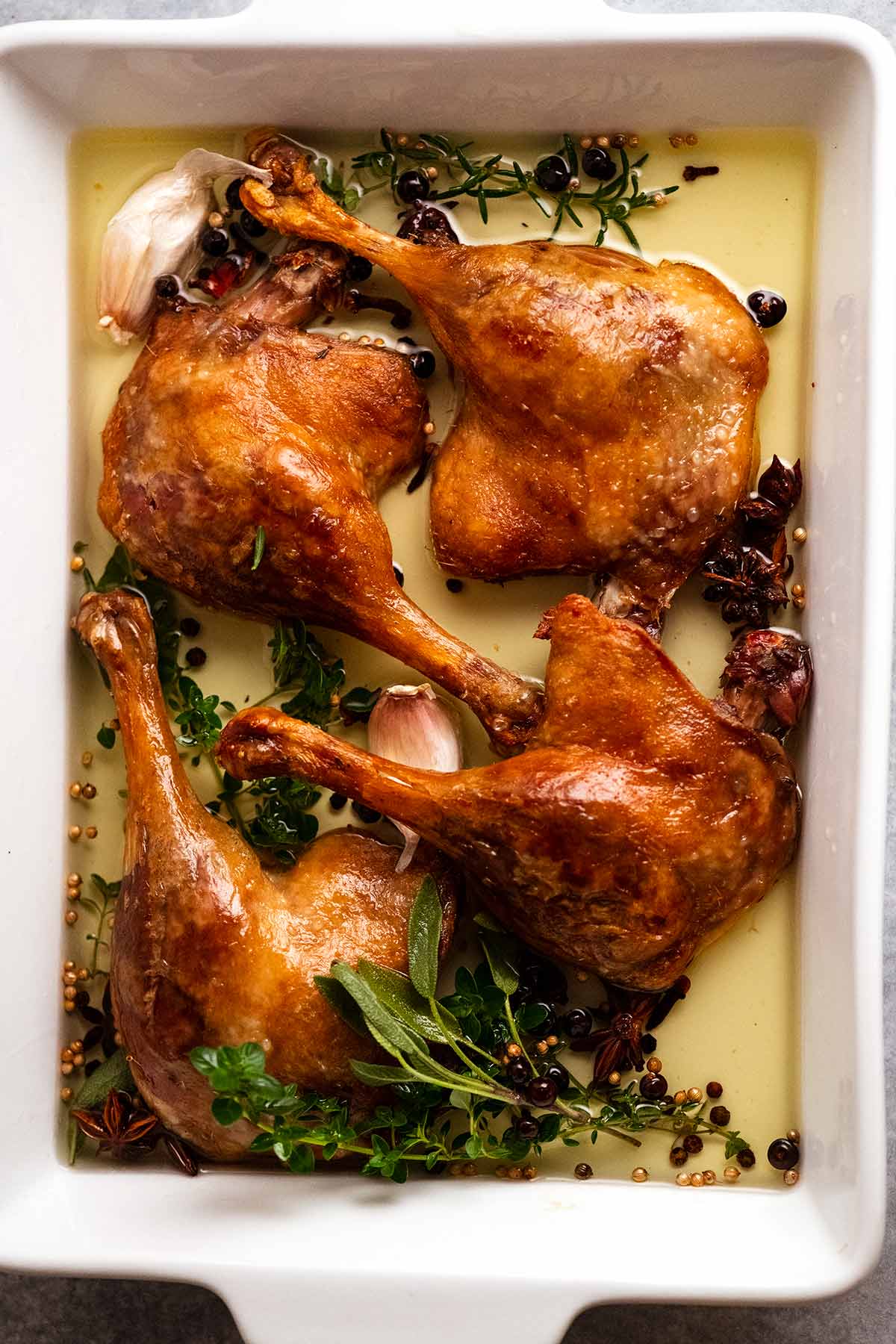
🇫🇷 Welcome back to French Bistro Week! 🇫🇷
From time to time, I like to dedicate a week of recipes to a theme. This week, it’s French Bistro Week!!
Following Monday’s French Goat’s Cheese Salad starter, I present today’s Duck Confit as the scrumptious main. As for Friday? Lemon Tart – the perfect French dessert ending to this menu! We’ll round out the week with an incredible French dessert, of course!!
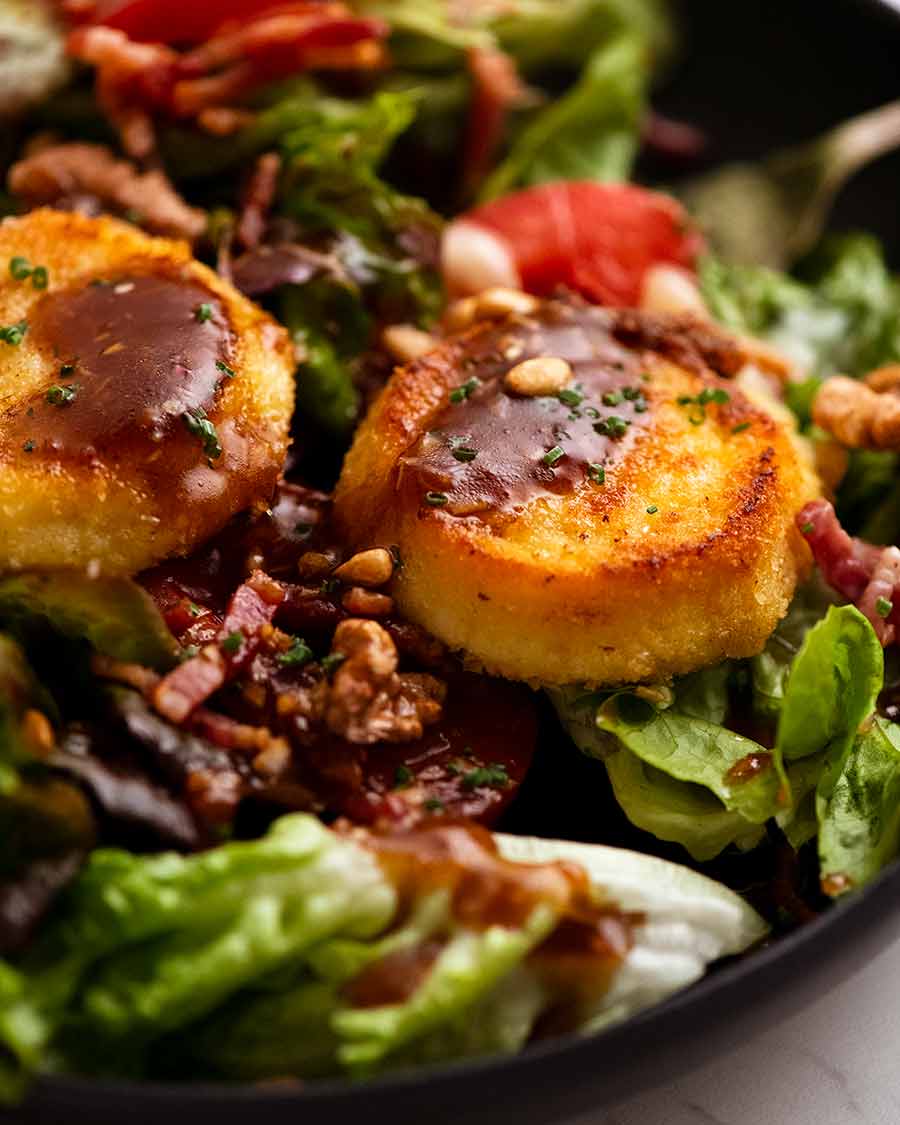
Duck Confit
Called Confit de Canard in French, Duck Confit is an elegant and classic French bistro dish. Confit (pronounced kon-FEE ) here refers to the method of slow-cooking the duck in its fat, yielding gorgeously tender meat. The legs are then briefly sizzled in a hot pan or oven until the paper-thin skin is wonderfully crisp.
Confit traditionally was done for preservation purposes, allowing the duck to be stored for long periods. This still has benefits today because it means we can easily make Duck Confit ahead of time and keep it for use whenever the fancy takes us!
This recipe for Duck Confit comes to you by way of a stellar French chef I work with, Jean-Baptiste Alexandre . And for me it’s a game-changer . Why? For one, the method is incredibly simple. It’s more forgiving and less messy than even a roast chicken , and far less graft than, say, fried chicken !
But the real clincher is this: Unlike most Duck Confit recipes, this one DOESN’T require litres of duck fat! By arranging the legs snugly for cooking, you need far less fat than you think – at most a few cups – which can be re-used or stored for months.
Easy and delicious. Efficient and ideal for making ahead. Indulgent and classy. I’m running out of boxes to tick here! If you’ve always wanted to try your hand at Duck Confit, now is the time!
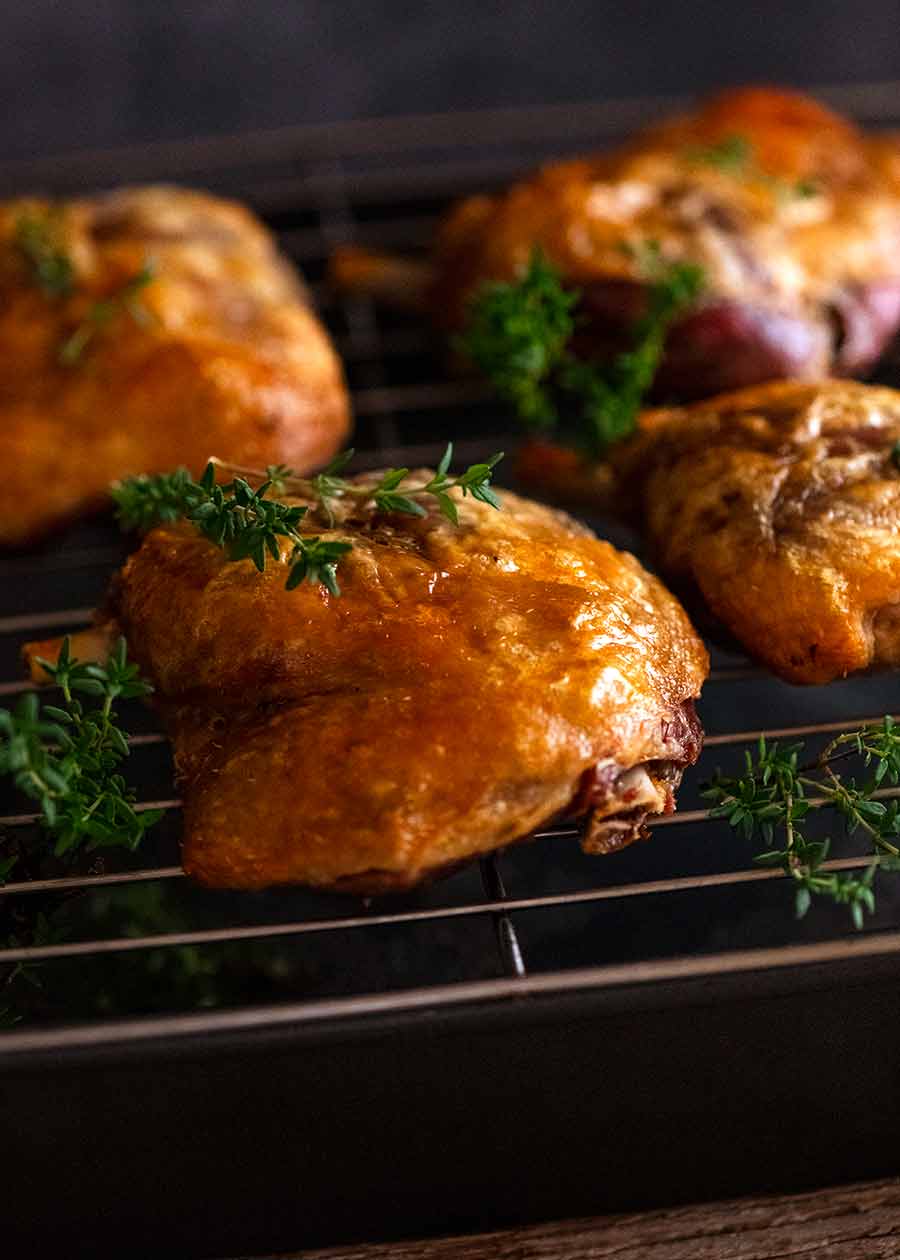
What Duck Confit tastes like
An initial overnight cure ensures our duck legs are seasoned with all the way through, the meat delicately perfumed with the herbs, spices and garlic.
Next, slow-cooking the legs under duck fat softens the meat until it is tender, silky, and just melting in the mouth. Residual melted duck fat clinging to the meat reinforces the rich duck flavour, while setting things up for the last step.
A final blast in the oven is all that’s needed for that excess cooking fat to sizzle and crisp up the skin. Result? Delicious, paper-thin duck skin that crackles as you cut through it with a knife into the dark, velvety flesh beneath … oh my!! 🤤
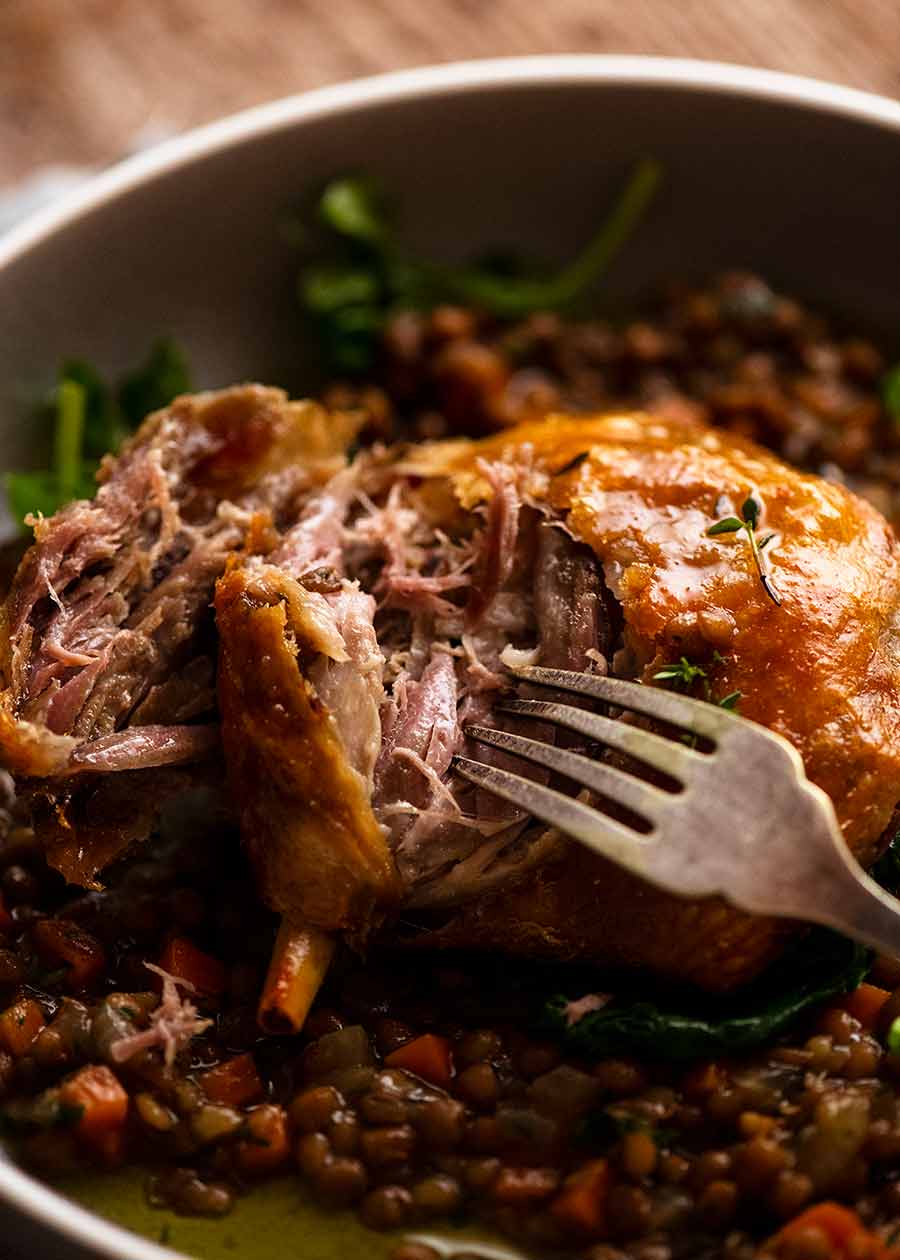
What does confit mean?
The word “confit” in French means “to preserve”. It can apply to different foods, including fruit and vegetables.
In the case of meat it refers to the technique of first curing then slow-cooking meat under fat at a low temperature. The meat can then be stored under the cooking fat for long periods, free from spoilage. It just so happens that this technique also yields impossibly tender, delicious and flavourful meat that gets better the longer it’s stored! Those clever French …
Historically, this preservation technique was a necessity to survive times of scarcity. Today, it means we can enjoy produce at its best (even when out of season) and have luxurious preserved foods at our disposal.
Duck Confit, originating from the south-western region of France, is one of the most classic and well-known confit foods.
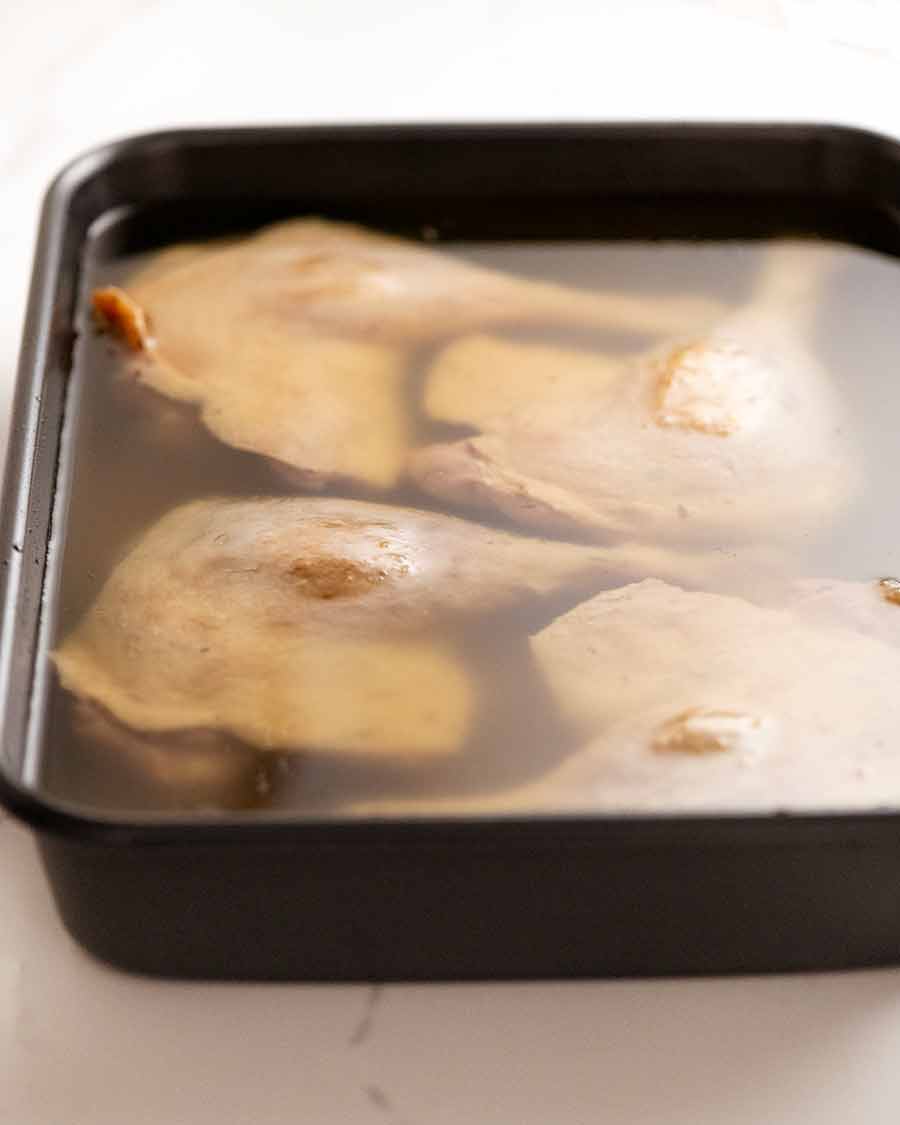
Duck cut used for Duck Confit
The cut of duck used for Duck Confit are duck legs . It is the lower leg plus the thigh attached, a poultry cut known as a maryland here in Australia.
It must be bone-in and with the skin on. Because it ain’t Duck Confit without crispy skin!
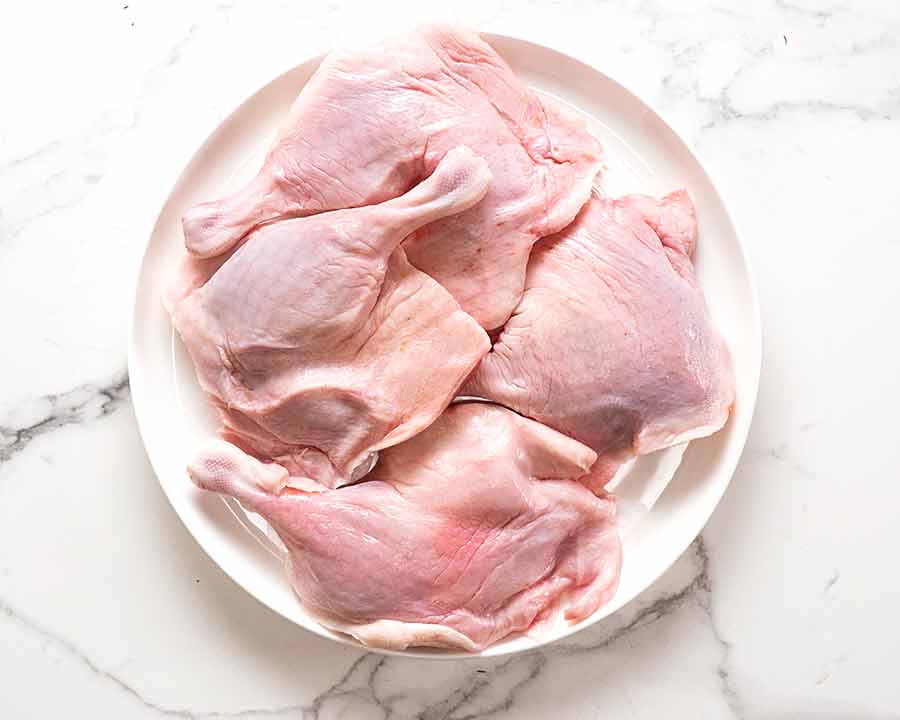
Duck fat to cook Duck Confit
To confit meat means to slow cook in fat, usually the meat’s own fat. So for Duck Confit we use duck fat. These days, you’ll find duck fat sold in jars in the pantry aisle of grocery stores alongside other oils. While these products were considered very “gourmet” 10 years ago with hefty price tags to match, these days they are much better value and easier to find. The fat can be re-used multiple times and will keep sealed in the freezer for 6 months or longer.
Technically any fat or oil can be used to confit a meat. However in traditional French cuisine it’s most typical to use the same animal fat as from the meat you’re cooking. The reason is partly historical: if you’re a farmer who has just harvested a bunch of ducks and plan to preserve some, you’ll likely have plenty of duck fat lying around too. The other reason is the flavours are more naturally more harmonious.
Here’s one brand of duck fat that’s sold at grocery stores in Australia:
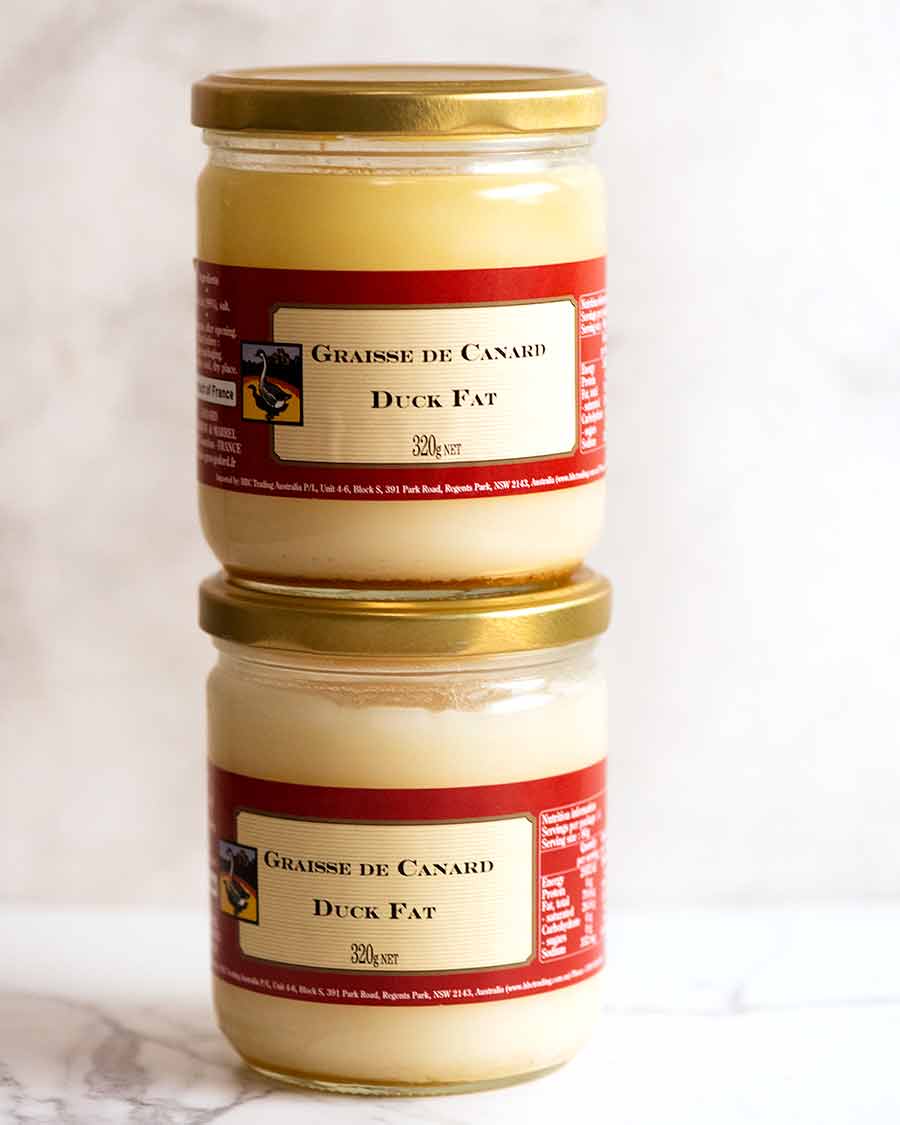
How much duck fat you need
You will need between 600 – 800g / 21 – 28 oz of duck fat. You need enough fat to cover the legs so they are fully submerged for slow roasting (see photos in post / video). So the exact amount you need depends on the size of the duck legs and your roasting pan.
We minimise the amount of duck fat required by using a small roasting pan that the duck fits in snugly. While you can count on some fat being released by the duck itself during the slow roasting time, it doesn’t actually raise the fat levels.
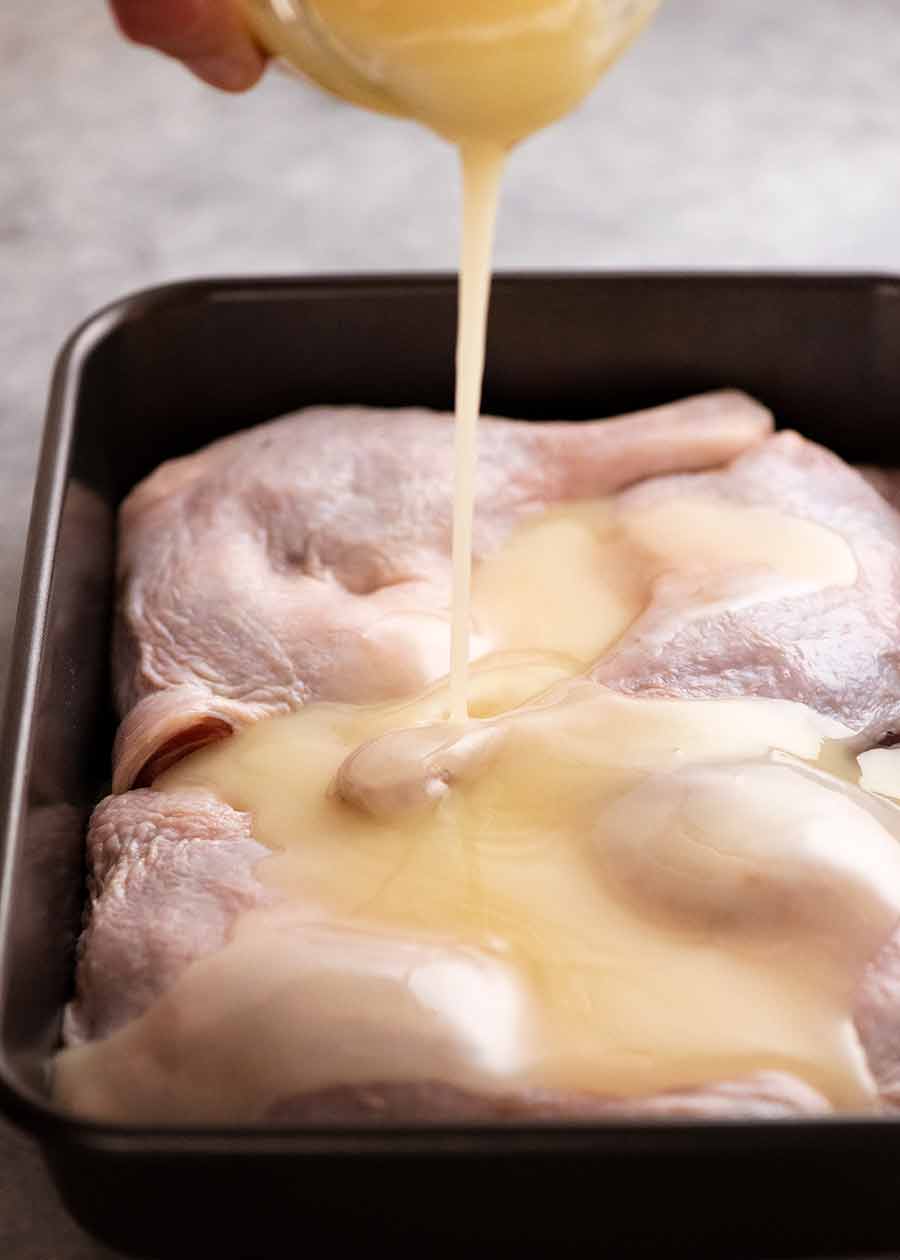
Dry cure for Duck Confit
One of the key characteristics of Duck Confit is the incredible, subtle but complex perfume of herbs and spices that is infused all the way through the duck. We use a lot of the stuff. A lot!!
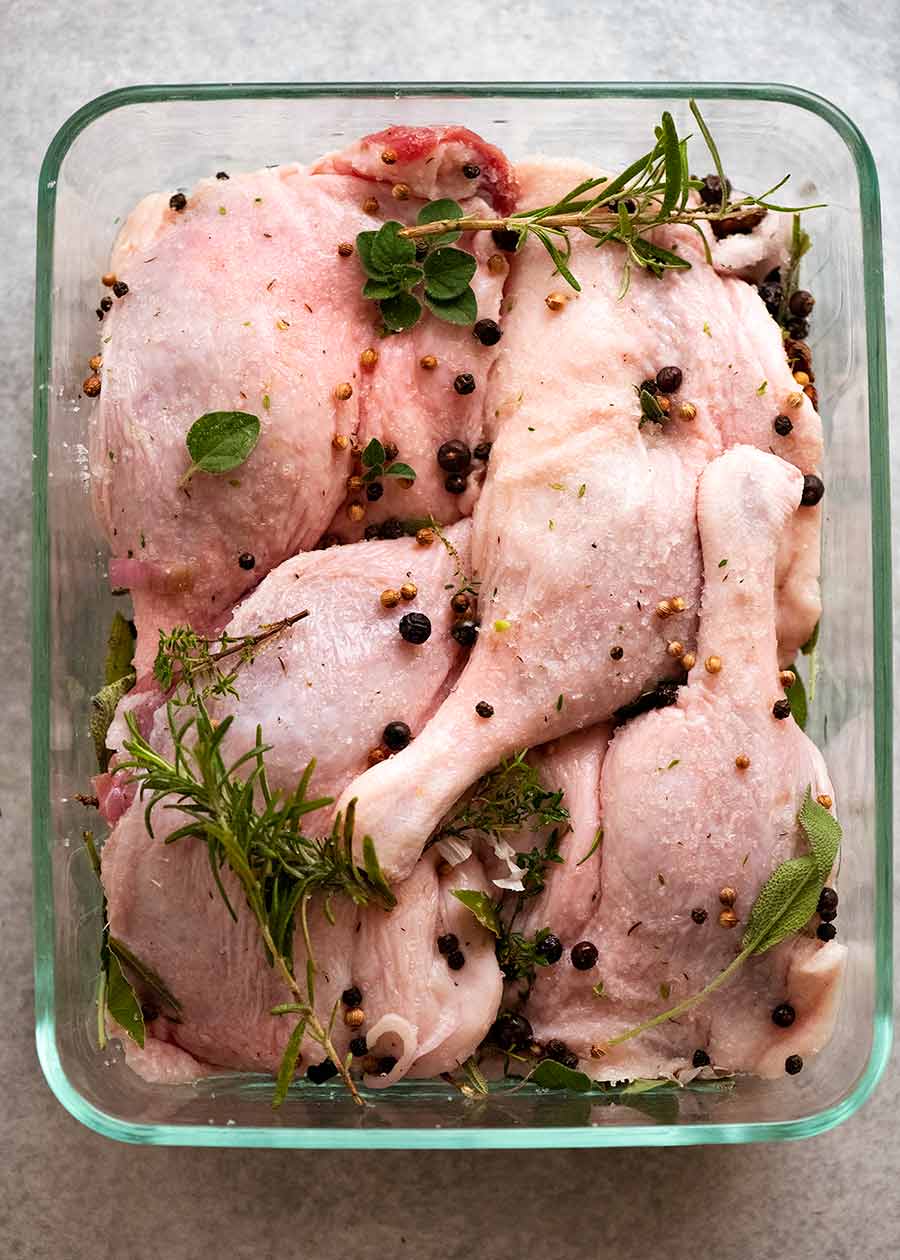
Fresh herbs – Thyme, sage, rosemary, oregano and bay leaves. Do not underestimate the power of these fresh herbs!
Dried herb substitute: If you are missing one of these herbs, use about 1 tsp of the dried herb equivalent. Try to avoid substituting more than one of the fresh herbs with dried because it’s not quite the same. However, in and emergency, yes I would use dried herbs for all and yes it will still be fabulous!
Garlic – Smash the garlic clove with the side of a knife to make the clove burst open but still mostly remain in one piece. This releases the flavour of the garlic to subtly infuse the duck with garlic whilst making it easy to pick out later;
Eschalots – Also known as French onions, these are called “shallots” in the US. They look like baby onions, but have purple-skinned flesh, are finer and sweeter. Not to be confused with what some people in Australia call “shallots” ie the long green onions; and
Spices – Whole black peppercorns, coriander seeds, star anise, juniper berries and cloves (whole).
How to make Duck Confit
Are you ready to be shocked how incredibly easy it is to make Duck Confit? Oui? Here we go!
Here’s an overview of the steps. I’m providing more visuals than usual because I suspect this is not an everyday recipe for most people. But I promise it’s straightforward!
Cure duck for 12 – 24 hours in a dry cure of salt, herbs and spices;
Submerge in duck fat, cook in oven for 8 hours at a very low temperature. We use a small pan to minimise the amount of duck fat required, and I usually slow cook overnight;
Crisp skin in a hot oven, using a rack set over a pan of boiling water to keep the flesh on the underside moist. This is a far more effective and easier method than the usual pan-frying or broiling/grilling called for in most recipes.
Part 1: Dry-cure duck
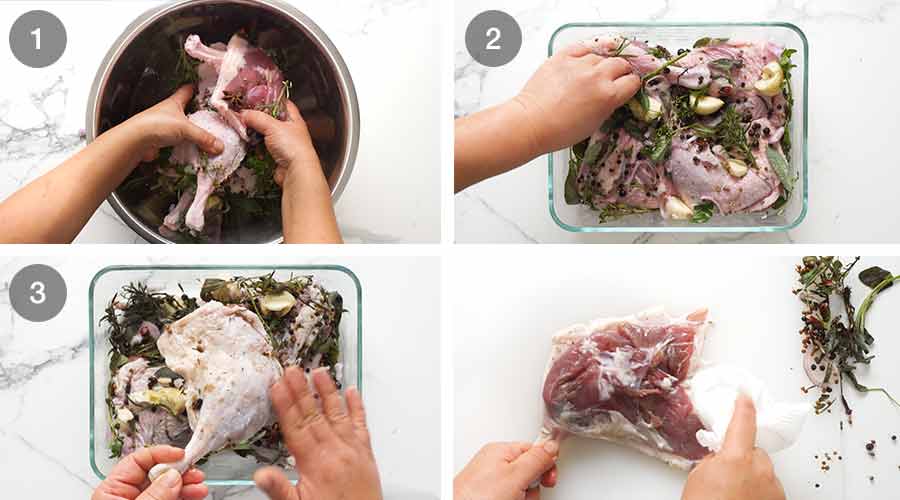
Coat duck with salt, herbs and spices: Place duck legs and all the curing ingredients in a large bowl and toss well with your hands.
Cure 12 -24 hrs: Transfer to a ceramic or glass dish large enough so the duck legs fit in a single layer but snugly, so they are cosied up with all those herbs and spices. Cover and refrigerate for 12 – 24 hours (no longer is necessary).
Rinse: Brush off the cure. Rinse duck under tap water to clean them, removing all salt and other bits. Pat dry with paper towels.
Part 2: Prepare for cooking
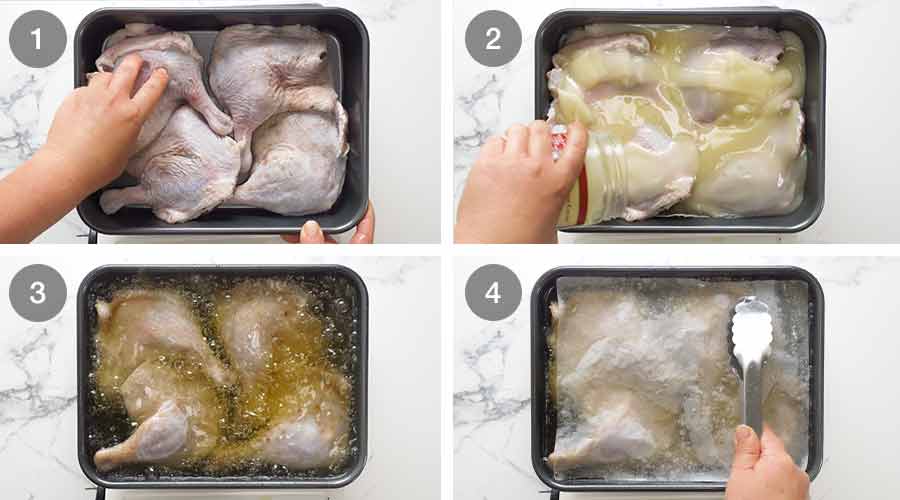
Place duck in a snug roasting pan: Place duck in a small metal roasting pan with high sides in which they fit snugly, touching each other, but in a single layer. The pan I use is 27cm x 21cm (10.5″ x 8″);
You need a pan with high sides so hot duck fat doesn’t slosh out when you handle it – hot fat and hands don’t mix! It’s best if it’s a metal roasting pan so you can put it straight on the stove to kickstart the fat heating step (step 3 below);
Cover with duck fat: Pour fat over duck legs. You need enough so they are virtually fully submerged. A little bit of the skin or bone above the surface is fine because the duck will shrink under as it cooks. The main aim here is to ensure the flesh is fully submerged;
Heat fat: Place the pan directly on the stove over medium-high heat until the fat is bubbling energetically across the whole surface (ie not just around the edges);
Cover with paper: Turn the stove off. Cover the duck with baking/parchment paper cut to size so it sits flat on the oil surface. Press it gently down to remove air bubbles.
This paper lid is a cooking technique similar to a cartouche which is used to trap heat and keep foods submerged during braising or confit like this.
Cover the pan tightly with a double layer of foil. Now you’re ready for slow roasting!
Part 3: Slow-cooking (confit)
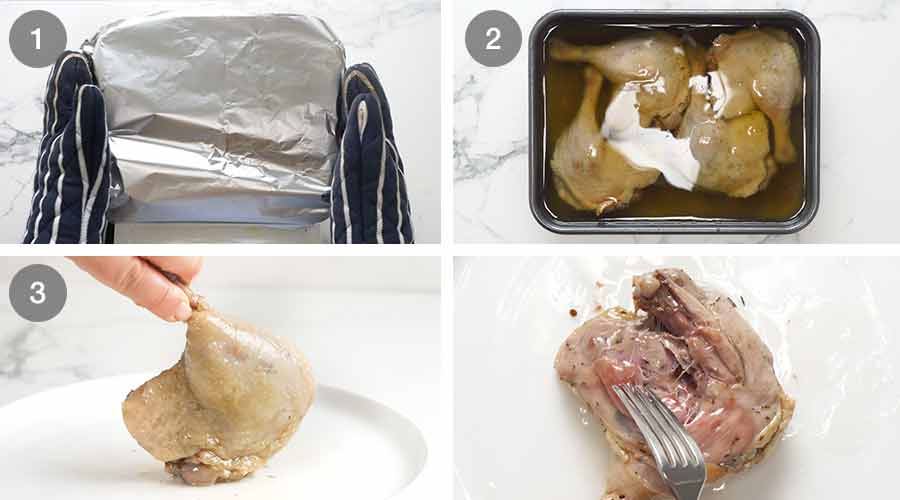
Slow-cook: Carefully transfer to the oven. (Be very careful! Hot duck fat is dangerous!) Slow-cook for 8 hours at 100°C / 210°F (80°C fan). I typically do this overnight. In an oven this low, I feel perfectly safe snoozing away!
Remove from oven: This is what it looks like when it comes out of the oven. It will look totally unimpressive with pale and flabby skin. But just wait! The best is yet to come!
Check flesh is cooked: By this stage, the duck flesh should be ultra-tender and “fall apart at a touch” but still attached to the bone. There’s two ways to check:
Method 1 – Turn the leg over to check the exposed flesh side. Use a fork to check if the flesh flakes easily (it’s tempting to remove a chunk and pop it in your mouth, I know – resist!); Method 2 – Bend the duck leg gently on a plate. It should bend easily when pressure is applied on the joint (see video).
Meat done, at this stage the duck can either be crisped up in the oven to serve straight away, or stored in the fridge / freezer still submerged in fat. Therein lies the beauty of Duck Confit – you can have this amazing dish sitting around ready to impress the pants off some lucky person at the drop of a hat!
Part 4: Long term storage (optional)
Here’s how to store the duck in the fridge (5 days) or freezer (3 months or more) if you are planning to keep it to serve at a later date.
Those of you familiar with Duck Confit might be thinking, “But isn’t the whole point of confit that you can keep the meat sealed under fat just the fridge for weeks or even months, and it will be good to eat?” The answer is yes, traditionally Duck Confit would be stored long-term in just a cool place. In 99.99% of cases it will keep perfectly like this. If you’re comfortable doing this, you can. However out of an (over) abundance of caution I recommend keeping in the fridge no longer than regular food, and freezer for any duration past this.
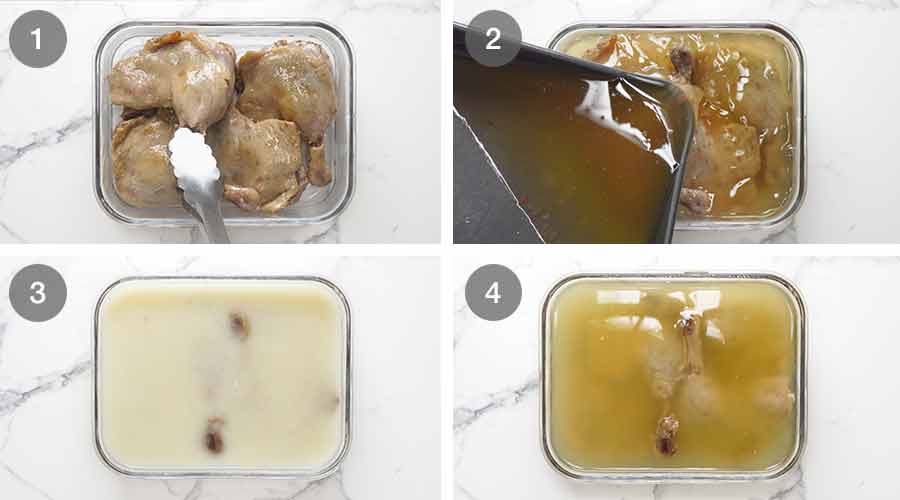
Cover with duck fat: While the duck is still warm, remove from the roasting pan into a non-reactive container in which they fit snugly. They can be stacked or in a single layer, just as long as the duck fat covers the duck completely. Do this while the duck is still warm as they are pliable so you can arrange them in the most space-efficient manner.
Strain duck fat: Strain the duck fat into a jug, then leave it for a bit to let the duck juices settle at the bottom. Then pour the duck fat over the duck legs, leaving behind most of the duck juice;
Cover and freeze: Once fully cool, cover with a lid and place in fridge (5 days) or freezer (3 months). The fat will solidify and turn white. If you are comfortable, you can keep just in the fridge for at least several months, as is traditional!;
To cook: If the duck was frozen, thaw it overnight in the fridge. Then heat duck gently in the microwave to melt the fat so the duck can be removed. Proceed with the recipe to crisp up the skin and reheat the duck.
Part 5: Crisping skin and finishing the Duck Confit
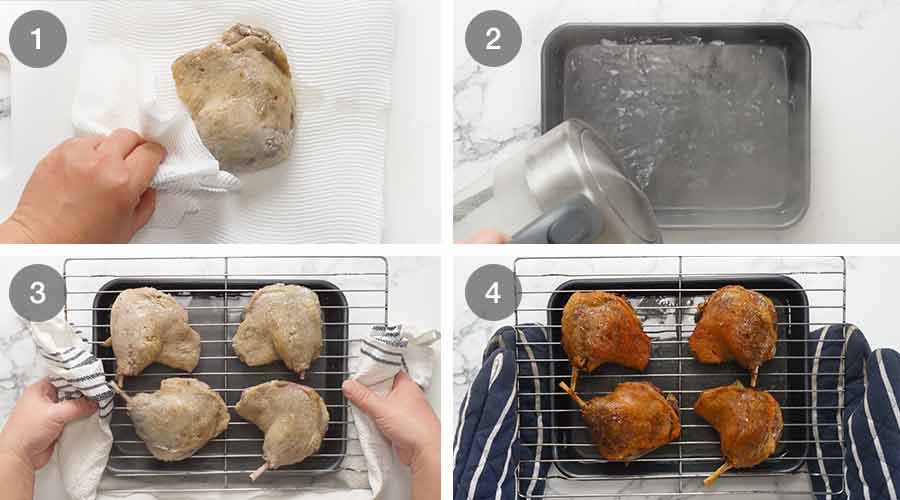
Prepare for roasting: Remove duck from fat, allowing excess to drip off. Dab excess fat off with paper towels;
Skin crisping: Pour 2.5cm / 1″ boiling water water into a roasting pan, then set a rack over the pan. Place the duck on the rack, skin side up.
The water keeps the flesh of the duck ultra moist whilst allowing the skin to crisp up beautifully. This method of crisping up the skin works far better than the stove-searing methods that other recipes use. It gives the most even colour and, more importantly, crispy skin all over! In contrast, although faster, pan searing will only crisp the skin where the skin is in contact with the pan;
Crisp skin: Roast duck for 40 minutes in a hot oven (240°C / 465°F (220°C fan)) until the skin is a deep golden colour and crispy. Rotate the pan as needed to make the colour even all over. You won’t have problems with smoke because the fat will drip down into the water; and
Serve straight away while the skin is at it’s crispiest best! There is no need to rest duck because the meat is already cooked. In fact, the skin loses crispiness if it’s sitting around.
Crispy skin…..
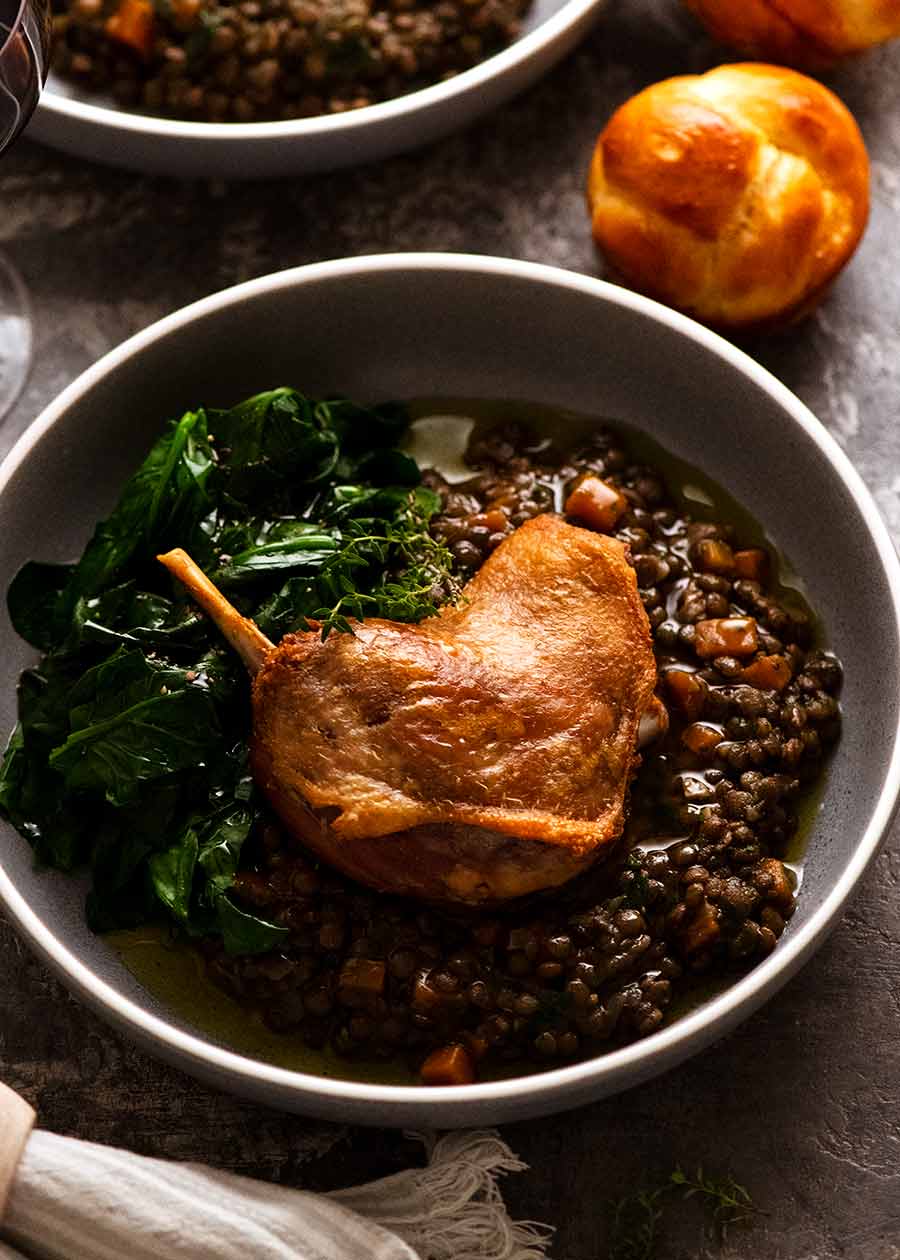
… and tender, flavour-infused flesh. It’s that magical combination hits my carnivore sweet spot every single time! 😉
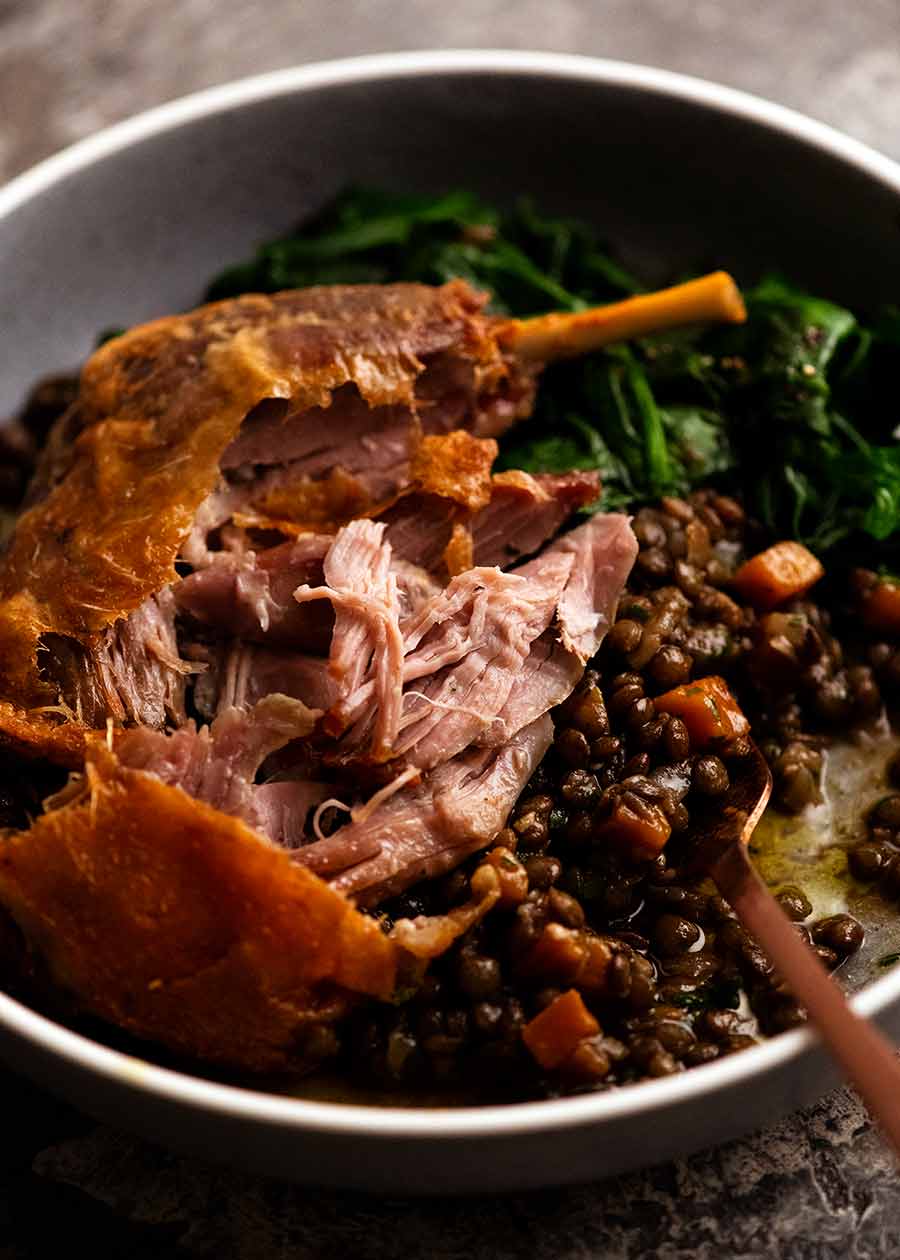
How to serve Duck Confit
The most traditional way Duck Confit is served in France is on a bed of lentils. The earthy lentils are a perfect match for the rich and gamey duck. This is a French Lentil Ragout – yes that’s right, I said a ragout! It’s mouthwateringly good, and a worthy serving companion to Duck Confit.
Add a bowl of leafy greens tossed lightly with a French Dressing , and voila! You’ll feel just like you’re in a cosy bistro or a bustling brasserie tucked in the back streets of Paris! – Nagi x
PS. Dessert is coming on Friday. 😇
Watch how to make it
Hungry for more? Subscribe to my newsletter and follow along on Facebook , Pinterest and Instagram for all of the latest updates.
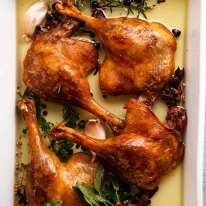
Duck Confit – French slow roasted duck legs
Ingredients.
- ▢ 4 x 250g / 8oz duck legs , skin on, bone in (aka maryland); (Note 1)
- ▢ 750 ml / 25 oz duck fat (Note 2)
Dry cure (Note 3):
- ▢ 4 tsp cooking/kosher salt (Note 4)
- ▢ 1/3 cup thyme sprigs , lightly packed
- ▢ 1/3 cup sage sprigs , lightly packed
- ▢ 1/3 cup rosemary sprigs , lightly packed
- ▢ 1/3 cup oregano sprigs , lightly packed
- ▢ 6 cloves garlic , smashed with skin on
- ▢ 1 eschalot (US: shallot), peeled and sliced 0.7cm (1/3") thick
- ▢ 1 tbsp black peppercorns
- ▢ 1 tbsp coriander seeds
- ▢ 8 star anise
- ▢ 2 bay leaves
- ▢ 2 tbsp juniper berries
- ▢ 8 cloves
Instructions
- Coat duck with dry cure: Place duck legs and all the Dry Cure ingredients in a large bowl. Toss well with your hands.
- Cure 12 – 24 hrs: Transfer to a ceramic or glass dish large enough so the duck fits in a single layer but snugly. Cover and refrigerate for 12 – 24 hours (no longer is necessary).
- Rinse: Brush off cure and rinse duck under tap water to clean them (remove all salt and black bits). Pat dry with paper towels.
Slow cooking (confit):
- Preheat oven to 100°C/210°F (80°C fan) with a shelf positioned in the middle of the oven.
- Roasting pan: Place duck in a small metal roasting pan with high sides. They should fit snugly, touching each other, but in a single layer. (Note 5)
- Cover with duck fat: Pour fat over duck. It should pretty much cover the legs. (Note 6)
- Heat fat in pan: Place pan on the stove over medium-high heat. Heat fat until bubbling energetically all across the surface (ie not just around the edges).
- Cover with paper: Turn off stove. Cover surface with baking / parchment paper, cut to size so it sits on the surface of the fat over the duck. Gently push down to remove air bubbles. Cover pan tightly with a double layer of foil.
- Slow cook: Carefully transfer to the oven. Cook for 8 hours.
- Check flesh : Remove one duck leg (gently). Turn over to check the flesh side – meat should be fall-apart tender. Leg should also give easily when pressure is applied to the joint (see video).
Storing cooked Duck Confit (optional):
- Duck can be stored submerged in fat at this stage. The meat juice should be strained off first.
- Remove duck to a non-reactive container in which they fit snugly. (Note 7) Pour over cooled duck fat, leaving juice sediment behind. Ensure it fully covers the duck (push duck under while warm and pliable as needed, using tongs).
- Once fully cool, cover with lid and place in fridge (5 days) or freezer (3 months). Fat will solidify.
- To cook, heat duck gently in a container in microwave to melt the fat. Proceed with recipe.
Crisping skin and finishing Duck:
- Preheat oven to 240°C/465°F (220°C fan). Place a rack over a deep roasting pan.
- Remove duck from fat: Remove duck from fat, allowing excess oil to drip off. Pat excess oil off with paper towels.
- Prepare for roasting: Pour 2.5cm / 1" of boiling water water into the roasting pan (steam keeps flesh moist). Place duck on rack, skin side up.
- Crisp skin: Roast duck for 40 minutes until the skin is a deep golden and crispy. Rotate pan as needed for even colour. (You won't have problems with fat smoking as it drips into the water)
- Serve: Rest briefly to cool, and serve! A classic French side dish for Duck Confit is Lentil Ragout . (pictured in post)
Recipe Notes:
- Fresh herbs measurement – Use sprigs and lightly pack them into cup measures. Use ingredient photos in post and the recipe video for visual guide, or weights provided in recipe.
- Smashed garlic – Place side of large knife on garlic then use the heel of your hand to bash the side of the knife once, making the garlic burst open but mostly hold together.
- Eschalots –Also known as French onions, and called “shallots” in the US. They look like baby onions, but have purple-skinned flesh, are finer and sweeter. Not to be confused with what some people in Australia call “shallots” ie the long green onions.
Nutrition Information:
More fancy french food.
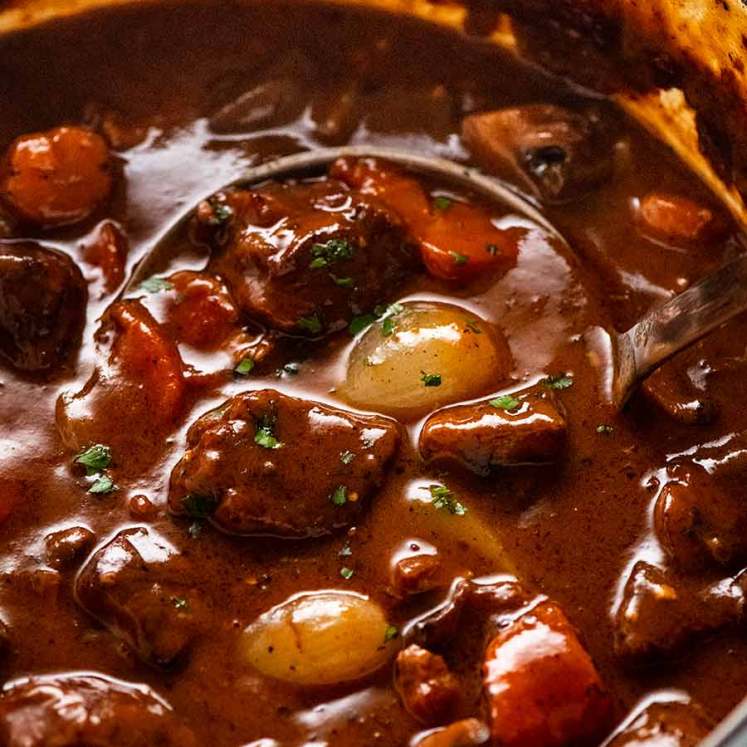
Life of Dozer
Moving into a temporary rental while my house is undergoing renovations!! It’s a short term furnished rental luckily, so I just had to move personals in….and all my kitchen gear, of course!
This is pretty much what Dozer spent the whole moving day doing. (ie Bugger all)
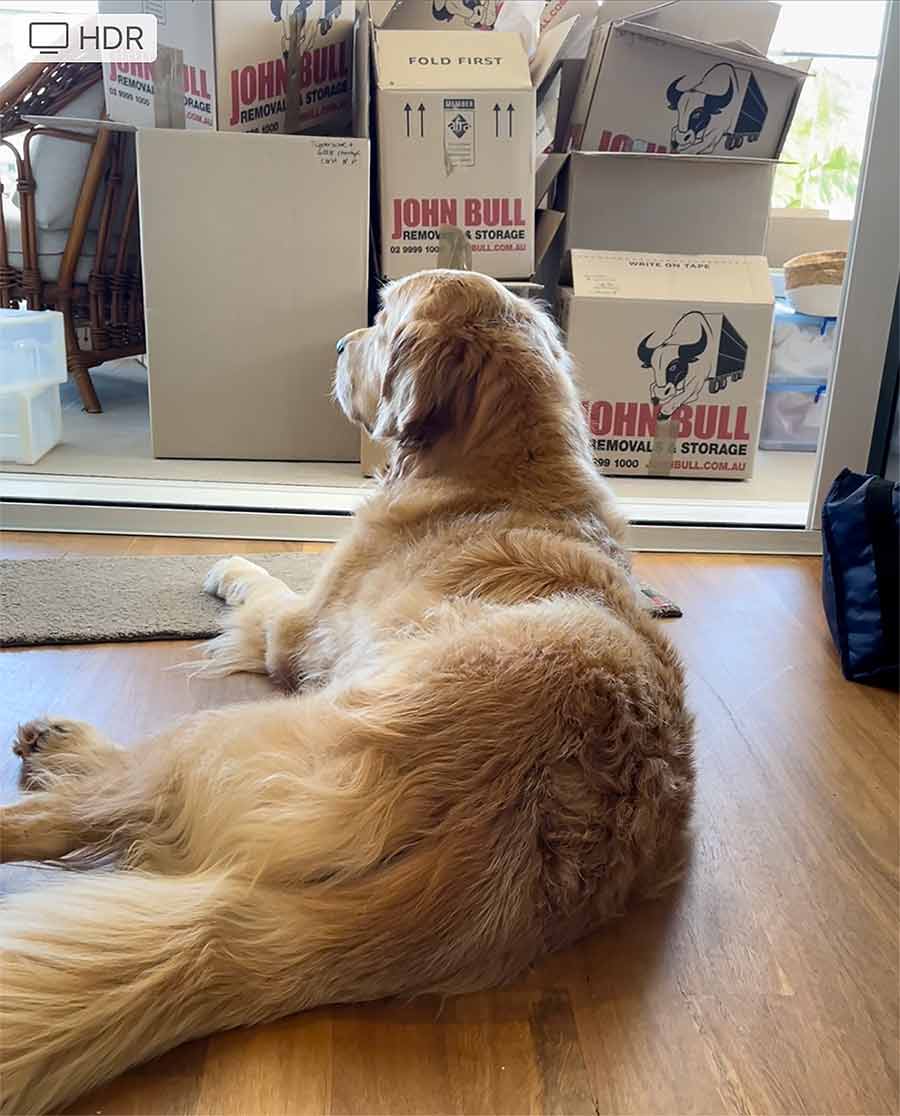
Hi, I'm Nagi !
I believe you can make great food with everyday ingredients even if you’re short on time and cost conscious. You just need to cook clever and get creative!
Free Recipe eBooks
Join my free email list to receive THREE free cookbooks!
Related Posts
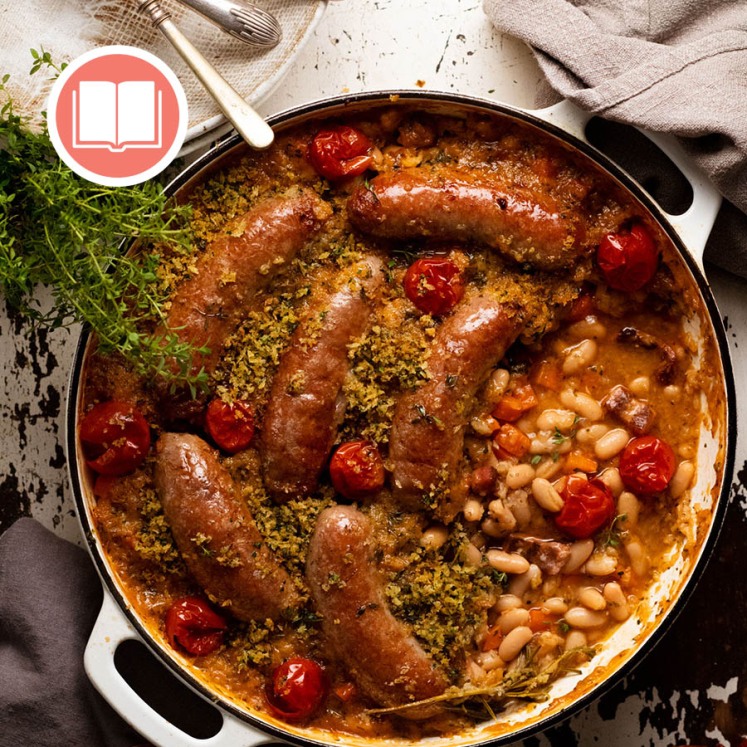
French Sausage & Bean Casserole
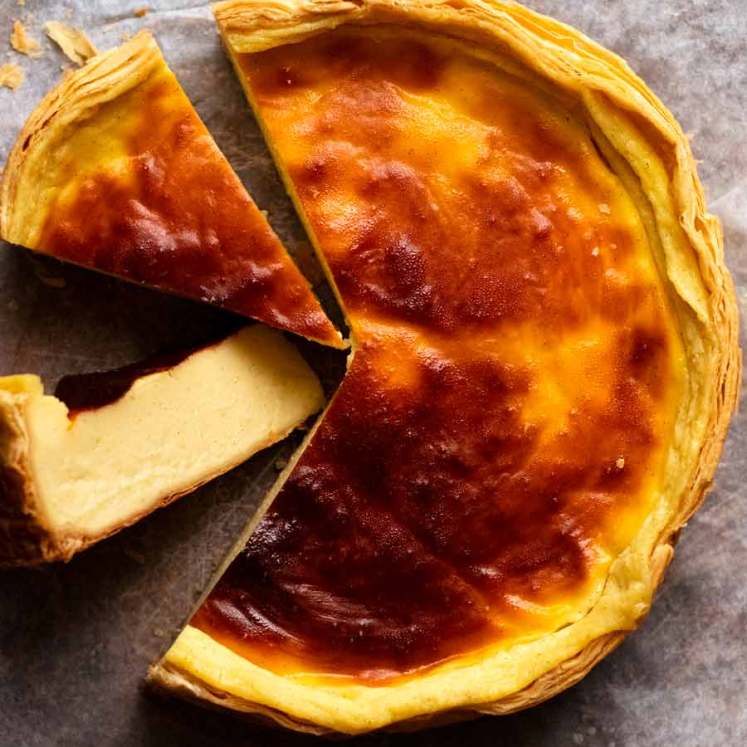
Flan Pâtissier (French Custard Tart)
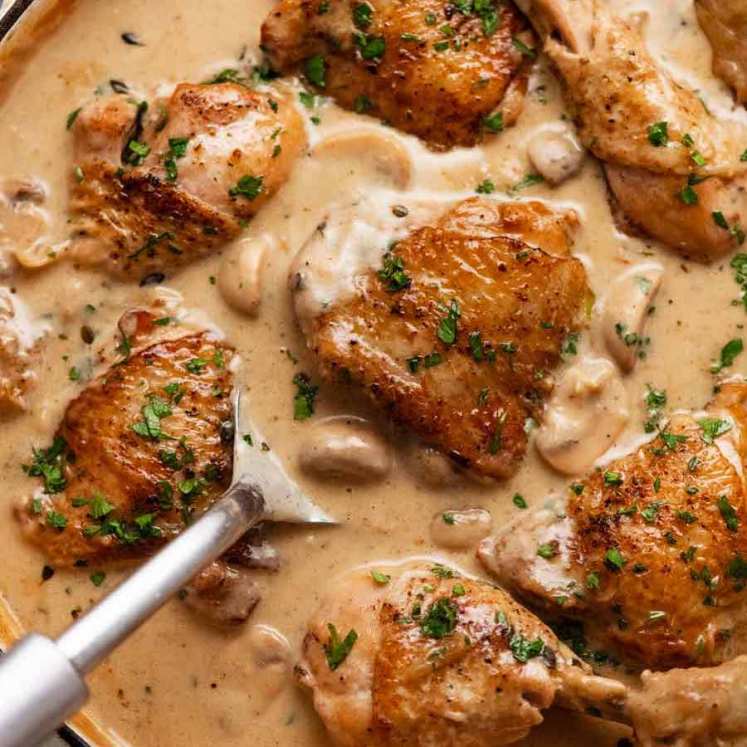
Chicken Fricassée (quick French chicken stew)
Reader interactions, leave a comment cancel reply.
Your email address will not be published. Required fields are marked *
Notify me via e-mail if anyone answers my comment.
70 Comments
January 16, 2024 at 10:46 am
Did the Confit duck may be my oven doesn’t go down to 100C anyway it disintegrated so going to add it to Cassoulet
January 9, 2024 at 2:08 am
Your posts take a little more reading effort than most Internet recipes, but what I love is that you go into detail and engage your audience in sharing your love of these classic creations. Any recipe book that doesn’t share the history and traditions of the recipe isn’t worth learning from. It isn’t just food, but its cultural significance and value that’s important. I’m looking forward to reading many more of your posts. Thank you for sharing.
January 6, 2024 at 4:13 am
December 15, 2023 at 3:49 am
P.S. I serve this with the duck fat potato recipe you posted and an arugula salad with grilled seasonal fruit (my own creation). It’s so lovely. Thank you again!
September 7, 2023 at 3:23 pm
September 19, 2023 at 1:02 pm
August 8, 2023 at 3:18 pm
Hi. I couldn’t find duck fat. Is it possible to use something else? Or maybe you could recommend other dish that is suitable for French bistro dinner? Because I like the salad and lentil ragout, the tart is also perfect.
July 21, 2023 at 10:50 pm
May 29, 2023 at 10:49 pm
This sounds like a great dish. I love confit duck. However, I confess that these days I use the sous vide for confit duck. You don’t need additional fat as enough comes out of the duck. So you just add aromatics and seasoning, vac pack each leg individually and sous vide for 36 hours at 68C. Perfect every time and you can leave in the fridge for a week, serve immediately or chuck straight in the freezer in the vacuum bag.
December 22, 2022 at 1:05 am
November 22, 2022 at 6:02 am
Hello, I love this recipe. I tried it and it was AWESOME. My Wife loved it. I was wondering if you felt that the same cure could be used on a turkey? I would love to try this for the underlying flavors in a deep fried turkey. A different spin from Cajun. Thank you for the many recipes I’ve used. Loved them All!!!!!
July 30, 2022 at 4:36 pm
February 27, 2022 at 7:33 am
February 2, 2022 at 5:43 am
Hi Nagi, I see that some people will grind all the herbs together in a food processor, and then rub it over the duck for curing. Would you recommend this method or do you think just curing with whole herbs is fine?
January 18, 2022 at 10:16 pm
Hi Nagi! Love your recipes! Hoping to make this dish for a small upcoming dinner gathering. Some of the diners (kids) haven’t had duck before so I thought I might also do this with some chicken (i.e. mostly duck Maryland cuts, but a couple of chicken Maryland cuts for the uninitiated/disinterested guests). Would this recipe work with chicken or would alterations be required? Assuming I can get similar-sized pieces of meat, could I cook the chicken and duck together in the same pan at the same time?
January 10, 2022 at 6:26 am
QUESTION: assuming I could utilize a clear Pyrex dish for this instead of a metal roasting pan – correct ? cannot wait to try this recipe, have all on hand to do so, thanks
December 27, 2021 at 12:18 pm
Made this for a bunch of duck aficionados recently. I was in over my head and had never cooked duck before. Terrified. I trusted my online guru Nagi and she came through for me again. ‘Best duck I’ve ever had in my life’ all around. I did the full 8 hours and blasted it the next day. I was so worried it was over-cooked (I don’t think that’s possible w/this dish but I was in panick-mode) but after that blast……omg…..cracklin skin and super tender & moist flesh. It was decadent. And very easy, if you plan accordingly. Nagi is a superchef!!! Thanks, Nags!!!
December 18, 2021 at 9:41 am
Each time you do this you get more duck fat. I refresh the duck fat by putting it in a pan with an inch of water and simmering for 10 minutes or so. This removes the salt and most of the spices. The fat keeps in the freezer for months
December 19, 2021 at 6:06 pm
Great tip Martin! N x
October 9, 2021 at 8:07 am
Hi Nagi! Is the storage for 5 days in fridge or 3 months in freezer done to enhance flavour or something? I wanted to make this for Sunday dinner so wanted to use straight away
August 30, 2021 at 5:17 am
August 20, 2021 at 10:39 am
After having duck confit from a French bistro I thought I’d try it at home – never cooked duck before so was taking a risk! Followed the recipe exactly and it was perfect. “Yours is better than the restaurant” was the call from the family! So worth the effort!
- Recipes By Course
- Mains By Ingredient
How to Make Classic Duck Confit (and Give It a Koji Twist)
The pros, the cons, and the how-to for classic and not-so-classic duck confit.
:max_bytes(150000):strip_icc():format(webp)/__opt__aboutcom__coeus__resources__content_migration__serious_eats__seriouseats.com__2018__10__Sasha-Marx-1-20164df56a2f4a24b350b527f295ad5c.jpg)
I'm not the type of cook who thinks traditional, time-consuming cooking techniques are inherently better than quicker modern ones. Got a better, simpler, more efficient way of doing things? I'm all in. I love learning new methods and approaches to food and always bristled at the "because that's the way it's done" reasoning used by a lot of chefs to dismiss questions from inquisitive cooks.
At the same time, there is value in having a solid grasp of fundamental culinary techniques. It's like learning to play an instrument (which I failed at miserably as an ADD kid precisely for this reason)—building from the basics allows you to more easily riff on them as you progress in your playing. Just as music teachers bemoan kids like me who want to play Nirvana in their first guitar lesson, I get texts all the time from chef friends complaining about young cooks in their kitchens who can recite passages from Modernist Cuisine but struggle to put together a simple, tasty dish for a family meal.
When mapping out plans for the Big Duck Project, I combed through the Serious Eats recipe archives to see what recipes had already been covered by the culinary team and noticed that while Daniel had developed an awesome recipe for sous vide duck confit , we didn't have a low-tech, classic duck confit recipe of our own.
Before we go any further, I'd like to state that I agree with Daniel that sous vide duck confit is excellent. It's one of the best applications for immersion circulator cooking and the most efficient confit method for home cooks, producing consistently silky, tender results with minimal effort. That said, there are some drawbacks to sous vide confit, and there's a case to be made for the traditional approach. Seeing as low-fi culinary fundamentals are already part of the Big Duck Project, with basic butchery , stock-making , and dry-aging , it only made sense to tackle classic confit as well (while also sneaking in a not-so-classic riff along the way).
I don't think one method is far superior to the other, so to help you make the call on whether to go with analog or digital confit, I am turning to the tried-and-true technique for hemming and hawing over issues: a pros and cons list.
The Pros of Traditional Duck Confit
So what does traditionally prepared duck confit have going for it, other than the fact that making it gives you the cred to throw some scornful Parisian side-eye at anyone who could be so gauche as to serve a winter cassoulet without it? Here are the highlights.
No Gadgets Required
This one is pretty obvious. The farmers of southwest France who first came up with the idea of extending the shelf-life of duck by cooking and preserving it in rendered fat certainly didn't have nifty, WiFi-enabled immersion circulators at their disposal. Plenty of people these days don't own a sous vide device either. If you fall into that camp, then old-school confit is your only real option.
Most people have an oven (and if you don't, you can cook confit on a stovetop), and an oven-safe vessel that can snugly fit a few duck legs submerged in fat. That's all the equipment needed for traditional confit. No apps or Bluetooth connections required.
Complex Flavor Exchange: Meat and Fat
Before cooking, classic confit recipes call for curing duck legs for a day or two with salt, spices, herbs, and often aromatics. The cure deeply seasons the meat, which then imparts flavor to the fat that it is cooked in.
Once the confit has finished cooking, the flavors of the confit and the fat that it's stored in continue to develop as the confit ages and "ripens," a process that preserved meat purists will argue is essential to duck confit.
With sous vide confit, that ripening flavor development isn't possible, as the duck legs are not cooked or stored in the amount of fat required for long-term preservation, which gives confit its name ("confit" is French for "preserved.") That's certainly not the end of the world; home cooks in the 21st century aren't generally looking to preserve meat in their fridge for months on end. But with sous vide confit, you do lose out on the flavor that the duck legs lend to the rendered fat they are cooked in, which can be reused for exponentially tastier batches of confit or to lend meaty richness to vegetables without having to spend money on meat.
Long-Term Storage
As mentioned above, the whole point of confit originally was preservation. The copious amount of rendered duck fat used in classic recipes is what allows the duck to keep for months and months without spoiling. The fat that the duck is submerged in forms a protective shield from air that would cause the meat to go bad.
Because the sous vide confit method doesn't use any additional duck fat (the only fat rendered comes from the duck legs as they cook), the long-term storage options of traditional confit don't apply. Sous vide confit is best enjoyed within a week of cooking. Classic confit can be stored in the refrigerator for at least a month and really a lot longer than that—I have a batch ripening right now in the test kitchen fridge that I made two months ago.
One side note on long-term preservation for duck confit. If you plan on storing it for longer than a couple of months, it's a good idea to procure some sodium nitrite, also known as "pink salt" (labeled "#1"), to add to the salt cure that gets sprinkled over the duck legs before cooking.
Sodium nitrite—which is used for meat-curing recipes that involve cooking, brining, smoking, or canning—inhibits the growth of harmful bacteria (which proliferate in anaerobic environments) that can cause botulism. For long-term storage safety, charcuterie expert Brian Polcyn recommends adding 1 teaspoon of pink salt to the cure for every 5 pounds of meat. For our purposes, that translates to a half-teaspoon (3 grams) of pink salt, as we are working with four duck legs that weigh in around 2 1/2 pounds. Along with preventing botulism, pink salt also preserves the rosy hue of meat, as you can see in the photo above. The duck legs on the left were cured with pink salt, while the ones on the right with kosher salt alone.
The Cons of Traditional Duck Confit
Not everything about traditionally cooked confit, whether cured with pink salt or not, is rosy. There are some drawbacks to preparing classic duck confit, and it's worth acknowledging them.
More Fat Needed
One of the most appealing things about sous vide duck confit is that it doesn't require any additional rendered duck fat; the fat that renders naturally from the duck legs during cooking is sufficient in the tight vacuum-sealed bag. Traditional confit requires a good amount of rendered fat to submerge the duck legs for cooking them. Because the legs need to be completely covered, the amount of fat required is dependent on the number of duck legs being cooked and the size and shape of the vessel they are to be cooked in.
I recently wrote about how to render the excess fat collected when breaking down whole ducks, but even if you start with that step, it may not produce enough rendered fat to make a decent-sized batch of duck confit. That means you will likely need to purchase a container of rendered duck fat along with the duck itself. Not a dealbreaker, but it is a bit of a nuisance.
More Hands-On and Space-Consuming
With a one-day precooking curing step followed by a low and slow turn in the oven, traditional confit takes more effort to make than sous vide confit, which simply involves combining the duck legs with seasonings in a vacuum-sealed bag and dropping them in a water bath for a set-it-and-forget-it period of 36 hours (just don't forget to cover the water bath to prevent the water level from dropping due to evaporation).
And when the confit has finished cooking, there's the space issue of storage. Sous vide confit has a pretty small footprint—it's not hard to fit a bag with four duck legs in your fridge. Traditional confit, on the other hand, takes up a lot more room, thanks to all that duck fat that's staving off spoilage. If you are tight on space, you might not love the idea of constantly bumping into a big crock of solidified duck fat every time you root around in the fridge.
How to Make Traditional and Koji Confit in the Oven
With the pros and cons of classic confit all laid out, let's go over the broad strokes for making it. Oh, and because sticking to the basics has never been my jam, I also riffed on the traditional method for a koji duck confit that is pretty ridiculous. If you took my recent advice and made a batch of shio koji , this is a great way to put it to use.
Step 1: Cure Duck Legs
Traditional confit starts with an overnight cure for the duck legs, which always involves salt to season them, and then usually includes spices and aromatics of some kind. For my classic version of confit, I season duck legs with kosher salt and then buzz up a simple mixture of alliums in a food processor.
This is a method that was used at a fine-dining restaurant that I cooked at in Boston. We would take shallot scraps from making Thai-style fried shallots along with onions, garlic, and whole sprigs of parsley, and pulse them until processed to a rough paste.
That allium paste gets spread into a non-reactive container, then thyme sprigs and peppercorns are sprinkled over top. The seasoned duck legs then are arranged on top of the paste, and that layering process is repeated so that the duck legs are covered with the mixture on all sides. The whole deal gets wrapped up and popped in the fridge to cure for at least a day and up to two.
The koji version I developed is even simpler, provided you have the shio koji ready to go. To maximize contact with the koji and not waste a ton of it in the process, I cure the legs in a zipper-lock bag, combining duck legs with a healthy coating of the koji marinade along with peppercorns and star anise pods. Due to the high salt content and enzymatic activity brought by the koji, the duck legs must be cured for no more than 24 hours, and they are good to go after just 12.
I tested with longer cure times and found that the texture of the duck legs began to suffer after two full days of curing. After three days, they were fully over-cured the legs, making them both too salty and too firm.
Step 2: Rinse and Dry Legs
Once the legs have cured, it's important to rinse and wipe off the cure before cooking. Leaving the cure on the legs will gunk up the duck fat and shorten its shelf-life; it can otherwise be saved and reused for multiple rounds of confit or other recipes. Rinsing off the cure also ensures that the meat and the fat it's cooked in don't end up overly salty.
Step 3: Melt Duck Fat, Submerge Legs
One of the funniest and scariest episodes from my restaurant-cooking days happened at the same restaurant where I picked up that allium cure technique.
The cook who was in charge of making confit at the time had to melt down duck fat for a batch of confit and decided to do that by placing a 12-quart plastic Cambro container of duck fat on a metal shelf situated over the French top range. He was in the weeds and forgot about the duck fat during prep until the bottom of the container melted and duck fat poured onto the flat-top range, igniting into an Apocalypse Now -esque wall of fire on the line. By some miracle, this didn't set off the fire-suppression system. But yeah, make sure to melt down duck fat in a heat-proof vessel.
When working with four duck legs, I like to use a 3-quart saucier, which is big enough to hold the legs in a single layer, but does so very snugly so that you don't need a ton of rendered fat to cover them.
Step 4: Cook Low and Slow in Oven
With the legs fully covered in melted fat, pop a lid or some foil over your cooking vessel and transfer it to a low oven (I developed the recipe cooking the legs at 225°F). Now it's a waiting game: the low-temperature cooking takes a while (3 1/2 hours), but you will be rewarded with silky, tender confit.
Here's what to look for when checking the legs for doneness. For both the classic and koji versions, the meat should offer very little resistance when poked with a paring knife, and it shouldn't take much effort at all to pull away pieces of meat.
As you can see, the natural sugars from the shio koji give the skin a darker hue than the allium cure. Another good indicator of doneness for duck confit is that the skin around the bottom of the drumstick will begin to contract and pull away from the bone.
As with good barbecue, the goal of a confit isn’t to cook the meat until it “falls off the bone.” Ideally, the meat will still have some chew to it; also, it should stay attached to the thigh and drumstick bones, otherwise it will be almost impossible to keep the leg meat intact as you reheat, crisp, and serve the duck leg.
Step 5: Cool and Refrigerate
Once the confit has finished cooking, give it time to cool to room temperature, keeping it in its cooking vessel fully submerged in fat. Pulling the duck legs out of the fat before they have had a chance to cool will cause them to dry out. You don't want to pop a steaming saucepan of duck fat into your fridge, which would raise the fridge's temperature, warming up the rest of the products in it. Just take the lid off the confit, and let it cool on your kitchen counter.
I recommend letting the confit hang out for at least one day before enjoying it, especially if you want to crisp up the skin for serving. When the confit is fresh out of the oven, the skin is very soft and fragile, and it will easily tear or slough off if you move it around too much. Just be patient. Keep the confit in the saucepan, cover it back up with a lid, pop it in the fridge, and let it sit for a day or two. Or forget about it for a month to truly ripen it. With this classic cooking method, time is on your side.
Get The Recipes:
- Traditional Duck Confit
- Koji Duck Confit
- Duck Guides
- Canning & Preserving
More Serious Eats Recipes
Easy Duck Confit
By Melissa Clark

The name of this recipe may seem laughable. Isn’t confit meant to be an arduous, messy, not-really-easy thing to make at home? Doesn’t it involve large quantities of hot liquid fat and even larger reserves of patience? Surely chefs have a trick to getting those duck legs to be so rich, so luxurious? This version is not traditional, and it is still a time investment for home cooks (the legs are cured for 24 hours, and then cooked for about 3 ½ hours more). But by allowing the duck legs to cook in their own rendered fat, rather than adding quarts of extra fat to the pan, you have a recipe that is far less of a pain to both prepare and clean up. And the method is truly simple, with results that are just as outrageously good. The duck lasts for at least 5 days in the refrigerator, and should be reheated in a 350-oven until warm. Then run the legs under the broiler until crisp.
Featured in: Duck Confit, and Hold the Fat
Log in or sign up to save this recipe.
- Give Subscriber benefit: give recipes to anyone As a subscriber, you have 10 gift recipes to give each month. Anyone can view them - even nonsubscribers. Learn more. Subscribe
Print Options
Include recipe photo
Advertisement
Ingredients
- 1½ teaspoons kosher salt
- 1 teaspoon freshly ground black pepper
- ½ teaspoon dried thyme
- 1 bay leaf, crumbled
- 8 moulard duck legs (about 4 pounds total), rinsed and patted dry but not trimmed
- Roasted potatoes, noodles or sturdy salad greens for serving
- Bitter salad greens such as arugula, chicory and/or radicchio, for serving
Nutritional analysis per serving (4 servings)
1905 calories; 178 grams fat; 60 grams saturated fat; 0 grams trans fat; 84 grams monounsaturated fat; 23 grams polyunsaturated fat; 11 grams carbohydrates; 2 grams dietary fiber; 0 grams sugars; 53 grams protein; 994 milligrams sodium
Note: The information shown is Edamam’s estimate based on available ingredients and preparation. It should not be considered a substitute for a professional nutritionist’s advice.

Preparation
In a small bowl, combine salt, pepper, thyme and bay leaf pieces. Sprinkle duck generously with mixture. Place duck legs in a pan in one layer. Cover tightly with plastic wrap and refrigerate for 24 hours.
The next day, heat oven to 325 degrees.Place duck legs, fat side down, in a large ovenproof skillet, with legs fitting snugly in a single layer (you may have to use two skillets or cook them in batches). Heat duck legs over medium-high heat until fat starts to render. When there is about ¼ inch of rendered fat in pan, about 20 minutes, flip duck legs, cover pan with foil, and place it in oven. If you have used two pans, transfer duck and fat to a roasting pan, cover with foil and place in oven.
Roast legs for 2 hours, then remove foil and continue roasting until duck is golden brown, about 1 hour more. Remove duck from fat; reserve fat for other uses.
Serve duck hot or warm, over roasted potatoes or noodles or sturdy salad greens.
Log in or sign up to rate this recipe.
Log in or sign up to mark this recipe as cooked.
Private Notes
Cooking notes.
Or, you can throw the duck legs and salt/spices in a crockpot for 6-8 hours. Take out the duck and strain the fat. When you want to eat the duck, brown it in a saute pan to desired doneness. You will have perfect confit, and lot's of duck fat to fry potatoes. Have you ever fried eggs in duck fat? Too delicious for words.
With these temperatures, you are for sure going to completely dry out any duck. Confit is a method called poeler, which happens at very low temperatures. There's no way this recipe will ever meet the standards of any french home cook...
This is one of my favorite recipes...with minor changes. I roast the duck for less time, probably 1 1/2 hours with the cover and a half hour without. I also add a tiny bit of honey to each duck leg 10 minutes before the total cooking is done. This was how I had it in Paris therefore, voila, how I wanted it at home.
It's easy, but it ain't confit.
This is a fabulous recipe which I have been tweeking for a couple of years Here’s what I’ve learned: Render the fat on low heat to prevent over browning. As I make this several times during cold months, I add a bit of duck fat I’ve saved in the refrigerator. It’s not necessary, but helpful. I reduce the cooking time to one hour covered and 30minutes uncovered. I found that following the time in the recipe resulted in a somewhat dried out duck, I use a meat thermometer to make sure it is safe.
I discovered that using olive oil in which garlic and sweet peppers were sautéed makes an excellent substitute for duck fat if you don't happen to have any handy. I had tried to accumulate enough duck fat by making roast duck, but I never got enough to try a classic confit. I have been using the olive oil for several years now, to confit both duck legs and gésiers, and the results are delicious.
This recipe really works--I followed the instructions precisely. Another recipe suggested that after it was cooked, I cover it with plastic wrap tightly, secure with rubber bands, and then cover tightly with aluminum foil. Refrigerated 3 days and then reheated and served--no crisping needed, it was beautifully crisp. Very low effort and wonderful taste. Everything about this recipe is amazing. Served with glazed turnips, a very good pairing, on New Year's Eve.
Have you tried making it? I have found that just about any Melissa Clark recipe is just right on when I follow it precisely. They are just magically wonderful. Will be giving this a try and let you know (as a French home cook!).
I have made traditional confit many times, and will never do so again. This is a fabulous idea. I've experimented with this recipe twice now, and I agree with the comment below that the temperature given is too high. And certainly at that temperature the bake time is too long. I compromised with a bake time of 2-1/2 hours at 275 degrees, and finished the duck in a sauté pan on stove top. Served it with polenta and sauteed kale. My guests were mighty pleased!
This was delicious!! After reading other comments, I seasoned the duck and left it in the fridge for a couple days. I also cooked it for the full 3 hours but at 275 instead of 325. Then I let the duck rest while I roasted potatoes in some of the duck fat. Right before serving, I put the duck legs under the broiler (30 seconds to a minute should do it). The result was extremely tender, flavorful duck with very crispy skin! I loved how simple it was to make, and what a big payoff!
I tried it with muscovy legs, which may have been smaller and had less fat, but the meat did come out crisper than I was aiming for. I may try again, either with lower temperatures for longer or augmenting the rendered fat with olive oil to submerge the meat a little more.
D'Artagnan method, which works very well, is melting a quart of duck fat and holding temp at 190. Blanche duck pieces for about 90 minutes. By the time duck is cooked, it has lost most of the fat (adding to duck fat) and pieces shrink 50%. Duck is placed under a broiler until the skin is crispy. Duck confit.
Re-read the recipe - the fat renders from the legs - you don't need any additional fat
While I acknowledge this isn’t the traditional method, it produces a very good outcome without the complexity. I’ve made this a couple of times over the past few months to rave reviews. And I followed Christine L’s timing recommendations below of 1 hour covered and 30 minutes uncovered...exceptional results. Some sautéed cabbage, potato gratin and lightly seasoned roasted beets to accompany. Yum
I should have followed people's comments. This was way too long cooking time and the legs were completely dried out. I followed the recipe exactly, using a cast iron skillet.
Can you do this with chicken legs and some added duck fat?
Use 275 for 1.5 hours covered then 40-45 minutes uncovered. Add a touch of honey to each and spread out in last 10 minutes. Add a pinch of allspice to the salt mix. Really good.
This is no less effort than the traditional method. Just make them properly.
12/25/2023 Followed recipe as written. However in this case Melissa Clark’s instructions did not prove as reliable as usual. I think that many of the commenters are corrrect in that the temperature (medium-high on the stovetop, then 325 in the oven) is too high and the cooking duration too long. The result was too dry and too crispy … too overcooked. Will try again but adjust accordingly. This does yield an impressive quantity of rendered fat, which I will use for roasted potatoes.
Just served this amazing adaptation of duck confit for Sunday supper. Browned seasoned legs in a cast iron skillet over medium, not high heat for 20 minutes. Decreased oven temp to 300 & cook time to 1 hr before uncovering & cooked another 30 minutes. Removed legs from the skillet & covered with foil while making sides then reheated on the aluminum foil under broiler for about 5 minutes, bit of hot honey on top of skin. Served on pumpkin cheddar polenta with a drizzle of maple syrup. Fantastic!
This is similar to a recipe by Amanda Hesser for braised duck, which is somewhat misleading, since no liquid is added and the duck cooks, long and slow, in its own rendered fat, on the stove top, until it is very tender, and then quickly browned in another pan before serving.
curious: most confit recipes call for rinsing the cure off before putting in the oven. I know this isn’t really “confit,” but it does call for curing. Have others found it to be considerably salty? Should I stick to what I know and rinse off the cure?
Like others have said, I always use some allspice. If you are starting from whole ducks, confit the wings as well.
This is very similar to a recipe published in the Post. That one doesn’t render fat on the stove top first. Instead put skin side down in a covered Dutch oven for 2 hours at 250. Then flip the legs cover with foil and cook for another 1 1/2 hours at 250. Then turn up oven to 450, put duck legs you want to serve right away on a baking sheet and return to oven for 20 minutes. I usually broil them for the last 5-10 minutes to crisp the skin. I’ve made these several times and they come out perfect.
I'll choose not to weigh in on whether or not this is "duck confit", but it is certainly "easy" and super satisfying... with a few tweaks. Like many of the commenters, I also thought the recipe as written resulted in meat that was too dry for my tastes. I reduced the cooking temp to 300, and the cooking time to 1-1/2 hours covered and 30-45 minutes uncovered (depending on the size of the legs). A quick blast under the broiler just before serving crisped the skin to perfection.
I think the cooking time will depend on the size of the fat layer and size of the leg pieces. I used fairly large legs - three filled a 10 inch pan - all with a good thick fat layer, and the recipe times were perfect. I suggest check them after an hour and see where you are. For this to work It is really important that they fill the skillet.
This technique is a revelation. I like to do the dry rub with a 50/50 mix of salt and five spice powder which I find enhances the “ duckiness” without adding a recognizable spice flavor. Served with polenta, oven roasted cherry tomatoes and broccolini.
I followed the recipe exactly and it was too crispy and dry-- tasty but not enough succulent dark meat. I will try the suggestions for lower heat and shorter cooking times. Or the crockpot sounds amazing.
I cooked two duck legs with this recipe. Unfortunately they were completely dried out even with eliminating the 1 hour roast without foil. Next time I plan to gently cook the legs to render fat in the smallest pan I have, then roast them at 400 with foil for one hour and finish under the broiler to crisp the skin. It’s a waste of duck legs to cook them with this recipe unless they’re very large.
325 is too high for confit
Recipe Tags
- Main Course
More From Melissa Clark’s Favorites

Spicy Ginger Pork Noodles With Bok Choy
Melissa Clark

Garlicky Chicken With Lemon-Anchovy Sauce

Almond Birthday Cake With Sherry-Lemon Buttercream
1 1/2 hours, plus cooling

Roasted Chicken Thighs With Winter Squash
45 minutes, plus 30 minutes’ marinating

Red Lentil Soup

Shakshuka With Feta

Green Goddess Roasted Chicken
1 1/4 hours plus at least 6 hours marinating

Splayed Roast Chicken With Caramelized Ramps
1 hour 35 minutes

Tuscan Kale Salad

Penne With Brussels Sprouts, Chile and Pancetta

Baked Tapioca Pudding With Cinnamon Sugar Brûlée
1 hour 10 minutes

Rosemary Shortbread
45 minutes, plus cooling

Butternut Squash Polenta With Sausage and Onion

Roasted Broccoli With Shrimp

Rice Pudding With Golden Raisins

Cumin Lamb Stir-Fry
Trending on cooking.

One-Pot Miso-Mascarpone Pasta
Sarah DiGregorio

Gochujang Shrimp Pasta
Alexa Weibel

Pan-Seared Asparagus With Cashews

Brown Butter Chocolate Chip Cookies
Millie Peartree
1 hour 50 minutes

Jalapeño-Orange Pork Tenderloin With Snap Peas

Spiced Roast Chicken With Tangy Yogurt Sauce

Spicy Turkey Stir-Fry With Crisp Garlic and Ginger

Miso Leeks With White Beans
Hetty Lui McKinnon

Shrimp and Corn Chowder
Vivian Chan-Tam
About 1 hour

Aloo Chicken
Zainab Shah
1 hour 5 minutes

Loaded Vegan Nachos

Sour-Cream Coffee Cake
Robert Farrar Capon

Seared Fish With Creamed Kale and Leeks


All-Purpose Biscuits

Cauliflower, Cashew, Pea and Coconut Curry
Jennifer Steinhauer, Meera Sodha

Miso Broiled Tofu
Cooking guides.

Cooking Guide
Basic Knife Skills
By Julia Moskin

How to Make Burgers
By Sam Sifton

How to Make a Gingerbread House

How to Roast Chicken

How to Make Gravy

How to Cook a Turkey

How to Make Ratatouille

How to Make Sourdough Bread
By Claire Saffitz

Duck Confit

(Incidentally, you can also confit fruit, but you would use a sugar syrup rather than oil to confit fruit). The idea is that the fat (or sugar) are preservation methods; they create a barrier around the food to prevent micro-organisms from taking hold. To store after cooking, you would keep the food submerged in the liquid and this creates a barrier that will not allow this bacteria from taking hold on the food.

Ingredients
- 2 duck legs with thighs
- 4 garlic cloves roughly chopped
- 1/2 tablespoon table salt
- 1 tablespoon whole peppercorns
- 2 tablespoons sea salt or other coarse salt
- 2 bay leaves crumbled roughly
- 12 oz duck fat
Instructions
- On a cutting board chop your garlic and pour the table salt on top. With the flat of a chef's knife press and scrape the garlic until a thick garlic paste forms.
- Place duck legs in a non-reactive dish. Sprinkle with garlic mixture, peppercorns, sea salt, and bay leaves. Rub the mixture all over the duck until it is well-coated.
- Press plastic wrap over the duck and set another dish on-top, ideally a dish that is heavy to provide some pressure. Top with weights (i.e. cans) if you don't have a heavy dish.
- Refrigerate for 24 hours.
- Preheat oven to 225 degrees.
- Melt 12 oz of duck fat in small skillet or microwave.
- Remove the duck legs from the brine and rinse thoroughly with cold water to remove the salt/ seasonings (if you don't do this, your duck will be wayyyy too salty). Dry very thoroughly with paper towels.
- In a small dish (I used a small loaf pan) place duck legs, then pour melted duck fat over the top of the legs; they should be entirely submerged in the fat.
- Cover with foil and bake for 3 hours or until meat is tender and pulling away from the bone.
- Remove duck from the fat and pour fat through fine mesh sieve into a storage container (optional, but worth it; duck fat is OK to store and re-use later).
- I refrigerated the confit at this stage and saved the duck for when I wanted to actually eat it. You may prepare however you like- searing it whole, or shredding it for use as a topping or accessory to a meal.
- If serving whole, which is what I did here: Heat 1 tablespoon of duck fat on medium-high heat in a non-stick skillet. Sear duck, skin side down, for about 3-4 minutes or until golden brown. Flip and sear the remaining side for 1-2 minutes, or until duck is heated through.
Vietnamese Chicken Vermicelli Salad
You may also like, salmon tacos with dill slaw, fresh tomato tarts with boursin, barbecue ribs on the gas grill, grilled shrimp with sundried tomato gremolata, minestrone verde, cast iron margherita pizza, asparagus tart with goat cheese, herb dijon crusted salmon, chicken tikka masala, lamb rib roast with herbed panko crust.
First off. . .congratulations on your new job!!! Whippee! Long commutes can be tough and can take a huge toll on work-life balance. Second. . .wow! I feel like such the confit expert now. . .I just want to grab everything and confit away. Thirdly. . .this duck. . .it looks so elegant. Its sure to impress at your dinner party.
Thanks Lynn! Yeah, I’m super stoked about the new job. My old commute was adding like 2 extra hours onto my day and now my commute is going to be 10 minutes! Life is good 🙂
This is so worthwhile doing and you chose a great way to serve your duck confit ?
Thanks Tandy! I completely agree- it’s a little slow, but if you plan ahead it’s completely do-able and sooooo worth it!
I’ve only made it once, but yours looks perfect. Love the photos. When I was with Stéphane from my French heaven at the market, he could actually buy duck already confit-ed from the duck guy! As well as rillettes and pate….. So jealous of that!
Oh man I am also seriously jealous of Stephane with all his duck-guy access. I want that in my life! Maybe it’s time to move to France…
I love duck confit and usually buy it already done. I made my own before and hope to do it again soon. Your recipe looks wonderful.
Thanks so much Gerlinde! Duck confit was surprisingly approachable to do at home. It’s really not hard, you just need to plan ahead and be prepared to slow cook it for a while. 🙂
Leave a Comment Cancel Reply
Save my name, email, and website in this browser for the next time I comment.
- Breakfast/Brunch
- Global Cuisine

Crispy Duck Confit a French Classic
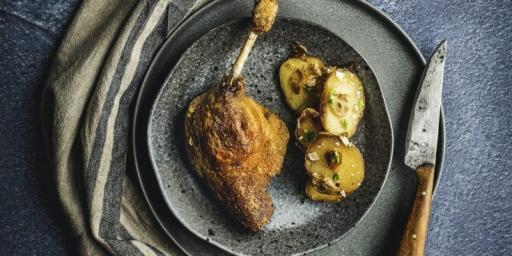
If you could pick your last meal – what would it be? For my last meal on Earth, I would select a dish that is both humble and classic. I would choose a duck confit. There is something utterly delicious about obscenely crisp duck skin mixed with succulent duck meat. It is a dish that my wife Lisa and I have shared commemorating many events. Duck confit is the very first solid food my son Beaumont ate. Keep reading to learn more about “My Last Meal.”
Crispy Duck Confit and Fried Potatoes
Ingredients 1x 2x 3x.
- 4 Duck Leg Quarters
- 1/4 cup Coarse Sea Salt
- 1 tbsp Black Peppercorns
- 1 bunch Fresh Thyme
- 1 Sweet Onion unpeeled, sliced
- 2 bulbs Garlic (unpeeled) 1 head coarsely chopped, for the other, 2 cloves smashed and the rest thinly sliced
- 1 quart Rendered Duck Fat or Pork Lard
- 1 pound Yukon Gold Potatoes
- 1 bay leaf
- 1 sprig Fresh Thyme
- 1 tbsp Fresh Thyme chopped
- Sea Salt & Freshly Ground Black Pepper to taste
Instructions
Make the duck confit:.
- Toss the duck legs with salt, peppercorns, thyme, onion, and garlic in a large bowl. Cover with plastic wrap and refrigerate for three (3) days.
- Preheat the oven to 250°F (120°C). Rinse the legs and discard the salt mixture. Place the duck in a large Dutch oven and cover with 1 inch of the duck fat. Bake until the meat just barely falls off the bone, about 3 hours.
- Remove the duck from the oven and let it cool in the fat. To serve later, freeze in individual portions with a small amount of fat (for the express purpose of having it ready when you need to brown the skin) and serve it at another time.
- Spoon a generous dollop of duck fat in a large nonstick skillet over low heat until it melts to crisp the duck legs. Add the duck legs, skin-side down, and cook until the skin starts to crackle and turn brown for about 10 minutes. Low and slow is the preferred method here. Transfer to a plate and keep warm. Set the skillet aside.
Make the Potatoes:
- In a medium saucepan, combine the potatoes, bay leaf, thyme, and the two garlic cloves and cover with cold water.
- Bring to a boil until the potatoes are easily pierced with a small knife, about 10 minutes.
- Cut the potatoes in half lengthwise and add them to the skillet you used for the duck. Cook over low heat until golden brown, about 10 minutes.
- Add the sliced garlic and cook, stirring constantly, until it’s light amber, about 2 minutes.
- Pour the potatoes and garlic into a fine-mesh strainer over a bowl to remove the duck fat. Reserve the fat for another use.
- Return the potatoes and garlic to the skillet and stir in the thyme and salt, and pepper. Serve the potatoes alongside the duck confit on warmed plates.
More Duck Recipes and Sides:
Please share this with friends and family., affiliate information, banana tarte tatin a variation on the classic, enjoying the french riviera lifestyle in cannes, related posts, wheat berry risotto with vegetables a vegetarian main course, recipe for sisteron braised lamb with orange and fennel it’s delicious, chicken with saffron and quince a fall recipe, culinary traditions beef daube a provencal recipe worth trying, chef françois de mélogue.
François de Mélogue grew up in a very French household in Chicago. His earliest attempts at cookery began with the filleting of his sister’s goldfish at age two and a braised rabbit dish made with his pet rabbits by age seven. He eventually stopped cooking his pets and went to the highly esteemed New England Culinary Institute, where he graduated top of his class in 1985. Chef François has over 30 years of cross-cultural culinary experience and brings an impressive culinary history and a unique Mediterranean cooking style. After graduating top of his class from the notable New England Culinary Institute, Chef François began his career in a number of highly acclaimed kitchens across the country, including Chef Louis Szathmary’s restaurant The Bakery in Chicago, Old Drovers Inn, a Relais and Chateaux property in New York and Joel Robuchon Gastronomie restaurant in Paris, before opening award-winning restaurant Pili Pili in his hometown of Chicago, rated in the Top Ten new restaurants in the World by Food and Wine magazine in 2003. Chef François resides in St Albans, Vermont with his wife Lisa and ten-year-old son Beaumont, who has proclaimed himself the family saucier. Chef François' latest publication French Cooking for Beginners: 75+ Classic Recipes to Cook Like a Parisian takes you on a culinary journey well beyond the streets of Paris. Francois is a professional photographer specializing in food/product photography, real estate photography and shooting rural landscapes of Vermont and France. Explore his work on https://www.francoisdemelogue.com/. Take a look at his website Simple French Cooking filled with delicious recipes and beautiful photos. Also follow Francois on Medium for more tempting dishes Pistou and Pastis .
Leave a reply Cancel reply
Your email address will not be published. Required fields are marked *
This site uses Akismet to reduce spam. Learn how your comment data is processed .
Privacy Overview
Apt: one bedroom rental apartments.
The apartments have lounge and dining areas with fully equipped modern kitchens. The bedrooms are bright and airy with modern bathrooms.
- One Bedroom
VIEW THIS LISTING
Luberon B&B Absoluut Valvert
Exclusive and charming, this 5 room B&B is surrounded by nature yet is only a stone's throw from historical Bonnieux.
- Bed and Breakfast
1-Bedroom Apartment in Villefranche-sur-Mer
Le Beau Balcon is a sunny apartment on Rue Volti in the heart of the old town, the building is a short walk to shops and restaurants.
- Côte d’Azur (French Riviera)
Bonnieux - 3 Bedroom Village Apartment
Bonheur en Bonnieux a 1300-square foot, 3-bedroom/2 bathroom, the newly-renovated apartment is located in the village center.
- Three Bedrooms
Holiday Apartment for 6 People
Les Roches sleeps 6 people. This renovated duplex apartment on two floors has 3 bedrooms, a large kitchen and access to a small, sun-bathed pool.
Find a Recipe
Get 5 Secrets to Make Homemade Taste Food Better + New Recipes Weekly!
Duck Confit Recipe
Published December 6, 2023. This post may contain affiliate links. Please read my disclosure policy .
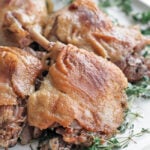
This classic French Duck Confit Recipe is slow-cooked in an herb and garlic-filled pot of duck fat for several hours until crispy on the outside and fork-tender on the inside. To this day, this is one of my all-time favorite things to eat.
We eat quite a bit of chicken and poultry in our house because the flavors are mild, and the meat is lean. Not to mention, everyone in my family likes it. If you feel the same, try my Chicken Scallopini or Roast Turkey .
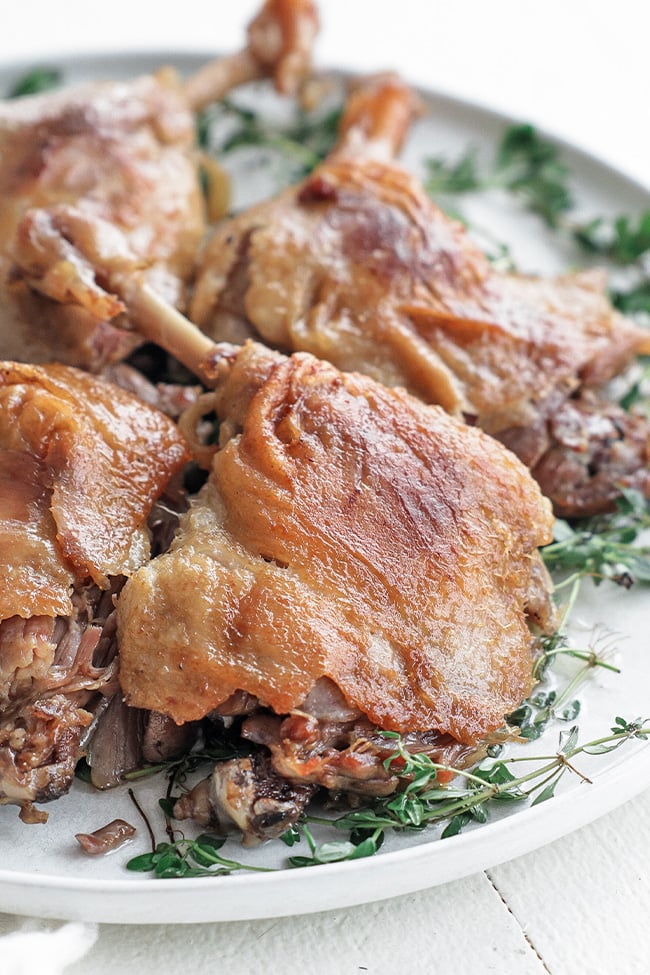
Duck Confit
Duck confit is an ancient dish rooted in Gascony, France, consisting of duck salted and cooked in its fat. The duck is then chilled and used as a procedure for preserving. Once the duck confit is cooled, a fat cap forms on the top, preventing oxidation from penetrating the protein. This process is also commonly used with goose and pork.
This dish is the epitome of French cuisine, and the technique of confiting itself has become popular worldwide. It is used to make things like tomato or garlic confit . Duck confit is an easy dish to make and requires almost no over-the-stove cooking and watching. I promise you that you will enjoy this dish once you try it.
Ingredients and Substitutions
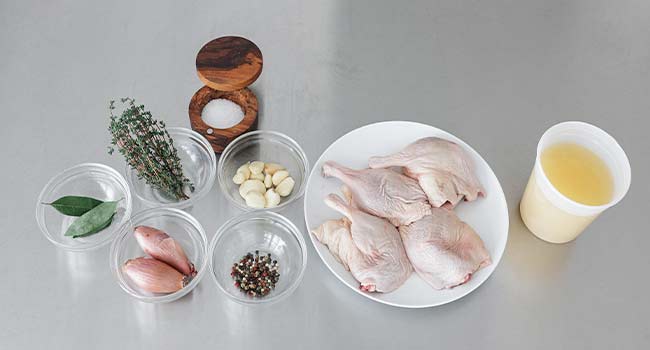
- Duck – Classically, duck confit only uses duck legs, including the thigh and drum intact with the skin on. You can use duck breasts as well, but it is not advised.
- Onions – I use shallots and garlic in this recipe for the confit oil and for seasoning the duck overnight before cooking. You can substitute the shallot with a ¼ peeled red onion.
- Herbs – You will need fresh thyme and dried bay leaves. Dry thyme can only be used when bringing the duck overnight, but do not use it in the confit oil.
- Seasonings – Coarse salt and whole peppercorns are what you need. Any color peppercorns will work.
- Fat – Traditionally, duck fat is what’s used. Add or substitute with pork lard , beef tallow, or a neutral-flavored oil like avocado or a lightly flavored olive oil.
How to Make Duck Confit
- Add the duck legs to a 13×9 casserole dish and season both sides with coarse salt and cracked pepper.
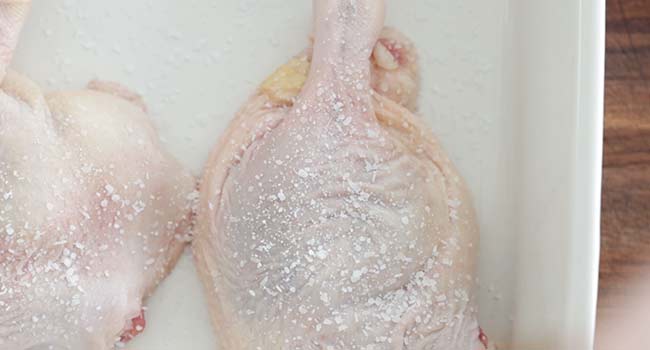
Next, rub in 4-5 thyme sprigs, ½ crushed bay leaf, and 1 smashed garlic clove into the flesh side of each duck leg.
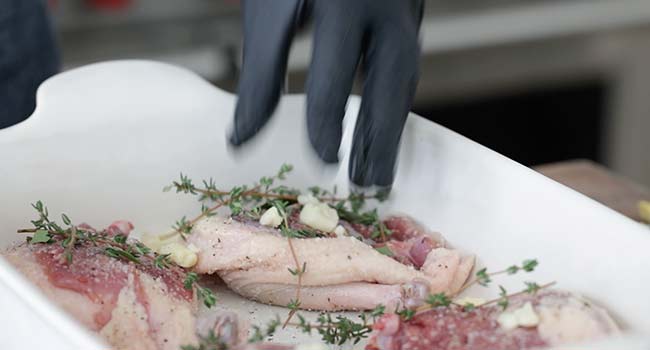
Flip the duck over and repeat the process entirely to each duck leg.
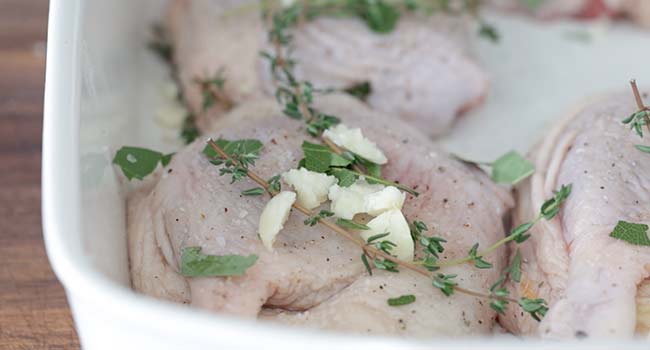
- Cover the pan in plastic and place it in the refrigerator for 12-24 hours.
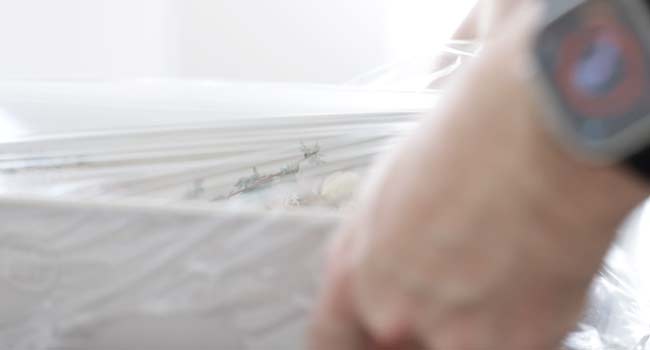
- Remove the duck and rinse each leg under cold water to remove any leftover thyme leaves or bay leaves. It’s ok if some pepper is still on there.
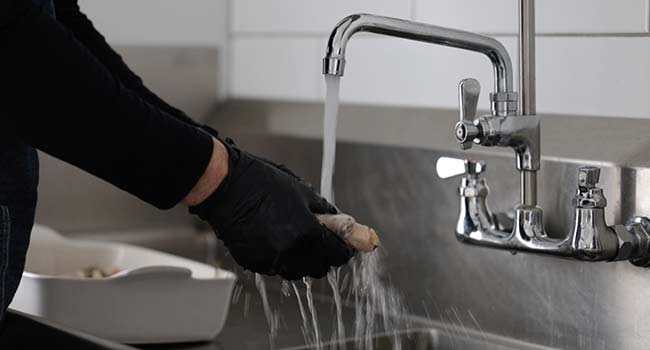
- Transfer the duck to a sheet tray or platter and blot them dry on both sides with paper towels.
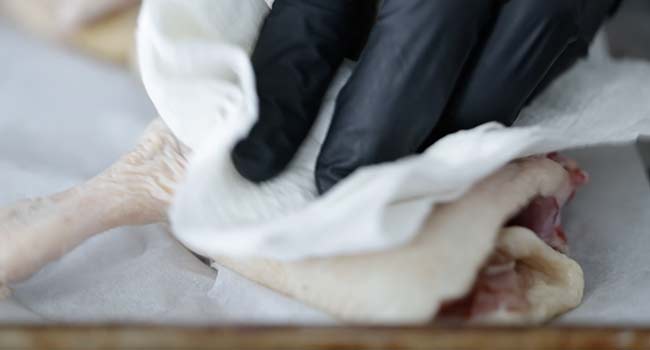
- Add the duck fat and any additional lards or oils to a medium-sized saucepot along with the shallot, garlic cloves, thyme sprigs, coarse salt, and peppercorns over low heat, just to a low simmer. This takes about 5-7 minutes.
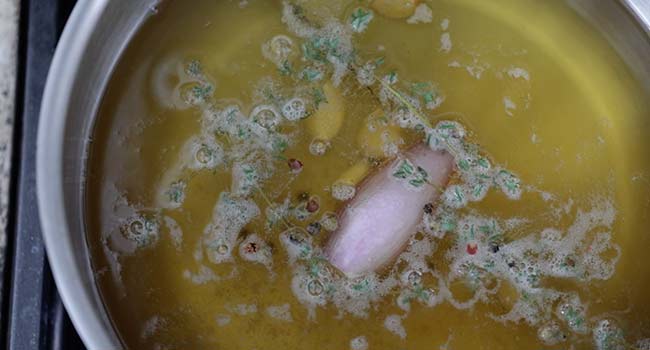
- Next, add in the duck legs and ensure they are submerged.
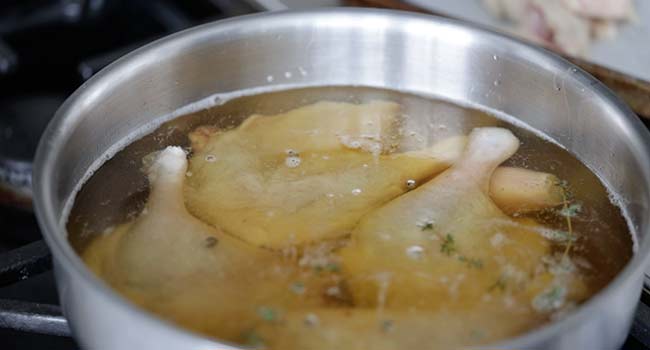
Place a lid on the pan in the bottom third of the oven and cook at 250° for 2 ½ hours.
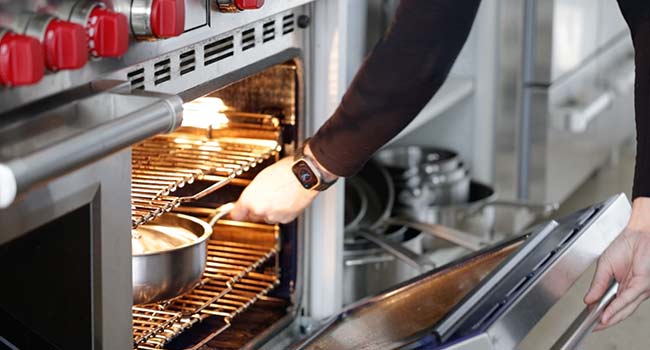
Remove the pan’s lid and cook for an additional 90 minutes or until the duck is very tender and easily shreds.
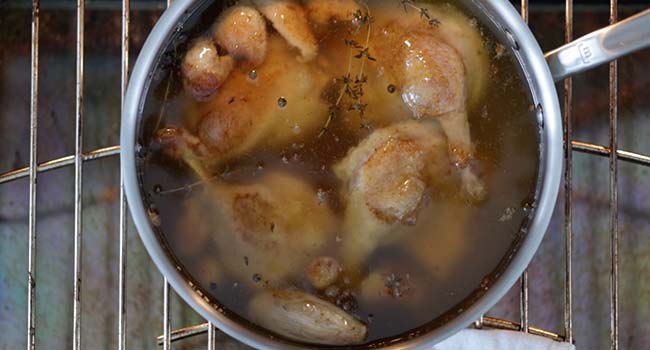
The duck can be served as is. To crisp up the skin, add ½ cup of the confit oil to a non-stick or cast-iron skillet over medium heat and carefully add the duck skin side down and cook for 4 to 5 minutes or until the skin becomes more browned.
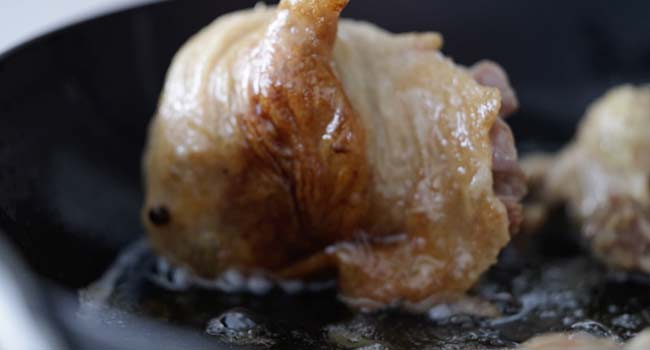
You can also place the duck on a rack over a sheet tray and bake in the oven at 425° for 25 to 30 minutes.
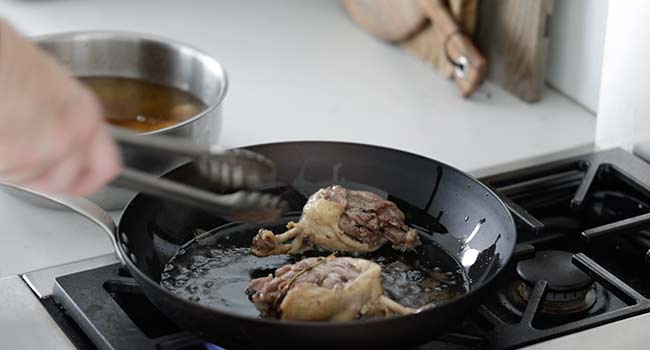
Serve the duck confit on a bed of fresh thyme sprigs or your favorite side dish .
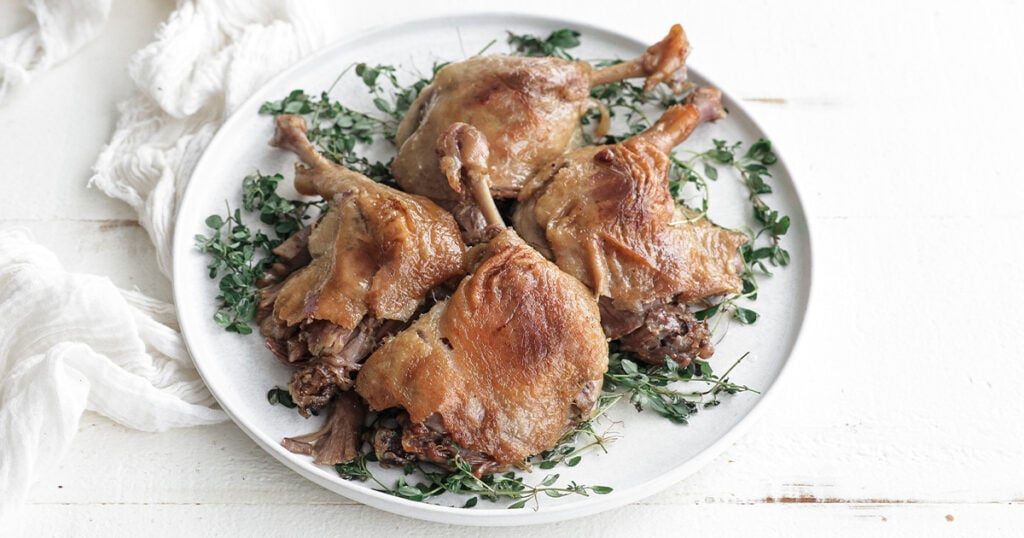
Storing Duck Confit
- If you want to preserve the duck, cool it in the oil to room temperature and then place the duck legs into a container and strain the confit oil into the container, completely covering them.
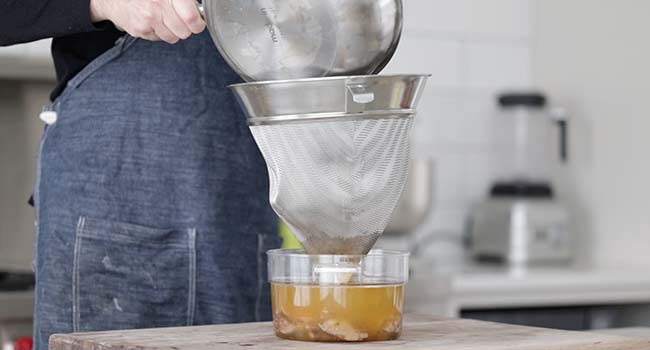
Place the container in the refrigerator to cool to form a fat cap. This will last covered in the refrigerator for up to 3 months.
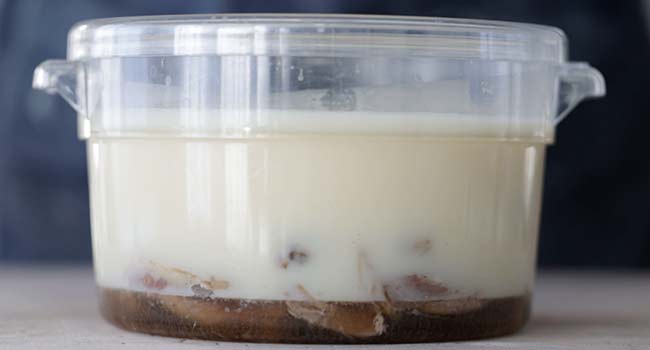
Make-Ahead and Storage
Make-Ahead: If you want to serve it relatively soon, for freshness, duck confit can be made up to 2 days ahead.
How to Store: Store it in a container and keep it in the refrigerator for up to 4 days. The duck also freezes well for up to 6 months. If the duck is submerged and cooled in the confit oil, it can last covered with the fat cap untouched for up to 3 months. Thaw it in the refrigerator for 1 day before reheating.
How to Reheat: Place the desired amount of duck confit in a pan with ½ cup of the confit oil or chicken stock. Cover with a lid or foil and cook in the oven at 350° for 20 to 25 minutes or until warm.
Chef Notes + Tips
- The pot must be large enough to ensure the duck legs are entirely submerged and the duck legs are heavily overlapped.
- I never use convection unless specified.
- Duck tastes like a very flavorful chicken and has almost no gamey taste.
More Poultry Recipes
- Tuscan Chicken
- Chicken Biryani
- Smoked Turkey
- Fried Chicken
- Beer Can Chicken
Share this Post
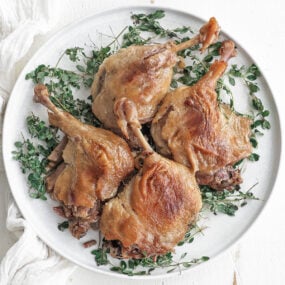
Ingredients US Customary Metric
- 4 skin on duck legs
- 48 fresh thyme sprigs
- 4 bay leaves
- 14 garlic cloves
- 4 cups duck fat
- coarse salt and fresh cracked pepper to taste
- 8 to 12 peppercorns
Instructions
- Next, rub in 5 thyme sprigs, ½ crushed bay leaf, and 1 smashed garlic clove into the flesh side of each duck leg.
- Flip the duck over and repeat the process completely to each duck leg.
- Place a lid on the pan place it in the bottom third of the oven and cook at 250° for 2 ½ hours.
- Remove the pan's lid and cook for an additional 90 minutes or until the duck is very tender and shreds with ease. They will have an internal temperature of around 208° to 210°.
- The duck can be served as is. However, to crisp up the skin, add ½ cup of the confit oil to a non-stick or cast-iron skillet over medium heat and carefully add the duck skin side down and cook for 4 to 5 minutes or until the skin becomes more browned.
- Optionally place the duck on a rack over a sheet tray and bake in the oven at 425° for 25 to 30 minutes.
- Serve the duck confit on a bed of fresh thyme sprigs or your favorite side dish.
- Place the container in the refrigerator to cool to form a fat cap. This will last cover in the refrigerator for up to 3 months.
Elevate Your Every Day Cooking
Get Chef Billy’s go-to tips that transform “blah” into “brilliant” plus weekly newsletter!
Add a comment Cancel reply
This site uses Akismet to reduce spam. Learn how your comment data is processed .
- sue 😁
Thank you ChefBilly😋😁👋🤩
Thank you ChefBilly love your recipe sooo tasty 😋
- Donna A Pollock
Hey Chef, I have never tried to make this Beautiful dish but it dosen’t look that hard but it does take a lot of time to make, I have eaten this prepared before and it is very delicious. I love duck fat anyway. I will have to call Whole Foods to see if they can get me any duck at all. This sounds so delicious, I will let you know how it turns out if I can get some duck . Thank you Chef,,,
I made a chicken confit from another recipe (had not seen this yet, but almost identical in protocol) to make a “proper” (can you say, “lengthy and time-consuming”) French Cassoulet.
What do YOU use this confit for, Billy?
Get Chef Billy’s go-to tips that transform “blah” into “brilliant” plus weekly newsletter!
Corrie Cooks
Quick and Easy Recipes
Corrie Cooks » Dinner
Duck Confit
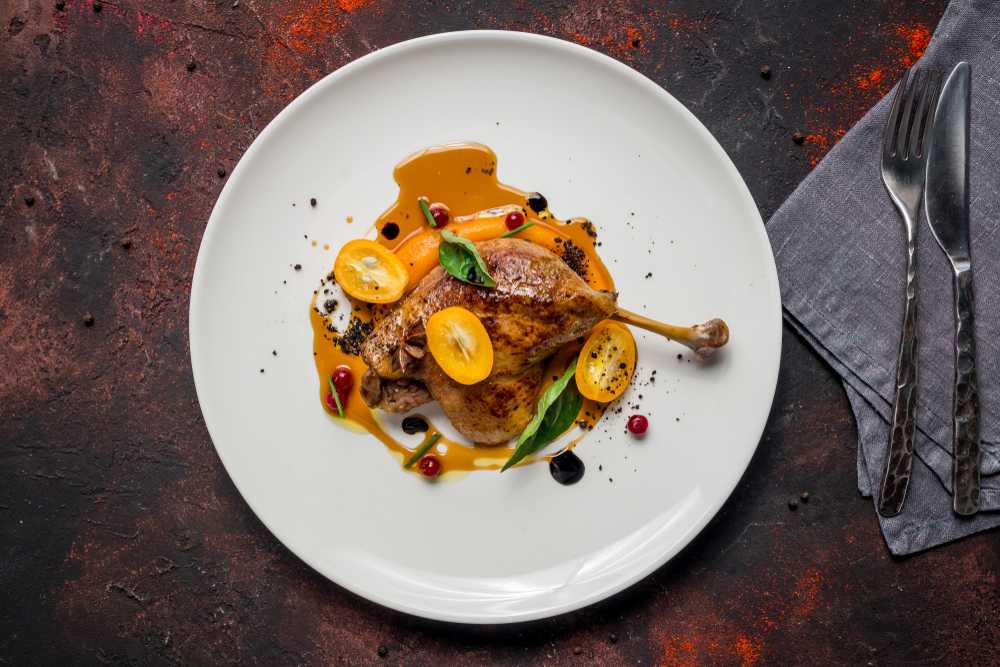
Duck Confit is a classic French dish, known for its rich flavor and tender, fall-off-the-bone meat. It's prepared by slow-cooking duck legs in their own fat, resulting in an incredibly flavorful and indulgent dish. This process might seem intimidating, but it's surprisingly straightforward.

So, if you've been wanting to try your hand at some authentic French cuisine, this Duck Confit recipe is a great place to start. With a little bit of patience and the right ingredients, you'll be enjoying your own homemade Duck Confit in no time. Let's dive in!
Table of Contents
Why This Recipe Works
Ingredients, how to serve, similar recipes.
This recipe stands out because it makes a gourmet dish accessible to home cooks. The slow-cooking method not only tenderizes the duck meat but also intensifies its flavor. The rendered duck fat acts as a natural tenderizer and flavor enhancer, making every bite of the duck confit succulent and full of umami goodness.
What's more, this recipe is easy to follow and requires minimal hands-on time. It's a perfect example of a 'low and slow' cooking method, where patience is rewarded with fantastic results. The best part is, once you’ve made it, you can store the duck confit in the fridge for weeks, or even months. This means you can prepare it well in advance of when you want to serve it, making it a perfect dish for entertaining. So, if you're looking to impress your guests or just treat yourself to a special meal, this duck confit recipe is the way to go.
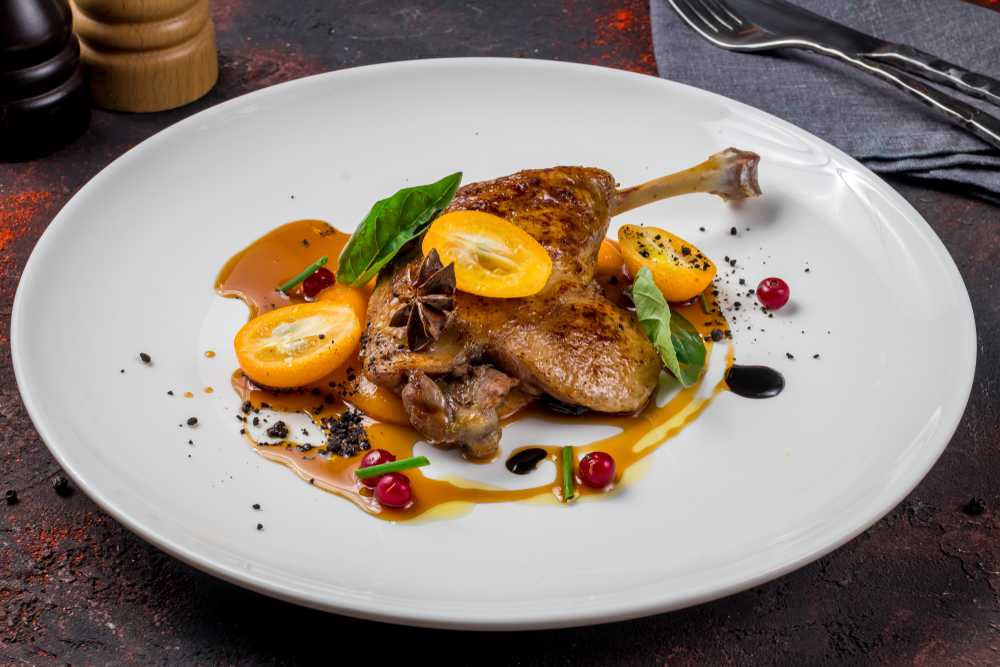
Duck Legs - Typically, four duck legs are used for this recipe. They provide the perfect balance of meat, fat, and flavor. If you can't find duck, chicken thighs make a good substitute, but keep in mind the flavor won't be quite the same.
Duck Fat - This is the key to a successful confit. Duck fat gives the dish its distinct flavor and richness. If duck fat is hard to come by, you can use lard or a high-quality olive oil.
Garlic - Four cloves give a subtle aromatic presence. Fresh garlic is best, but you can use minced garlic as a backup.
Fresh Thyme - This herb adds a touch of earthiness. If you can't find fresh thyme, dried thyme works, too, but reduce the amount to a teaspoon.
Coarse Sea Salt - For curing the duck, coarse sea salt is preferred due to its texture and mineral content. Kosher salt is a suitable substitute if needed.
- Make sure to cure the duck legs in salt for at least 24 hours. This not only seasons the meat but also helps to draw out moisture.
- Take your time to slowly cook the duck in its own fat. Low and slow is the key to achieving a tender result.
- After cooking, let the duck confit cool in the fat. This helps to further tenderize the meat and enhance the flavor.
- Duck confit can be stored in its fat in the refrigerator for up to two weeks. The fat helps to preserve the meat.
- Before serving, sear the duck skin side down to get it extra crispy.
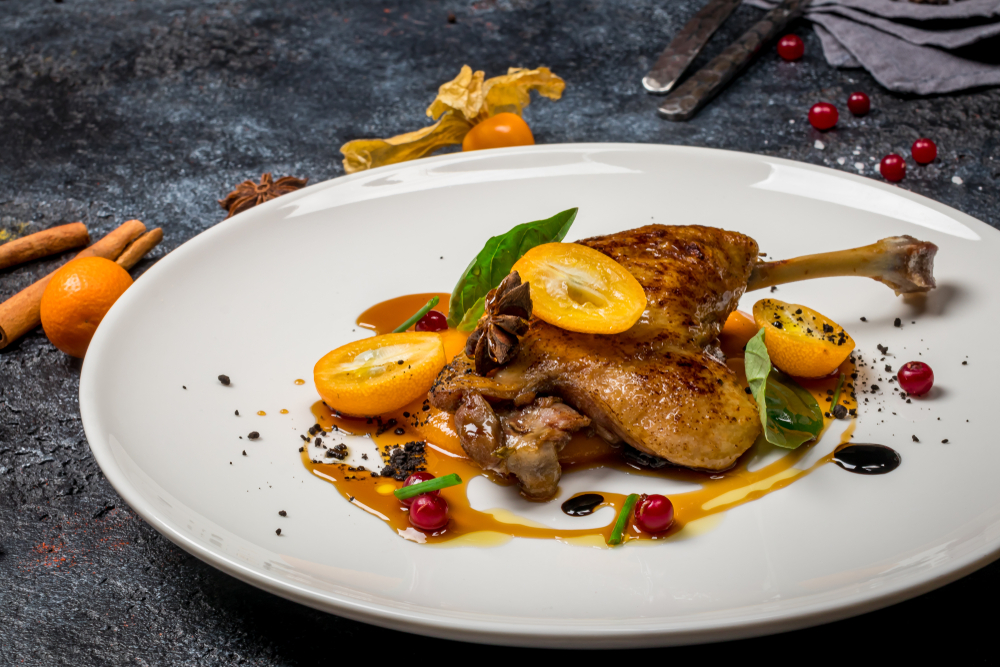
Duck confit is an incredibly versatile dish that can be served in numerous ways. Traditionally, it's served with potatoes cooked in duck fat and a simple green salad. However, it can also be shredded and used in salads, sandwiches, and even pasta dishes.
- Duck Confit with Lentils: Serve the duck confit over a warm lentil salad. The earthy lentils complement the rich duck beautifully.
- Duck Confit Sandwich: Shred the duck and serve it in a crusty baguette with some Dijon mustard and arugula.
- Duck Confit Pasta: Toss shredded duck confit with wide pasta noodles, some of the duck fat, and a little Parmesan cheese for an indulgent meal.
Turkey Tenderloin
Turkey Taco Casserole
Air Fryer Cornish Hens
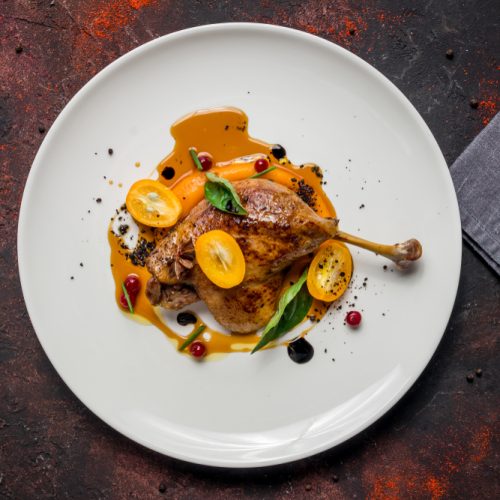
- ▢ 4 duck legs
- ▢ 1 cup duck fat
- ▢ 4 cloves garlic
- ▢ A handful of fresh thyme sprigs
- ▢ 2 tablespoons coarse sea salt
Instructions
- Rub the duck legs with coarse salt, garlic, and thyme. Let them cure in the fridge for 24 hours.
- Rinse off the salt and pat the duck legs dry. Preheat your oven to 200°F (93°C).
- Place the duck legs in a deep baking dish and cover with the duck fat.
- Cook the duck legs in the oven for about 6 hours, until the meat is tender and pulls away from the bone easily.
- Let the duck legs cool in the fat, then refrigerate until needed.
- To serve, heat a pan over medium-high heat. Add the duck legs, skin side down, and cook until the skin is crispy.
Leave a Reply Cancel reply
Your email address will not be published. Required fields are marked *
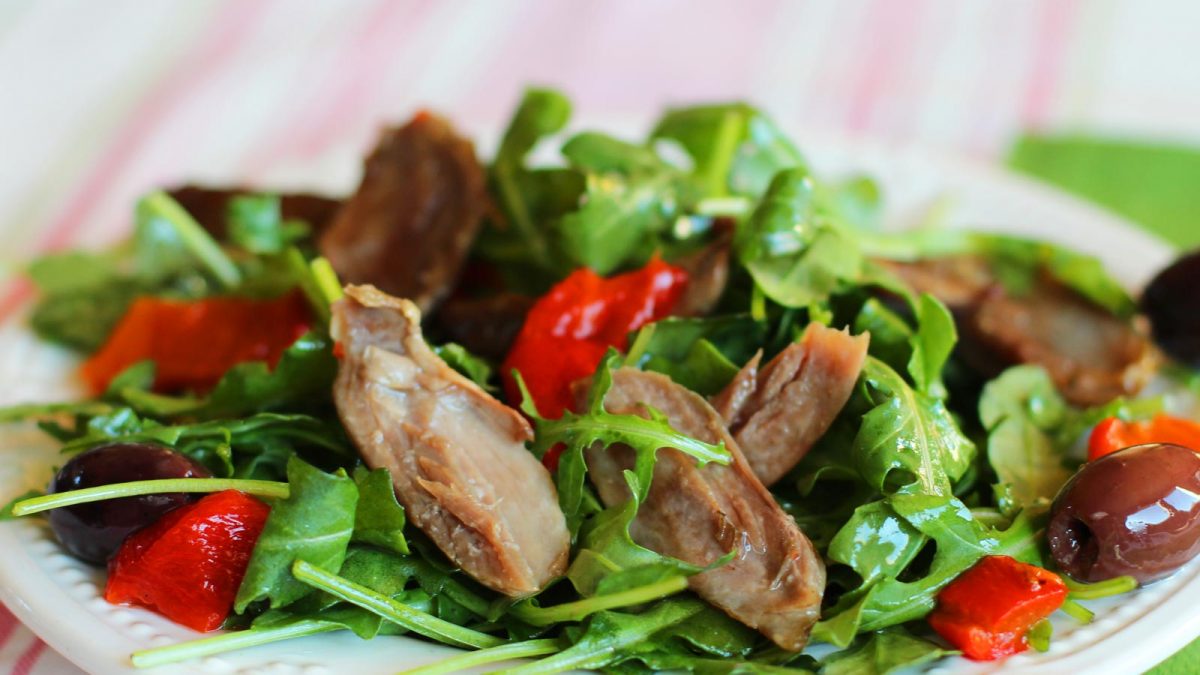
Instant Pot Recipes Keto Recipes Paleo Recipes
Duck Confit Recipe
Looking for a super-simple duck confit recipe? You’ve come to the right place.
If you’re familiar with duck confit (pronounced con-FEET), you already know that it practically melts in your mouth, is loaded with flavor, and can elevate even the most urbane dishes to gourmet status.
But duck confit doesn’t just taste great – it can also be a health-promoting dish that is rich in belly-flattening, disease-fighting monounsaturated fats .
And because it is cooked “low and slow” and kept moist throughout the process, there is little concern for generating harmful cooking byproducts like lipid oxidation products (LOPs) and heterocyclic amines (HCAs) that can damage our DNA and cells.
And here’s the best part…
Despite its fancy reputation and legendary gourmet tradition, duck confit is very easy to make at home with just a few ingredients and minimal prep time. In fact, the hardest part about making duck confit is waiting until the dish is done.
Below, you’ll find a simple step-by-step recipe. But first, I want to share a little history on this treasure from the south of France and the culinary preservation method that’s making a comeback…
What is Duck Confit?
The word “confit” translates to “preserved” in French. It is an old-world technique, traditionally used for preserving duck, pork and goose.
But it is not the slow cooking that’s responsible for confit’s long shelf life – it’s the salt. Salt prevents the growth of microorganisms by drawing water out of microbial cells through osmosis. (You need a concentration of about 20% to kill most harmful species). The amount of fat covering the confit during storage also reduces spoilage, by preventing air from coming into contact with the meat.
Confit that is properly prepared will keep in the refrigerator for up to six months. But you’ll find so many ways to enjoy it, it’ll be gone much sooner than that!
Now that you know a little bit of the history, let’s get started with the easy preparation…
Duck Confit Recipe: The Easy Step-By-Step
The first (and most important step) is choosing the healthiest ingredients.
Most duck is factory-farmed, given routine antibiotics and growth hormones, crammed into tight, inhumane quarters and often force-fed to create fatty livers for foie gras production. For these reasons, we highly recommend that you avoid conventionally-raised duck.
We prefer using Pastured duck legs and duck fat from US Wellness Meats , sourced from free-range Pekin Ducks, fed a non-gmo diet, free of growth hormones and antibiotics.
The traditional method of preparing confit involves using pure duck fat to cook the legs. I like to make this delicacy a bit more affordable (and pack in more monounsaturated fats) by using a 50:50 blend of duck fat and avocado oil . You will still enjoy the rich flavor at about half the cost (I use Olivado for this recipe, but we also love Ava Jane’s unrefined avocado oil ).
Once you have finished making your duck confit, you’ll have a nice supply of “duck-a-cado” oil that is safe to use at medium to high temperatures and is great for sautéing veggies, drizzling over roasted winter squash and root veggies, and of course, searing meats.
Onto the next key ingredient: salt. I use a combination of mineral-rich Real Salt and Smoked Maldon . I find this combination gives the confit a pleasant slightly “smoky” taste.
And finally, the aromatics… you’ll also need some bay leaves, thyme and black peppercorns.
Here’s a photo of everything you’ll need for your duck confit:
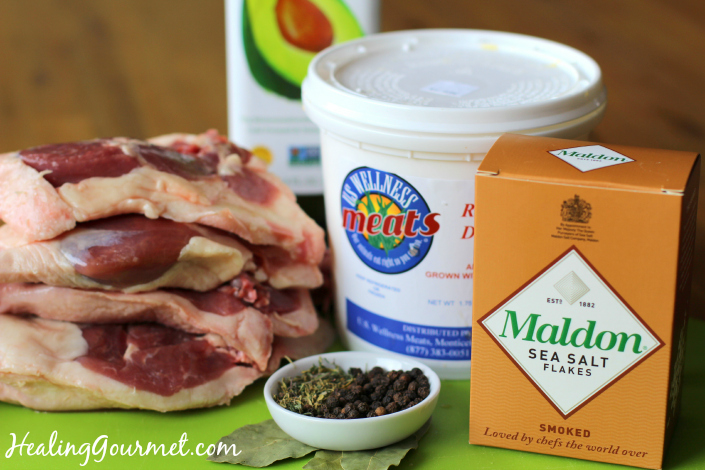
… and here’s what it will look like when its done…
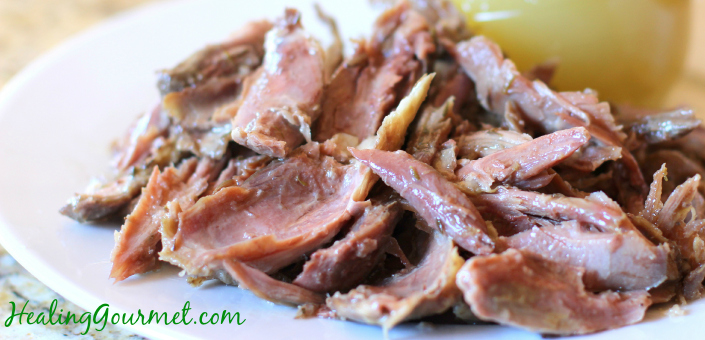
4.7 from 7 reviews
Ingredients
- 6 free range duck legs (about 3 lbs.)
- 2 cups free range duck fat
- 2 cups avocado oil
- 6 sprigs fresh thyme, stripped
- 3 bay leaves, crushed
- 1 Tbsp. peppercorns, crushed
- 1/4 cup salt (Real Salt and/or Smoked Maldon, preferred)
Instructions
- First, rinse the duck legs and then pat dry. Combine the salts and aromatics. Add the duck legs to a large zip-top bag and pour in the salt mixture. Rub the legs to coat.
- Transfer to the refrigerator to cure for 24-36 hours.
- Remove duck legs from curing in the refrigerator. Rinse and pat dry. Then add the legs to a slow cooker or slow-cooker / pressure cooker hybrid. I use the Instant Pot for its versatility and safe, stainless steel interior.
- Now, melt the duck fat and add the avocado oil. Add the melted oil to the duck legs until they are completely covered. Turn on the slow-cook function and cook for six hours on low.
- Let the vessel cool slightly, then separate duck meat from oil and pull or chop the meat into small chunks. Now, you can now put your duck confit into mason jars and use a safe canning method for long term storage. Or simply pack the meat in jars and then cover completely with the fat. This will remain good in the refrigerator for up to several months, but it’s probably best to enjoy it within a few weeks.
Nutrition & Macronutrient Ratio
Nutrition Information Per Serving
278 calories, 16 g fat, 4 g saturated fat, 8 g monounsaturated fat, 3 g polyunsaturated fat, 133 mg cholesterol, 1 g carbohydrate, 1 g NET carbs, 0 g sugar alcohols, 0 g sugar, 0.1 g fiber, 30 g protein, 10 mg potassium, 3 mg phosphorous, 997 mg sodium, 1 mg magnesium
54 % FAT | 45 % PROTEIN | 1% CARBOHYDRATE
How to Enjoy Your Duck Confit Recipe
There are unlimited ways to enjoy this gourmet treat. I especially enjoy melting duck confit until it is warm and then pouring the meat and fat mixture over a fresh salad. I also like to serve it as a starter at dinner parties, where it has always been a hit.
But one thing is for sure, once you taste that first bite, I think you’ll agree that this is one dish that you will want to enjoy this duck confit recipe over and over again.
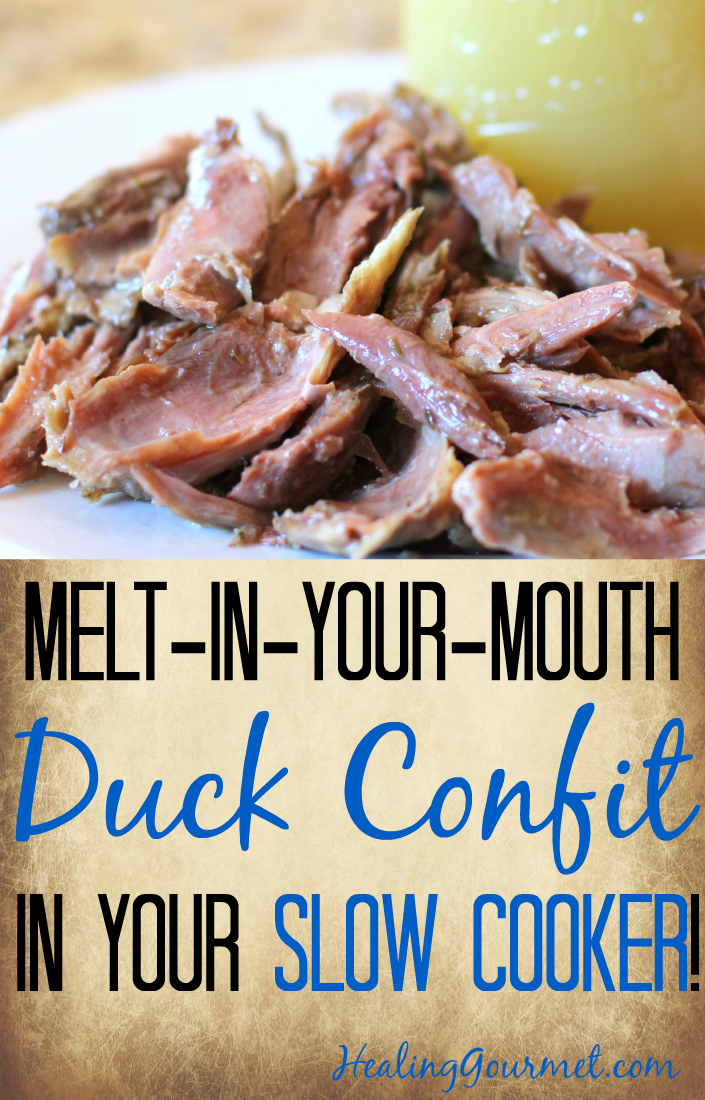
Have you ever made duck confit? If so, what ingredients and preparation did you use and how did it turn out?
This post may contain affiliate links. Click here to read my affiliate policy.
Pressure Cooker Pulled Pork
Melt-in-your-mouth, duck fat braised pork sirloin roast (updated with instant pot version), about the author.
Kelley Lunsford
Kelley Lunsford, founder of Healing Gourmet, is a natural nutrition enthusiast with a background in biochemistry. Her passion is educating on how foods promote health and protect against disease and creating simple and delicious recipes for vibrant health and enjoyment.
Recommended Articles
Related recipes.
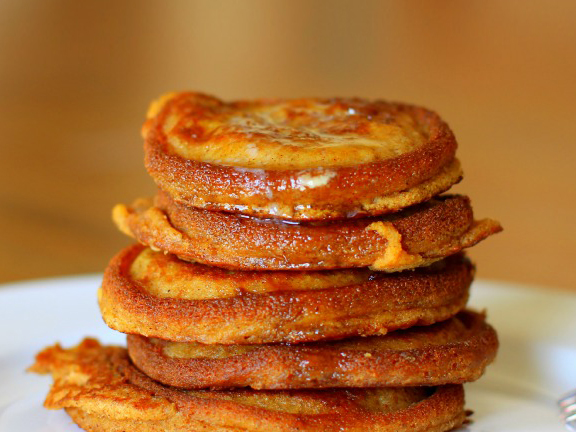
Fat-Burning Paleo Buttermilk Pancakes (Dairy Free, Gluten Free)
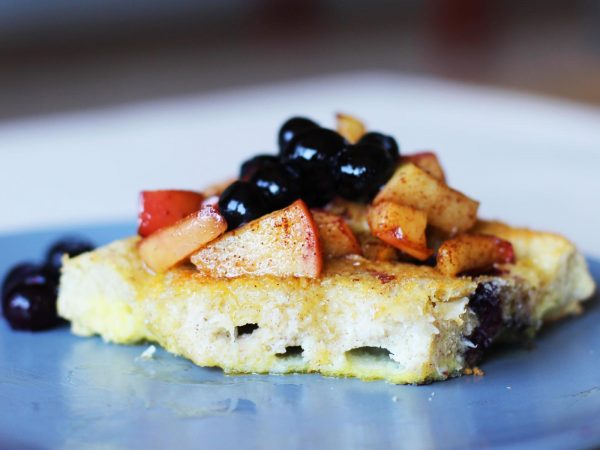
German One Pan Pancakes (Grain Free, Gluten Free)
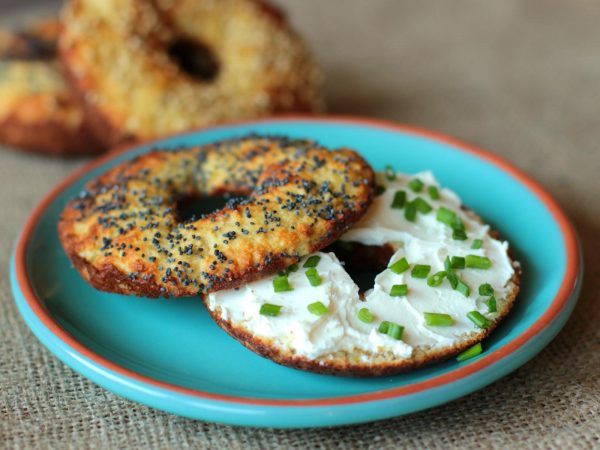
Low Carb Paleo Bagels
28 comments, leave a reply cancel reply.
Your email address will not be published. Required fields are marked *
Mar 11, 2015 at 9:50 pm
I can’t find the Nutrient Information for Duck Confit on your website, though it says you have it. People with Diabetes must be aware of their carbohydrate intake. If you think your recipes are healthy (and I have purchased several books and products from you already) why hide the nutritional information? Everything should be on the up and up and hiding nutritional values makes me wonder.
Mar 12, 2015 at 12:26 am
Hi Jean, I would say thank you for the comment, but I don’t really feel that way with the oddly accusatory remarks and skepticism about the validity of our information.
There is a simple reason this recipe doesn’t have any nutrition information. When you add 4 cups of fat to a dish with 6 servings, but you consume only a miniscule amount of that, how do you account for the 3.75 cups that are not consumed in the servings, and instead consumed later in other recipes? I thought of modifying the recipe in our proprietary nutrition system (which even calculates to the mcg of micronutrients like lycopene), but it would not be completely accurate as I have not weighed the total amount of starting ingredients compared with the weight of the cooked ingredients to determine the amount of fat that is actually absorbed into the duck lugs during the cooking process. I would rather not post any nutrition information, than post “guestimate” nutrition information, which I feel is the right way, or on the “up and up”, as you say.
Lastly, being a diabetic, I’m sure that you know which foods have carbohydrates. Duck legs, salt, avocado oil, duck fat, peppercorns, bay leaves and thyme have exactly none.
Jul 06, 2017 at 2:23 pm
LOL, Jean. You’ve clearly never had duck confit. It’s all fat and meat and fat. Did I say fat? No carbs. I suggest to try it first from a can. The French make a really great canned confit, which you can buy on Amazon. And it’s got a nutritional label! However, Kelly is right. You don’t usually eat a lot of duck confit. Think of it as similar to a “pork belly,” but stewed in its own fat. I usually add duck confit as an ingredient in a French cassoulet (bean stew). Or I eat a small portion with a lot of side dishes. Anyway, here is the amazon link with nutritional label: https://www.amazon.com/Rougie-Confit-Duck-Legs-52-91oz/dp/B0008JGWB4/ref=sr_1_1_a_it?ie=UTF8&qid=1499350360&sr=8-1&keywords=duck%2Bconfit&th=1 . Kelly’s recipe is better and healthier with the avocado oil.
Mar 12, 2015 at 1:06 am
This recipe has my mouth watering and I can’t wait to try it. I ordered my duck legs from US Wellness Meats this afternoon, but unfortunately they are out of stock on Duck Fat! 🙁
I have signed up to be notified when it is back in stock but the duck legs are on the way and I would like to make this as soon as it comes if I can figure out what else I can do.
Do you know of an alternative source for good quality duck fat? Is it possible to use only avocado oil for the whole recipe? Perhaps I could buy an extra duck and render my own? I think I might have some duck fat leftover from Christmas in my freezer. I have plenty of chicken fat – would that work? Just trying to figure out how to do this without the wonderful duck fat @ US Wellness Meats!
Any suggestions?
Mar 12, 2015 at 3:24 pm
Hi Linda! Thanks so much for your kind comment and question. I have a couple of ideas for you…
First, you can render a good bit of duck fat from duck breasts or whole duck. I am amazed at how much you can get. Start with a cold pan, preferably ceramic/enameled cast iron and place in pan skin side down (score the skin to avoid curling) and heat over very low heat – the fat will melt off and you can reserve. Here is more on that – https://healinggourmet.com/healthy-cooking/cooking-with-duck-fat/
Next on the alternate fats. Chicken fats are not advisable. It is very high in omega 6 fat making it an unhealthy option. However, I have made confit with all avocado oil (a monounsaturated fat) and it turned out great. You don’t get so much of the duck-y flavor, but still delicious and packed with those healthy fats.
I know it is frustrating when US Wellness Meats is out of one of the ingredients you need, but in this case, it is worth the wait. You can put your name on a notification list when it is back in stock for your next batch of confit.
Hope this helps!
Be Well, Kelley
Mar 13, 2015 at 3:59 am
Thanks Kelly, I didn’t know about chicken fat being harmful! I need to go through your site and read every single thing that you have written!!!
After doing a long, arduous web search I have come to the conclusion that PASTURED duck fat is as scarce as “duck’s teeth”! There is none to be had as far as I can tell. But I DID find a source for ALL NATURAL duck fat. It is a fairly large quantity – 7.5 lbs and I’m not sure I want to invest a lot of money for a large quantity of something that isn’t exactly what I am looking for.
Do you think a duck fat labeled ALL NATURAL is worth buying or would you wait for the pastured kind to come available again?
Thanks! ~Linda~
Mar 13, 2015 at 3:24 pm
Hi Linda, You’re right about healthy duck fat being scarce – US Wellness Meats is the only kind I have found. “All Natural” unfortunately doesn’t mean much. Ducks that are “all-natural” can be fed GMO feed, cramped in pens and administered antibiotics, etc. I would wait for pastured or do a trial run with avocado oil if you really have a confit craving 🙂
Apr 28, 2016 at 3:22 am
Hi again Kelley!
So, since reading this article and your other ones on duck fat and coconut oil, I’ve been paying far closer attention to the kinds of fats I use. I wanted to know your thoughts on Turkey Fat? Right after the holiday season last January, I was able to get a heritage turkey from my local health food store at a deeply discounted price. It has been in my deep freeze til now, and yesterday, I thawed it out and roasted it. Now I have a large amount of lovely Turkey Meat, two gallons of Turkey Bone Stock, and a second boiling of the bones to add to my dog food. This turkey also yielded a pint of Turkey Fat and I’m trying to decide if this is a “good” fat, (like duck) or a “bad” fat (like chicken).
What is your opinion? Should I strain it and use this turkey fat in cooking or should I discard it?
Mar 12, 2015 at 1:12 am
Oh – one other question.
I don’t like to use plastic for marinading or curing. I am thinking that you are calling for a zip-lock bag for the curing because it holds the salt and the meat close together. I do that sometimes with a fish marinade that I like and the plastic bags are great for that. However I worry about leaching.
Do you think mixing the ingredients in a glass container for curing would work as well? Or should I go ahead and use the zip-locks and not worry about the plastic? I am concerned that the open space of a glass container might cause everything to spread out and not cure correctly.
Mar 12, 2015 at 3:27 pm
I’m with you on this, Linda. I really don’t like using plastic for anything.
I marinate in a large shallow glass dish that allows everything to be in a single layer – I think that will work just fine for this recipe.
Mar 12, 2015 at 3:10 am
Hi, Ms Kelly. I just want to let you know that I am enjoying the recipes in your last book and recipes from this website too. I would like to ask you if you know what is the best skillet to cook pancakes. I will appreciate. Thanks
Mar 12, 2015 at 3:38 am
Thank you for this recipe! I recently had Duck Confit at a restaurant and it was amazing! I cannot wait to make your recipe.
I have no idea where to find duck legs and duck fat? Whole Foods?
Are all ducks raised free-range or are there factory farms for ducks, like for chickens?
Mar 12, 2015 at 1:34 pm
Hi Sheri… yes, unfortunately, ducks are often raised in conditions that are similar to other factory farmed animals. We purchase pastured duck legs and duck fat from US Wellness Meats. There is a link in the post above to their website. Here is that link again. Of course, there are many other suppliers as well. That would include some in your own area, I would assume. Eat Wild has an excellent director of local farms that raise their animals naturally and humanely. Here is that link also: http://www.eatwild.com/products/index.html
Mar 23, 2015 at 9:05 pm
Kelly: I was interested in knowing if you can make the confit from duck breast. I found some duck breast and wanted to try it with the avocado oil. Or can you only do it with legs?
Mar 23, 2015 at 9:18 pm
Hi Debbie, Thank you for your question.
While I think dark meat – legs and thighs – are better suited for confit, everything I have read says that breast meat can absolutely be made into confit.
If you give it a go, please let us know how it turns out! Be Well, Kelley
Apr 01, 2015 at 2:35 am
Do you have to slow cook this for 6 hours in the Instant Pot or can you use normal to high pressure and cook for a shorter amount of time?
After much hesitating, I finally got the courage to buy a whole duck. Can’t wait to try this! I just rendered duck fat (2nd method, with water) and the cracklings were to die for!
Apr 01, 2015 at 7:52 pm
Hi Dee, Duck cracklings are amazing!
For your question: Because making confit requires fat for cooking (not water), there risks. Many users guides state to use no more than 1/4 cup oil.
In a quick search, I found a couple interesting posts on the topic – http://missvickie.com/howto/fry/frying.html and http://www.eatdrinkexperience.com/duck-confit-and-waffles-under-2-hrs-start-to-finnish/ . While the latter example eliminates the risk of oil, they are wrapping the duck in plastic and foil and then pressure cooking. Perhaps it is tasty, but it is also a great way to super-infuse the duck with plastics. Often the quick way is not always the best way 🙂
Jul 17, 2015 at 9:01 am
Sounds great recipe with duck to me checking the ingredients show nutritional value. All grains especially WHEAT i’ve read should be avoided if you have any autio immune disease including diabetes .
Jul 17, 2015 at 2:34 pm
Hi Bev, I agree with you – wheat is a very detrimental food for people with autoimmune issues.
I hope you enjoy the duck confit!
Jan 31, 2016 at 3:44 am
We just finished dinner and the recipe was so delicious! Thank you for sharing! 🙂
You mentioned to save the duck oil to use for future cooking purposes. Could the left over duck-a-cado be used for another batch of confit and turn out just as good the second time?
Jan 31, 2016 at 4:24 pm
Hi Janine, I’m so happy to hear you enjoyed the duck confit!
I always save my duck-a-cado oil in a mason jar and keep refrigerated for future confit batches and everyday cooking. It is also great for sautéing veggies (green beans, onions, broccoli) or using to roast root veggies like sweet potatoes.
Feb 20, 2016 at 1:34 am
Thanks Kelley! We are getting ready to make another delicious batch this weekend! I’m going to have to check out your other recipes too. So glad I found your site. 🙂
Feb 25, 2016 at 11:49 pm
Thanks, Janine! So happy to hear you enjoyed the confit and that you have returned to visit us! 🙂
Aug 18, 2018 at 10:44 pm
This recipe has become a go to for us! We love it!! I was going to cook it for dinner today but forgot to start my recipe earlier. I’m wondering if this recipe can be done with the pressure cooking setting of the instant pot so it can be done in a shorter time?
Aug 19, 2016 at 2:03 am
Would I be able to use duck breasts ( wild) in place of the legs and if so do I need to adjust the amounts of fat nd oil used?
May 29, 2017 at 4:21 am
What’s gonna happen if I let it cure in salt longer …. I’m trying with a full duck ???? Is 3days too long?
Oct 26, 2018 at 2:40 pm
This is my first year raising my own Muscovies and I will try this recipe when mine are processed. Can you use pork fat – either bacon or from ham roast, in addition to duck fat? I realize pork fat is not as healthy but we also raise our own berkshire pork and I like to use what I raise.
Can I also recommend that instead of buying duck from an online retailer, try your local farms? Buying local helps build demand for small scale, sustainable, healthy and ethical farming. Buying online still fosters large scale farm operations, and even ‘free range’ can be done on a factory scale an in conditions that you would not want to support. Support your local small scale farmers, and when possible, raise your own! Try local buy and sell sites, Facebook and farm markets to source your meats. Ask if you don’t see it as demand will increase supply if the farmer knows it will sell.
Oct 26, 2018 at 2:56 pm
Hi Adriana! You raise Berkshire pork and Muscovy duck? Can I come over for dinner? 🙂
You can certainly use pork fat in this recipe. And I think you might be surprised at the health benefits of lard . Most people don’t realize it is primarily a monounsaturated fat, like olive oil.
And I absolutely agree with you to buy local whenever possible, and to get to know your farmer. Of course, for many people living in cities this is not possible (nor is raising your own!).
Supercharge Your Keto Diet And Spend 75% Less Time In The Kitchen!
In this FREE RECIPE BOOK Discover How to Put Your Keto Diet on Autopilot and Enjoy the Most Delicious Dinners You've Ever Set on the Table…
- Privacy Policy
- User Site Agreement
- Affiliate Disclosure

Duck Confit (A Quack-tastic Carnivore Meal)

Table of Contents
Ingredients
4 duck legs
4 cups duck fat
4 garlic cloves, smashed
2 sprigs each: thyme & rosemary
1 tbsp sea salt
1 tsp each: black peppercorns & coriander seeds
- Rub duck legs with salt, peppercorns, and coriander.
- Add garlic, thyme, rosemary, and bay leaf.
- Cover and refrigerate overnight.
- Preheat oven to 275°F (135°C).
- Melt duck fat in an ovenproof pot.
- Submerge duck legs in fat.
- Cook in the oven for 2-3 hours until tender.
- For serving, sear duck legs in a skillet until the skin is crispy.
Have you ever heard of Duck Confit? If not, you’re in for a treat. Let me take you on a quick journey through time. Duck confit, with its rich history, hails from France.
It’s a method where the duck is slowly cooked in its own fat, resulting in a melt-in-your-mouth delicacy.
But here’s the twist: beyond its deliciousness, Duck confit holds a special place in the carnivore diet.
Why, you ask? Well, it’s packed with nutrients and offers a unique flavor profile that’s hard to match.
Plus, for those on a strict carnivore regimen, it’s a fantastic way to diversify meals while staying true to the diet’s principles.
So, whether you’re a history buff, a carnivore dieter, or just want some carnivore lunch meal, Duck confit is a dish that’s sure to impress.
Duck Confit, First Things Need To Do
First things first, when choosing your duck, age plays a crucial role. Younger ducks are generally more tender, so if you have the option, that’s the way to go.
Additionally, the size and origin of the duck can significantly impact the taste.
Ideally, you’d want a medium-sized duck, and if you can get your hands on a free-range or fresh, cheap organic meat , even better.
Once you’ve got your perfect duck, it’s time for prep work. Clean it meticulously, ensuring no feathers or quills remain.
Then, portion it out, focusing on the legs, breasts, and wings.
For an added burst of flavor, marinate it with fresh herbs, especially rosemary and thyme. Now, onto the cooking.
The essence of Duck confit lies in its slow cooking, aiming for that melt-in-the-mouth tenderness.
Once cooked, a quick sear will give you that irresistibly crispy skin, contrasting beautifully with the tender meat.
Trust me, once you give it a shot, your taste buds will be in for a treat. Here’s to many happy cooking adventures!
Duck Confit A Game Changer Meal
Duck confit stands out not just as a gourmet dish but also as a nutritional powerhouse, especially for those on a carnivore diet.
Why, you ask? Well, beyond its luxurious taste, Duck confit boasts an impressive nutritional profile.
It’s not just a source of high-quality protein but also brimming with essential fatty acids, making it a delicious and efficient way to fuel your body.
And speaking of its taste, have you ever indulged in a meal that fills you up and leaves you yearning for just one more bite? That’s the magic of Duck confit.
Its rich and savory flavors ensure that you’re dining not just for the sake of nutrition but for the pure, unadulterated joy of a culinary experience.
But the wonders of Duck confit don’t stop there. Its versatility in meal prep ideas is genuinely commendable.
Whether you’re serving it as the star of your main course, shredding it atop a fresh salad, or using it as a gourmet topping, the possibilities with Duck Confit are as endless as they are delicious.
So, as you navigate the carnivore diet, remember it’s not just about consuming meat; it’s about savoring the journey and the myriad benefits it brings.
Tasty Twists on Duck Confit
Duck Confit, a timeless culinary masterpiece from the heart of France, has traveled the world and, in doing so, has donned various delightful avatars.
While the traditional method involves using a slow cooker the duck cooked in its own fat to achieve that melt-in-the-mouth tenderness, chefs and home cooks alike have added their own twists and turns over the years.
From the spices and herbs infused during the cooking process to the accompaniments and presentation, Duck confit’s variations are as diverse as they are delicious.
Here are some:
1. Duck Confit with Vegetable Risotto
The rich, melt-in-the-mouth tenderness of the duck pairs beautifully with the creamy, al dente risotto, brimming with seasonal veggies.
Each spoonful offers a delightful contrast to the savory depth of the duck complemented by the fresh, vibrant notes of the risotto.
Garnished with a sprinkle of fresh herbs, this dish is a celebration of classic culinary techniques meeting contemporary flair.
2. Spiced duck confit with a Port and Damson sauce
The duck, infused with a medley of spices, achieves a succulent tenderness that’s beautifully contrasted by the crispy skin.
The pièce de résistance is the luxurious Port and Damson sauce, which drapes the duck with its deep, fruity notes and velvety texture.
The sweetness of the damsons, combined with the robustness of the Port, creates a sauce that’s both elegant and bold.
3. Duck confit with crispy potatoes and bitter leaf salad
The duck slow-cooked to perfection, offers a rich and succulent taste, which pairs harmoniously with the golden, crunchy potatoes.
The bitter leaf salad introduces a fresh and zesty dimension, cutting through the richness with its vibrant notes.
The combination of the hearty duck, the crispiness of the potatoes, and the refreshing bite of the salad creates a balanced and exquisite dish.
Sip and Savor Your perfect drinks for Duck Confit
The question often arises: what’s the perfect beverage to accompany this rich and savory dish? The answer, my friend, is as varied as it is delicious.
For those who lean towards the world of wines, Pinot Noir, with its light to medium body and cherry undertones, beautifully complements the fatty richness of Duck Confit.
Alternatively, a Merlot, known for its soft tannins and notes of plum and black cherry, can provide a harmonious balance to the dish.
But if wine isn’t your go-to, there are plenty of non-alcoholic options to explore.
Herbal teas like chamomile or rooibos offer subtle flavors that won’t overshadow the duck, and they bring a calming touch to your meal.
For a refreshing palate cleanser, consider sparkling waters infused with natural citrus or try some meal prep juices and fruit flavors, ensuring each bite of Duck Confit is as delightful as the last.
And for craft beer enthusiasts, the malty sweetness of Amber Ales or the roasted notes of Stouts can elevate your Duck Confit dining experience to new heights.
But at the end of the day, the best pairing is truly the one that brings you the most joy.
So, venture out, experiment, and discover the drink that perfectly tickles your taste buds.
Want some more Tasty Meal? I got you

Delving into the rich flavors of Duck confit, it’s evident that this isn’t just a gourmet treat but also a beacon of nutrition.
Yet, there’s so much more to explore! If you’re keen on fully immersing yourself in the carnivore way of life and maximizing the potential of dishes like Duck confit, you’ll need a structured approach.
Enter my free meal prep plan . Crafted to amplify your culinary adventures, this guide brims with diverse recipes, insightful tips, and handy techniques to simplify meal preparation.
Whether you’re a culinary maestro or just starting out in the kitchen, this plan promises a journey of delectable, healthful meals.
So, what’s holding you back? Grab your free meal prep plan today and transform your gastronomic experiences!
What does duck confit mean?
Duck confit refers to a traditional French dish where duck meat is slowly cooked in its own fat, resulting in tender, flavorful meat, and crispy skin.
What does duck confit consist of?
Duck confit primarily consists of duck meat, usually the legs, which are seasoned and slowly cooked in their own fat.
The process also often involves herbs and spices for added flavor.
What does duck confit taste like?
Duck confit boasts a rich and savory flavor profile. The slow-cooking process renders the meat incredibly tender and juicy, while the skin becomes deliciously crispy.
The taste is a harmonious blend of the duck’s natural flavors enhanced by the seasoning and herbs used during cooking.
Leave a Comment
Teal Notes is a participant in the Amazon Services LLC Associates Program, an affiliate advertising program designed to provide a means for us to earn fees by linking to Amazon.com and affiliated sites.
Copyright © 2024 Teal Notes
- Skip to primary navigation
- Skip to main content

- Petit Gourmet's Cozy Corner of Privacy
- Press, Features & Galleries
- Work with me
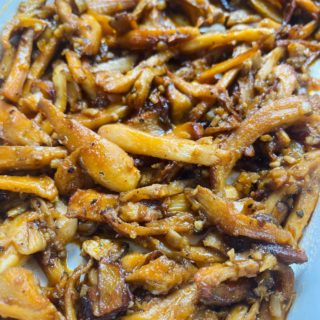
May 19, 2015
Duck confit parmentier
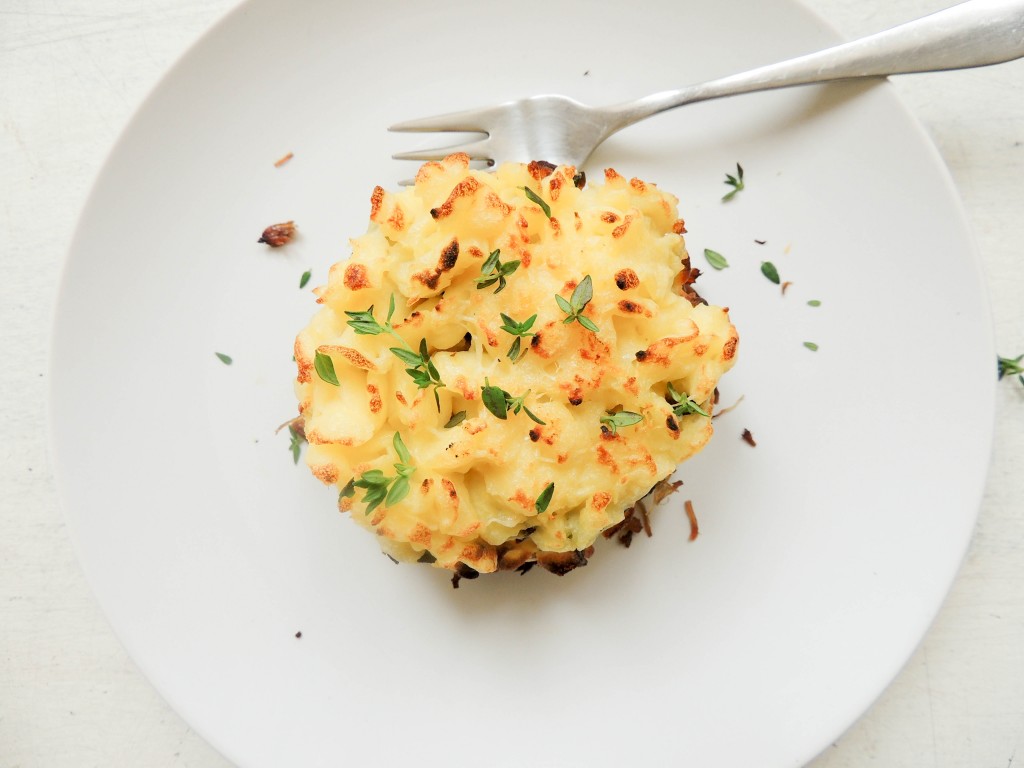
Hachis Parmentier is a French dish made with mashed, baked potato, combined with diced meat, or if you will a simpler version of a shepherd's pie. The word "hachis" means a dish in which the ingredients are chopped or minced.
This is a dish that will be normally made with leftovers, made with sausage meat, veal, chicken or beef. In this particular case I made it with some duck confit .
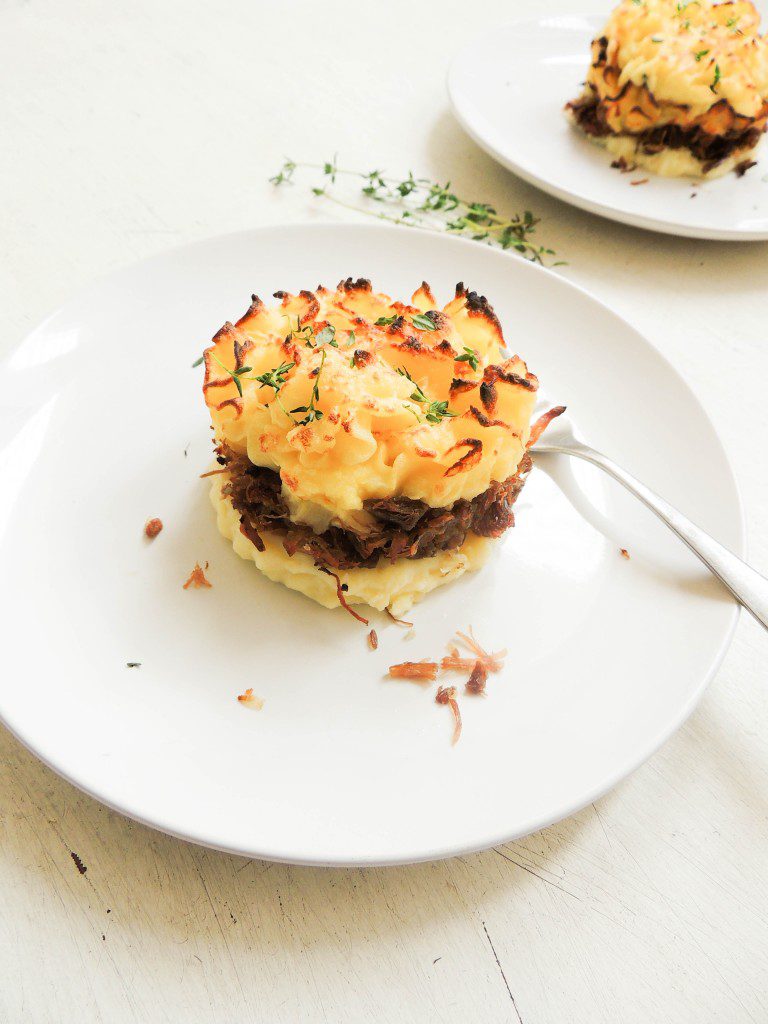
The confit is prepared in a process of preservation that consists of salt curing a piece of meat (generally goose, duck, or pork) and then cooking it in its own fat.
To prepare a confit , the meat is rubbed with salt, garlic, and sometimes herbs such as thyme, then covered and refrigerated for up to 36 hours. Salt-curing the meat acts as a preservative.
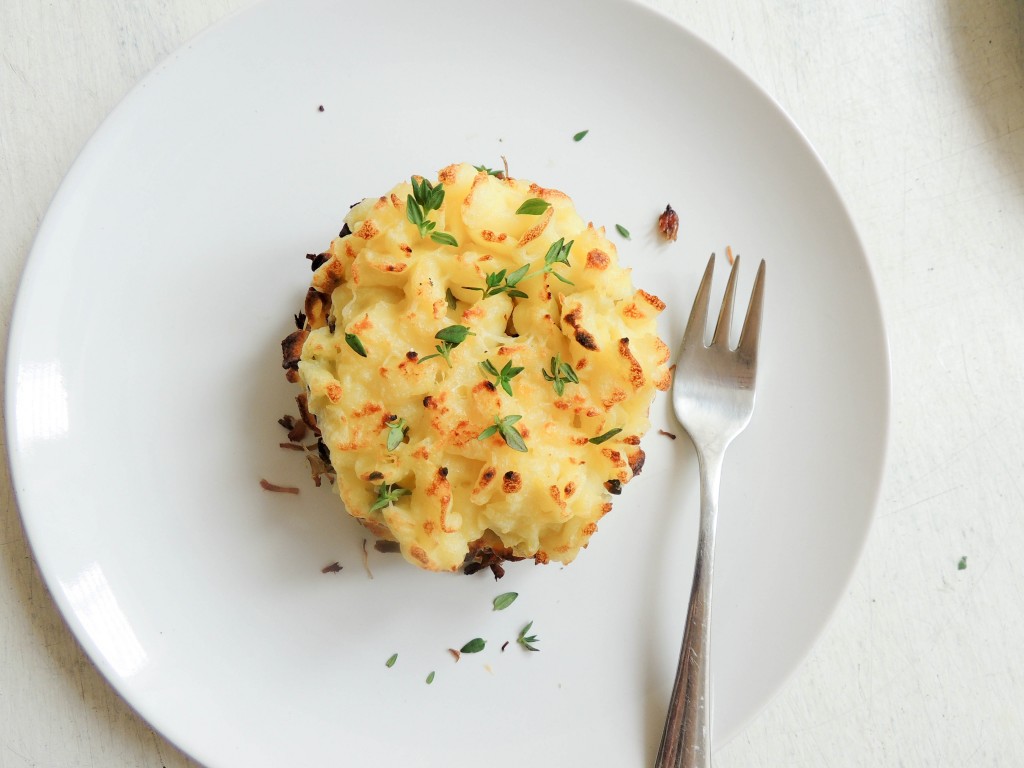
Prior to cooking, the spices are rinsed from the meat, which is then patted dry. The meat is placed in a cooking dish deep enough to contain the meat and the rendered fat, and placed in an oven at a low temperature (76 – 135 C/170 – 275 F). The meat is slowly poached at least until cooked, or until meltingly tender, generally four to ten hours.
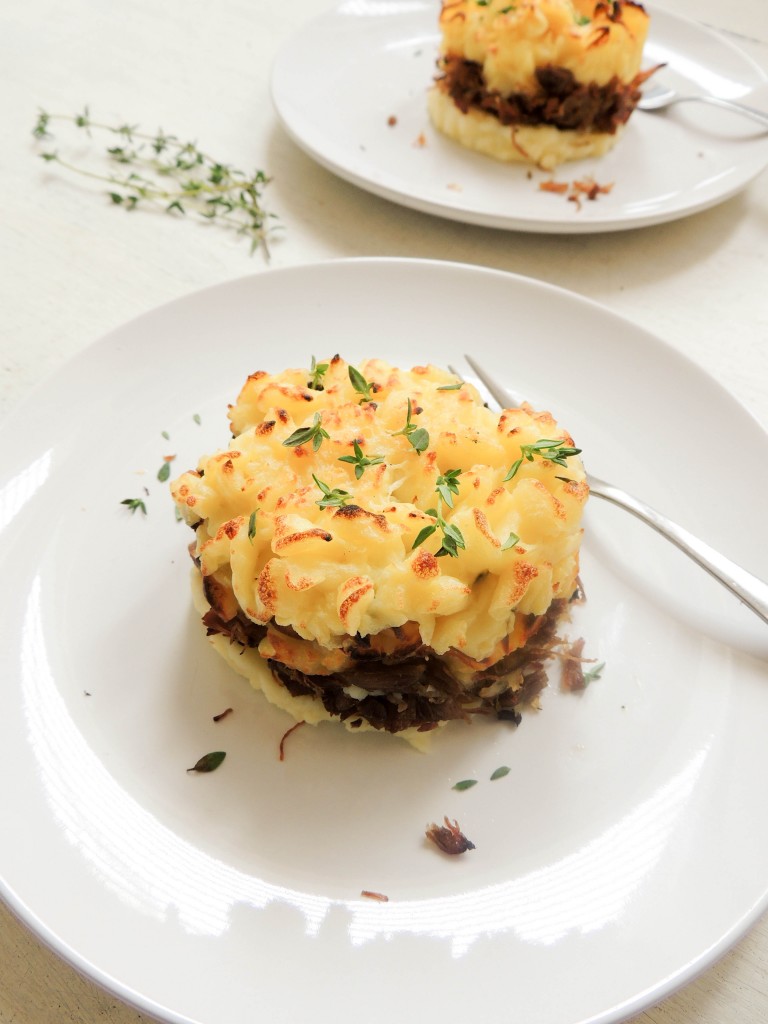
Anything homemade is worth the time and effort, I know not everyone have the time or the drive and making a meal, shouldn't take more than 30 minutes for the normal tired mom or dad after coming home from work; so that said, it is perfectly normal to buy your confit done. It's a product that is great quality, so go ahead.
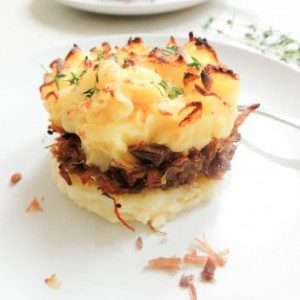
Ingredients
For the mashed potatoes.
- 6 large potatoes
- 4 tablespoons of crème fraîche or ¾ cup of buttermilk
- 4 tablespoons butter
- 2 tablespoons of grated Parmesan
For the duck confit
- 2 cloves garlic crushed
- 3 shallots thinly sliced
- handful of parsley
- 4 legs of shredded duck confit meat
- Salt and pepper
Instructions
- Cook the potatoes in boiling salted water until tender, about 20 minutes. Mash the potatoes, add butter, crème fraîche, salt and pepper. Mix well.
- Cut the shallots into thin slices, crush the garlic, in a frying pan heat the duck fat then add the shallots and garlic, cook until transparent. Add the duck meat and parsley.
- In a baking tray, spread a spoonful of potatoes on the bottom then add a thick layer of the confit then transfer the rest of the potatoes to a piping bag fitted with a star tip and pipe them on to of the duck mixture. Sprinkle with Parmesan.
- Bake in a 350 F oven until golden brown. Serve right away!
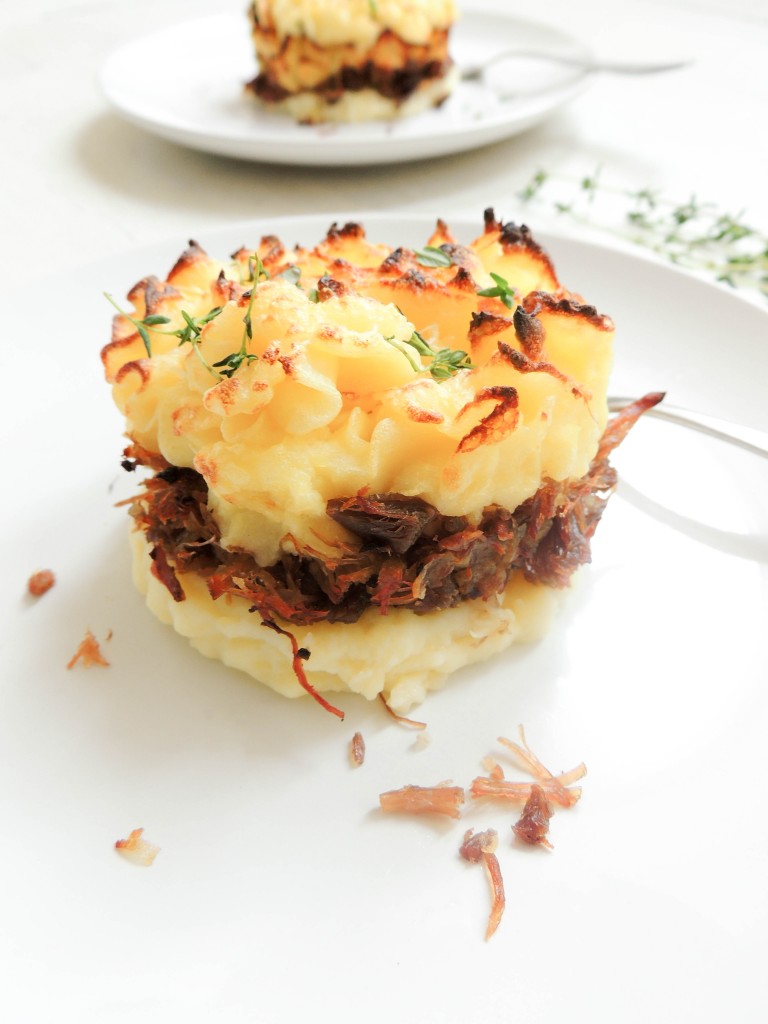
Happy baking!
Pues les cuento que esta receta es el equivalente de la Tarta del Pastor (Sheperd's Pie) o aquí sería algo así como un pastelón de papas relleno.
En esta ocasión el rico puré de papas está relleno de pato confitado. El pato confitado o confit (en francés confit de canard) es un plato francés hecho con la pierna o los muslos del pato.
Para preparar un confit, la carne se frota con sal y ajo, se cubre y se enfría por hasta 36 horas. El salar funciona como conservante. Antes de cocer la carne, se limpia bien toda la sal y se seca. Se pone en un recipiente lo suficientemente hondo como para contener la carne y la grasa derretida, y se mete en el horno a baja temperatura (76–135 ºC). La carne se escalfa al menos hasta que está cocida, o hasta que se vuelve tierna, desde 90 minutos hasta 10 horas.
Entonces se retiran la carne y la grasa del horno y se dejan enfriar. Luego se traslada la carne a un tarro u otro recipiente y se sumerge completamente en la grasa. Un tarro sellado de confit de pato puede conservarse en el refirgerador hasta seis meses. Para maximizar el periodo de conservación, la grasa debe cubrir la carne al menos un par de centímetros. La grasa cocinada funciona como conservante, dando además un sabor intenso. Debe señalarse que obviar la etapa de salazón reduce enormemente el periodo de conservación del confit.
Parmentier de confit de pato (pato confitado)
- Para el puré de papas
- 6 papas grandes
- 4 cucharadas de crema fresca o ¾ taza de leche
- 4 cucharadas de mantequilla
- 2 cucharadas de queso parmesano deshilachado
- Para el confit de pato
- 2 dientes de ajo machacados
- 3 cebollín o chalotas en rodajas finas
- puñado de perejil
- 4 piernas de carne confit de pato deshilachado
- Sal y pimienta
- Cocine las papas en agua hirviendo con sal hasta que estén tiernas, unos 20 minutos. Majar las papas, añadir la mantequilla, crema, sal y pimienta. Mezclar bien.
- Corte el cebollín o las chalotas en rodajas finas, majar los ajos, en una sartén calentar la grasa de pato a continuación, añadir el cebollín y el ajo, cocine hasta que estén transparentes. Añadir la carne de pato y el perejil.
- En una bandeja de hornear, extender una cucharada del puré de papas en el fondo, luego, agregar una capa gruesa de la confit y transferir el resto de las papas a una manga pastelera equipada con una boquilla de estrella y cubra la mezcla de pato formando estrellas de puré. Espolvorear con queso parmesano .
- Hornear en un horno a 350 F hasta que las papas estén doradas . Servir de inmediato!
Espero que les guste esta receta!
Sean felices! cocinando!
More Casseroles & gratins
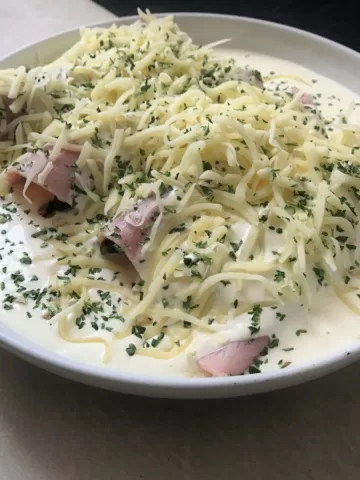
Reader Interactions
Thanks for coming did you make this recipe let me know cancel reply.
Your email address will not be published. Required fields are marked *
Cheyanne @ No Spoon Necessary says
May 19, 2015 at 11:06 pm
Ohhh lala! You happened to make one of my all time favorite dishes from culinary school. Since Le Cordon Bleu is french based, I made this dish countless times over the education process. Your version looks wonderful. I'm all for anything with duck confit. Swoon! xoxoxo
Petit Gourmet says
May 19, 2015 at 11:50 pm
Mais oui, Ma Cherie!! I wish I could have gone to culinary school too! I really envy you!! (In a good way, of course)..I didn't got to taste this one as my kids were waiting for me to finish the photos and they were gone on a blink of an eye! But that only tells me they were great!.. 🙂
Ben Maclain says
May 20, 2015 at 5:30 am
I love the combo of baked mashed potatoes and meat (even though I am not that passionate about meat). Who doesn't love such a hearty meal, indeed. This looks incredible, Gaila, and I absolutely love the idea of using duck confit - supposed yo be super delicate! Nicely done!
May 20, 2015 at 11:54 am
Hello Ben!! Yes, in my opinion there is nothing like duck confit, very good, you are right this is such a hearty dish! no one could say no. I loved your polenta recipe.. looks so creamy..
Confit Duck With The Best Ever Lentil Recipe
Last Updated on November 17, 2022 by Leyla Kazim
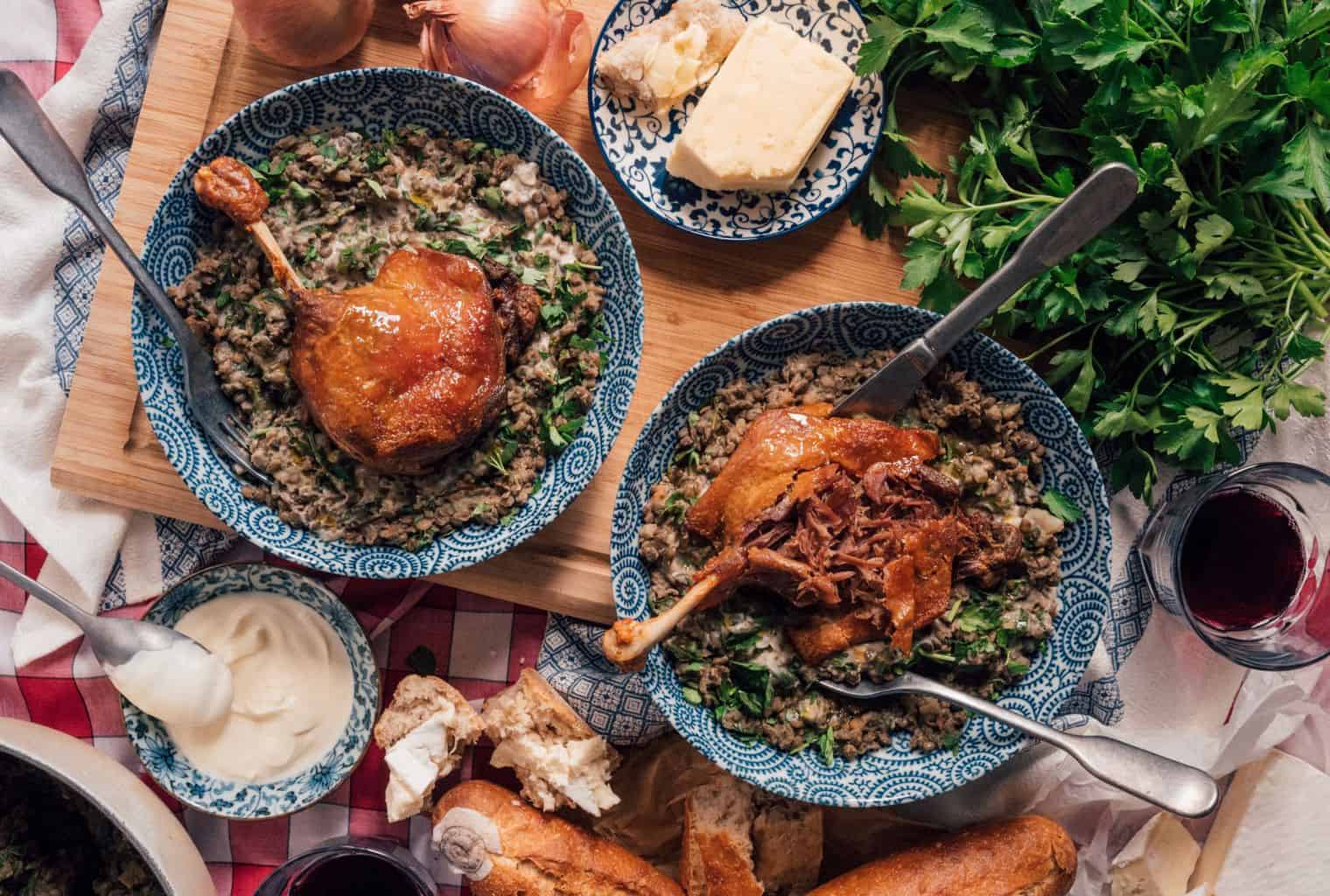
This lentil recipe is probably one of the best ways to cook lentils. And it goes beautifully with confit duck.
I’m not sure I’ve ever met someone who doesn’t love confit duck. Glorious duck with crispy skin and tender meat is hard to resist. But when cooking it at home it can be a challenge to know what to eat the duck with.
This lentil recipe using French Puy green lentils, from Le Puy in the Auvergne region of France, makes the most glorious accompaniment. It’s very simple to cook lentils in this way and it’s a lentil recipe that works as a terrific side with so many great meats.
You could pair these green lentils with something like slow-roast lamb or beef cheeks. Or you could keep it truly Français as I’ve done here, with beautiful duck confit from southwest France.
But I reckon you’ll want to cook lentils this way so often that you’ll happily end up eating them on their own as a main, which is a great idea to keep it vegetarian.
Why I love cooking with French produce
A few weeks ago I was totally thrilled to announce on my social media channels that for 2018, I am an ambassador of France Bon Appétit . This involves discovering and learning about French produce and ingredients and sharing recipes that use them with you guys.
France’s cuisine and produce is one I’ve long adored. So much so that the first recipe book I ever owned was a French one gifted to me by a couple of friends on my 18th birthday.
I cooked them duck breast with raspberries and dauphinois potatoes from it in my university student halls to take the book for a spin. It took about twice as long as I anticipated and we didn’t eat until 10pm, but I think it was worth the wait 😁
This is the first recipe in my series showcasing gorgeous and readily available French ingredients. Be sure to keep an eye out for future ones where I’ll be taking us through the summer and into autumn via the medium of beautiful French produce.
I’ll be creating one each month and there’ll be nine in total, making a nice little French-inspired repertoire to keep referring back to.
Don’t forget to subscribe to my YouTube channel!
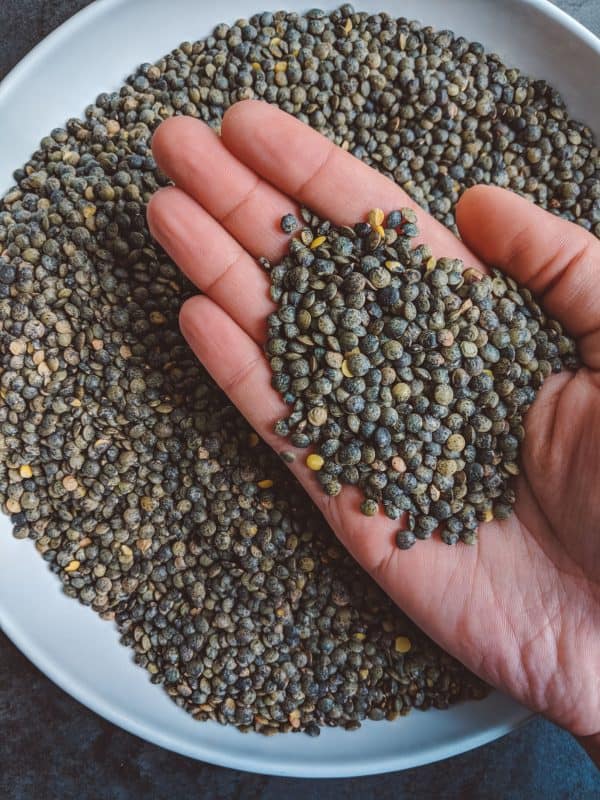
What exactly is confit duck and where can I find it?
Confit duck is considered one of France’s finest dishes and is native to Gascony in the southwest.
To ‘confit’ means to cook slowly in fat and it’s a way of both cooking and preserving food. So when you buy confit duck, the meat has already been cooked and it’s simply a case of heating it through.
You can find jars of fresh confit duck where the duck will be submerged in fat. In this case, you remove a piece of meat from the jar, wipe away the excess fat and heat in a hot oven until the skin becomes crispy and the meat is piping hot throughout.
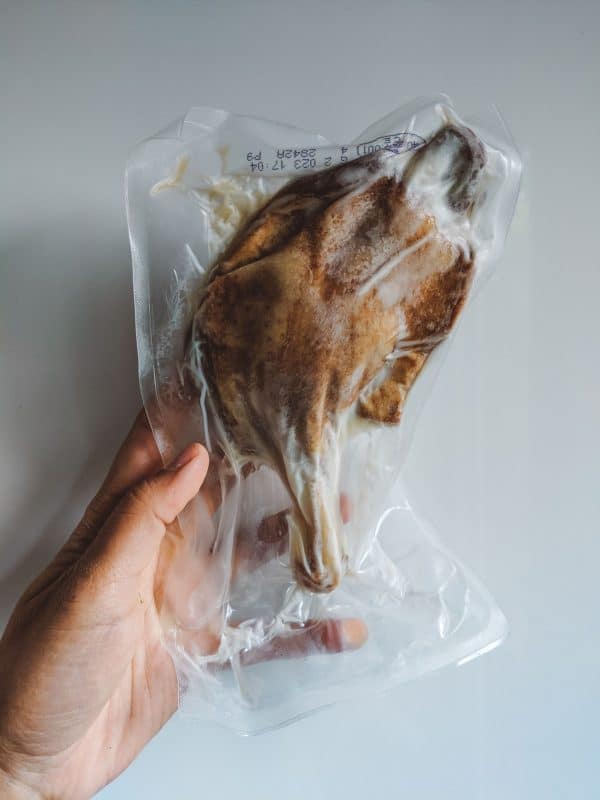
I couldn’t find any fresh confit duck but came across it frozen by a good quality brand ( Picard available from Ocado). Each leg was individually vacuum packed for freshness.
Following the instructions, I removed the legs from the plastic packaging and put them in a hot oven from frozen, no need to thaw first. After 30 minutes the skin was crispy and the meat was soft and tender, a perfect result!
So when shopping for confit duck in your local supermarket, don’t forget to check the freezer aisle too.
Eat your duck with a showstopping lentil recipe. You’ll always want to cook lentils this way!
Now it’s all about what to eat your duck with. Traditionally, some sort of potato side is often favoured. But using French green lentils is a glorious alternative and really good for you.
As well as Puy lentils and the confit duck, this lentil recipe includes a few other fabulous French ingredients. Notably, I’ve used exquisite pink onions from Roscoff in Brittany in northwest France, celebrated for their colour and unique mild flavour.
I had a wonderful stay with my aunt who lives in Brittany a couple of years back; take a look at the gorgeous food I ate there !
I’ve also used French crème fraîche which is like a sour cream, as well as French red wine vinegar.
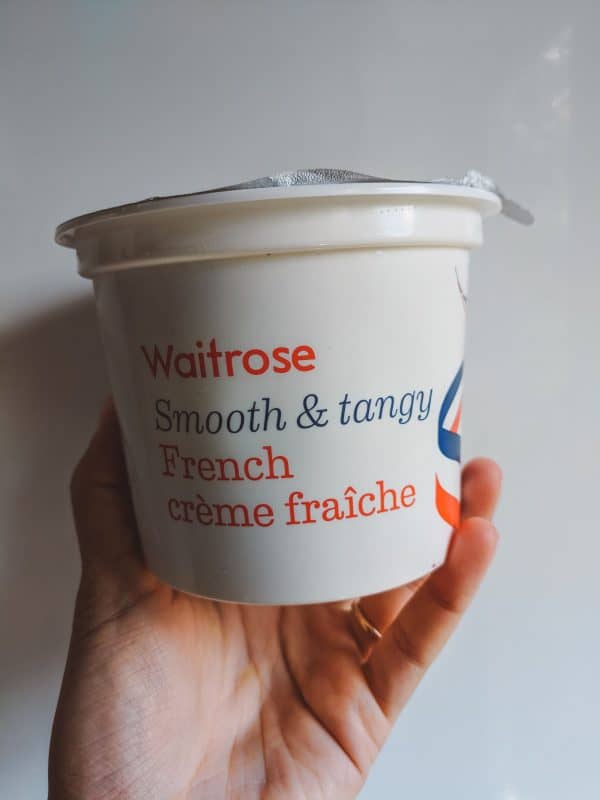
Confit Duck With The World’s Greatest Lentil Recipe
These quantities will serve six people.
Ingredients
- 2 each of onions (such as French pink Roscoff onions), carrots and celery sticks, all finely diced
- 1 fresh bay leaf
- Small bunch of fresh thyme
- 500g green lentils (such a French Puy lentils), cook lentils after they’ve been rinsed under cold water
- 1 litre of good quality vegetable stock
- 6 legs of French confit duck (see above on how to buy them)
- 200g baby spinach, roughly chopped
- Sea salt and freshly ground black pepper
- Red wine vinegar
- Extra virgin olive oil
- Small bunch of fresh flat leaf parsley, roughly chopped (including the stalks!)
- Crème fraîche to serve (optional, exclude to make this lentil recipe vegan)
- French baguette and Brie to serve (optional)
First get your oven up to the right temperate to heat through your confit duck. If you’re heating from frozen, follow the packet instructions. Otherwise, preheat the oven to 200C/400F.
Time to cook lentils!
In a large heavy-bottomed pan, add 1-2 tablespoons of olive oil on a medium heat. Cook the chopped carrots, onions and celery for around 10 minutes until soft, but don’t colour them.
Tie your bay leaf and thyme together into a bouquet garni with a bit of string so you can easily fish it out later.
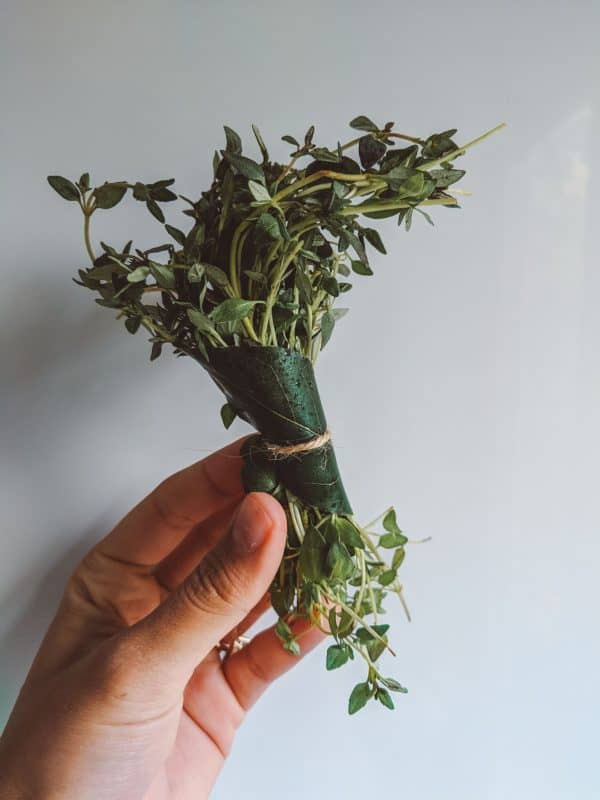
When the vegetables are soft, add the lentils and stir so they’re fully combined. Add the bouquet garni and vegetable stock and simmer for around 45 minutes until the lentils are soft and most of the liquid has been absorbed.
Keep the lid partially on and stir occasionally during this time. If the liquid dries out before the green lentils are cooked, add a splash of water.
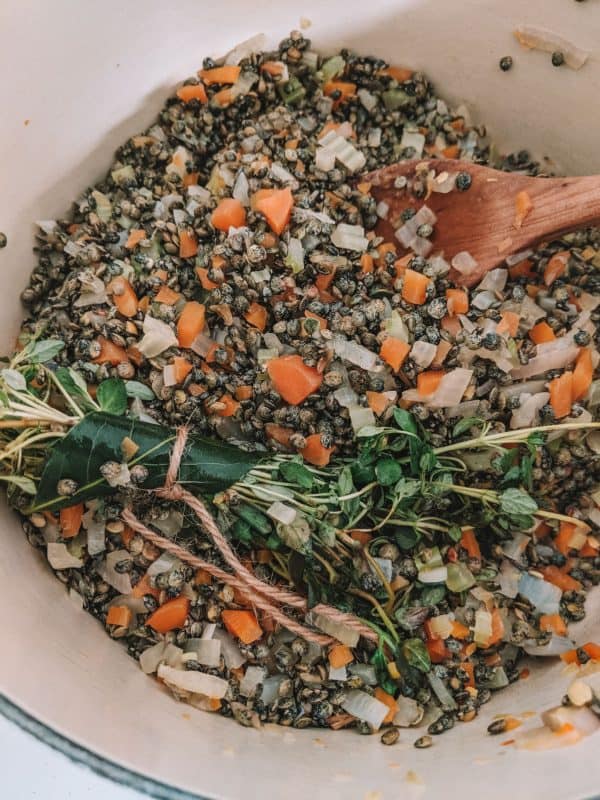
Get those confit duck legs on
In the meantime, put your confit duck legs in a roasting tray and put them in the oven skin side up. Cook them for around 30 minutes (or according to packet instructions); they’re done once the skins are crispy and the meat is hot and tender.
When your lentils are cooked, add the spinach and fully combine. Cook for a couple more minutes until the spinach has wilted.
Remove the bouquet garni and season the green lentils with salt and pepper, a good glug of extra virgin olive oil, one or two tablespoons of red wine vinegar and most of the chopped parsley. Give everything a good stir, taste and adjust the seasoning accordingly.
You want the lentils a little heavy on the acidity which will match with the rich duck meat beautifully.
Time to plate up your duck with this gorgeous lentil recipe
Once the duck is cooked, remove them from the roasting tray and let them sit on some kitchen paper for a minute to absorb any excess fat.
Serve up the lentils in warmed bowls. At this stage you can add a generous spoon of crème fraîche if you wish, use a fork to swirl it through the lentils. Sprinkle the remaining chopped parsley over each bowl and then top with a duck leg.
Serve with some warm French baguette and a few hunks of French brie if you’re feeling extra fancy. Bon appetit!
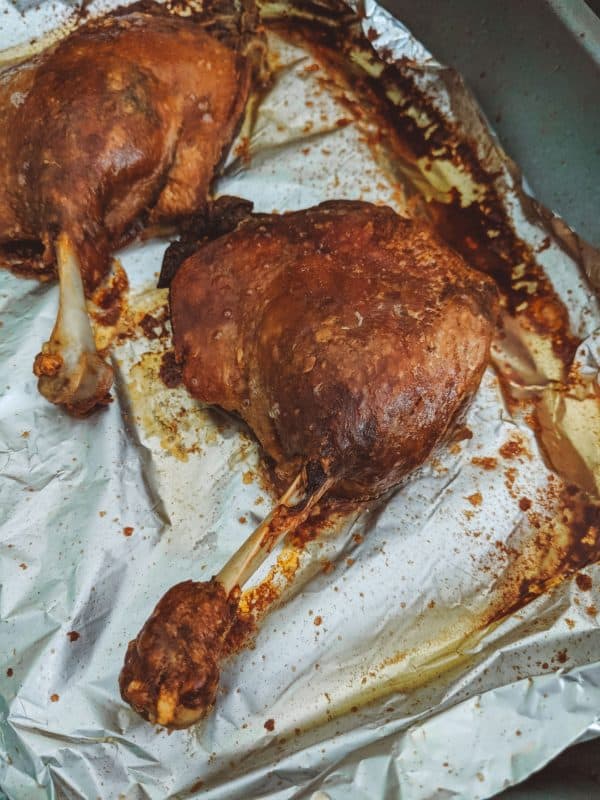
Do you ever cook lentils? If so, what’s your favourite lentil recipe? Have you ever shopped for confit duck before and how did you find it? What’s your favourite way of eating green lentils? What do you usually eat duck with if you cook it at home? I’d love to hear your thoughts in the comments below!
Hungry for more recipes? Check out the cooking section of my blog or go direct to some recipes below.
- Pomegranate slow-cooked lamb shoulder
- Pasta with chestnuts, mushrooms and a parsley pesto
- Mumbai’s vada pav with chutneys and a fried egg
- Vegetarian vine leaf dolma stuffed with rice and herbs
- Almond and thyme-crusted macaroni cheese muffins
- Chicken and spinach curry with coriander chapatis
- Roast red pepper, spinach and goats cheese tart
- Gordon Ramsay’s sticky ribs with spiced marinade
Spending most of my time either eating or travelling. Constantly in awe of nature and on a mission to seek the joy in every moment. Please feel free to leave a comment below, I love hearing from you all!
Find me on: Web | Twitter | Instagram | Facebook
13 Comments
This was fantastic! I cooked duck confit sous vide so I used the duck jus that was rendered out instead of veg stock. Even hubby who doesn’t like lentils had a second helping
Aww so pleased you enjoyed it Lynn, thank you!
Lost you on my phone, but found it! Making your lentils.
Woo hoo, let me know what you think!
I made this once before and it turned out really lovely. Now planning to cook this for a dinner party and so I’m wondering: could this be prepared ahead of time, where you’d cook the lentils part of the way and finish them on the day? If so what would you recommend?
This is so wonderful to hear Ruben! Yes most definitely – you could cook the lentils right until the end in advance and store in the fridge. Then warm up in a heavy bottomed pot until piping hot throughout and serve as it says in the recipe. You may need to add a splash of water to loosen up if it’s needed. And check for seasoning once again before serving.
Wonderful recipe that I am looking forward to making later this month Can shallots be substituted for Roscoff onions? If not, can you suggest a suitable onion available in the US? Also, one of the photos of the finished dish appears to have slices of potato in it; is that a variation of the dish or are the larger white chunks something else?
Hi Elizabeth, thank you so much! That is a very good question regarding the potatoes… I think they are potatoes, but I have no recollection of them. I can only put it down to the two photos side by side being taken from two different times I made the dish, and for one of them I must have added potatoes..! But you can just ignore them and stick to what’s in the recipe. As for the onions, yes certainly you can replace Roscoff onions with any type of onions – shallots will be great. Do let me know how it goes!
Making this on Saturday Leyla! Cannot wait. I might add some diced lardons or bacon to the lentils too. Now need to go shopping for a nice full bodied red to go with.
Leyla, is it two whole onions, two carrots, and two stalks/ribs of celery?
Yes that’s right Lynett, sorry for listing it weirdly!
Bookmarked this for the lentils – I just brought a whole load of duck confit back from the Dordogne!
Haha most excellent. In which case, your future dinner plans are sorted! (I’m coming over)
Leave a Reply Cancel reply
Your email address will not be published. Required fields are marked *
Website URL

IMAGES
COMMENTS
1. Combine salt, shallot, garlic and thyme in a bowl. 2. Place duck in a single layer in a non-reactive dish, scatter salt mixture over and rub well all over duck. Cover with plastic wrap and refrigerate for at least 12 hours. 3.
Heat fat in pan: Place pan on the stove over medium-high heat. Heat fat until bubbling energetically all across the surface (ie not just around the edges). Cover with paper: Turn off stove. Cover surface with baking / parchment paper, cut to size so it sits on the surface of the fat over the duck.
Lay bag flat on rimmed baking sheet and refrigerate for at least 24 hours and up to 48 hours. When Ready to Cook: Adjust oven rack to middle position and preheat oven to 225°F (105°C). Melt duck fat, either in 3-quart saucier over low heat or in a microwave-safe bowl in the microwave.
Step 2: Rinse and Dry Legs. Once the legs have cured, it's important to rinse and wipe off the cure before cooking. Leaving the cure on the legs will gunk up the duck fat and shorten its shelf-life; it can otherwise be saved and reused for multiple rounds of confit or other recipes.
Heat duck legs over medium-high heat until fat starts to render. When there is about ¼ inch of rendered fat in pan, about 20 minutes, flip duck legs, cover pan with foil, and place it in oven. If you have used two pans, transfer duck and fat to a roasting pan, cover with foil and place in oven.
On a cutting board chop your garlic and pour the table salt on top. With the flat of a chef's knife press and scrape the garlic until a thick garlic paste forms. Place duck legs in a non-reactive dish. Sprinkle with garlic mixture, peppercorns, sea salt, and bay leaves. Rub the mixture all over the duck until it is well-coated.
Toss the duck legs with salt, peppercorns, thyme, onion, and garlic in a large bowl. Cover with plastic wrap and refrigerate for three (3) days. Preheat the oven to 250°F (120°C). Rinse the legs and discard the salt mixture. Place the duck in a large Dutch oven and cover with 1 inch of the duck fat.
How to Make Duck Confit. Add the duck legs to a 13×9 casserole dish and season both sides with coarse salt and cracked pepper. Next, rub in 4-5 thyme sprigs, ½ crushed bay leaf, and 1 smashed garlic clove into the flesh side of each duck leg. Flip the duck over and repeat the process entirely to each duck leg.
Let them cure in the fridge for 24 hours. Rinse off the salt and pat the duck legs dry. Preheat your oven to 200°F (93°C). Place the duck legs in a deep baking dish and cover with the duck fat. Cook the duck legs in the oven for about 6 hours, until the meat is tender and pulls away from the bone easily.
First, rinse the duck legs and then pat dry. Combine the salts and aromatics. Add the duck legs to a large zip-top bag and pour in the salt mixture. Rub the legs to coat. Transfer to the refrigerator to cure for 24-36 hours. Remove duck legs from curing in the refrigerator. Rinse and pat dry.
Rub duck legs with salt, peppercorns, and coriander. Add garlic, thyme, rosemary, and bay leaf. Cover and refrigerate overnight. Cook: Preheat oven to 275°F (135°C). Melt duck fat in an ovenproof pot. Submerge duck legs in fat. Cook in the oven for 2-3 hours until tender.
Cook the potatoes in boiling salted water until tender, about 20 minutes. Mash the potatoes, add butter, crème fraîche, salt and pepper. Mix well. Cut the shallots into thin slices, crush the garlic, in a frying pan heat the duck fat then add the shallots and garlic, cook until transparent. Add the duck meat and parsley.
Time to cook lentils! In a large heavy-bottomed pan, add 1-2 tablespoons of olive oil on a medium heat. Cook the chopped carrots, onions and celery for around 10 minutes until soft, but don't colour them. Tie your bay leaf and thyme together into a bouquet garni with a bit of string so you can easily fish it out later.
To. Departure Date. Search tickets. First departure 18:13. Last departure 20:48. Trains per day 3. Price from 35.81 $. Fastest journey 4h 04m. Distance 170 km.
Sochi. Sochi is one of the southernmost places of Russia and the second-largest city of Krasnodar Krai, with a population of 425,000. It's along the Black Sea coast, about 1600 km south of Moscow. Map. Directions.
Sochi is one of the southernmost places of Russia and the second-largest city of Krasnodar Krai, with a population of 425,000. It's along the Black Sea coast, about 1600 km south of Moscow. Photo: Георгий Долгопский, CC BY-SA 3.0. Photo: Niklitov, CC BY-SA 4.0.
The developing ports Caucasus, Temryuk and Yeysk process ship with cargo capacity up to 5 thousand tons. The ports of Sochi, Anapa, Gelendzhik are located in recreation zone and, mainly, they operate the carriage of passengers. Cargo turn-over of the seaports of Krasnodar area double increased in the last 5 years and in 2005 it was 147 mln. tons.